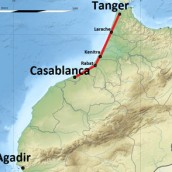
High-speed train between Tangier and Casablanca tests started
1 Feb 2016
The national railways (ONCF) announced on January 19 that it would open the “dynamic testing” of the first Moroccan high speed train. Tests spread over several months and take place on the traditional line between Tangiers and Casablanca. The TGV is equipped with a laboratory where the railway experts and civil authorities consult with measurements taken by the onboard instruments. This train was received last June in Tangier, where it was subject since that time to static testing in the maintenance workshop inaugurated in September 2015, by H.M King Mohammed VI and the French president François Hollande. While the work of the TGV linking Casablanca to Tanger is progressing, the Moroccan Railways (ONCF) has already started thinking about the south extension of the high speed line from Casablanca to Agadir, which implies the realization of a new non-existent section between Marrakech and Agadir, according to the Morocco newspaper “Aujourd’hui”. ONCF has already launched preliminary studies to assess the feasibility and economic viability of the new segment. The ONCF conducted a first field study and passengers survey.Today, a Casa-Agadir travel by highway requires almost 5 hours at a cost approximately 60 USD, including toll costs. For those who choose the ONCF, namely a train then a bus between Marrakech and Agadir, the ride costs around 18 USD in first class, but requires 9 hours. Air is obviously the fastest but it is also the most expensive: the trip only lasts 3 hours in all but costs at least 80 USD (departing from Casablanca). The success of a new high speed line between Casablanca and Agadir assumes that its price is more attractive compared to the aircraft for a same duration of trip. The difficulty for ONCF will therefore be to find a balance between the need to offer attractive prices and the profitability of an infrastructure that will cost at least 2 to 2.5 billion USD. During a parliamentary session, the Minister of Transport said that the work of the high speed line connecting Tangier to Casablanca are finalized at 70% for a service in 2018. And to add that the Morocco ranked in first place at the African and Arab level in terms of railway infrastructure and the 55th row at the global level. To be noted that one viaduct of this Moroccan high speed line, called viaduct “El Hachef”, will be after completion the world’s largest train viaduct, said Mohamed Rabie Khlie, ONCF CeO. This viaduct extends over 3.5 km between Asillah and Tangier, North of the Morocco. The high-speed line connecting Casablanca, Tangier, is also the largest high-speed railway project in Africa
Source: http://menarailpost.com - Photo: by Rami75013 – Wikimedia Commons
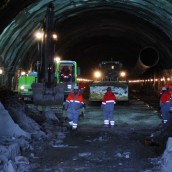
Major infrastructure project to improve safety and frequency of freight and passenger traffic between Ukraine and EU
1 Feb 2016
Ukraine is moving an important step closer to Europe with the completion of the tunnel tube for a new transport connection under the Carpathian Mountains in the south-west of the country. The so-called Beskyd tunnel is being built by the Ukrainian construction firm Interbudmotazh and financed by a US$ 40 million loan provided by the European Bank for Reconstruction and Development (EBRD) and a parallel loan worth €55 million from the European Investment Bank (EIB). The new double-track tunnel is set to replace the old single-track one, which was commissioned exactly 130 years ago, when the region was part of the Austro-Hungarian Empire. The new tunnel will remove a major bottleneck in the European transport corridor V that links Ukraine with The European Union, by almost quadrupling capacity from the current 12 trains per day to 46 trains on completion of the tunnel.
The structure will be seismically stable and 1,765 metres long, 10.5 metres high and 8.5 metres high. The construction will require 130,000 tonnes of concrete and 8,000 tonnes of steel. The tunnel is expected to be fully operational by the end of 2017 or early 2018 and significantly reduce journey times between Lviv (in Western Ukraine) and Chop (near the borders of Hungary and the Slovak Republic). Sevki Acuner, EBRD Director for Ukraine, said: “This is a very important project for Ukraine and Europe. Modern transport links will boost cross-border trade and cooperation, and bring people and businesses closer together. Better access will also allow the region to realize its potential as a destination for tourism and investment”. Corridor V is one of the ten Pan-European transport corridors, defined in Crete in 1994; it runs from Venice and Trieste (Italy) v ia Ljubljana (Slovenia) and Budapest (Hungary) to Lviv (Ukraine). The Beskyd tunnel is the first railway infrastructure project in Ukraine to which the contractual framework standards of the INternational Federation of Consulting Engineers (FIDIC – Fédération Internationale Des Ingénieurs-Conseils) as well as the procurement policies of the EBRD were applied. It has become an important industry benchmark for transparency and efficiency. The EBRD is the largest international financial investor in Ukraine. As of 1 January 2016, the Bank had a total cumulative commitment of approximately €12 billion in 355 projects throughout the country. Last year alone the EBRD signed 30 transactions in the country for €1 billion.
Source: http://www.ebrd.com/news - Photo: ©EBRD/Anton Usov
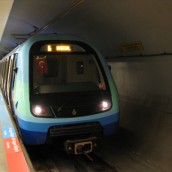
Mayor of Istanbul welcomed address at SmartRail Eurasia
1 Feb 2016
Dr. Kadir Topbaş ,the Mayor of Istanbul Metropolitan Municipality, welcomed address at SmartRail & Metro Eurasia, that took place last 26-27th January in Istanbul. He officially opened the landmark two day event. A trained architect and strong supporter of public transport, Dr. Topbaş, welcomed delegates attending the event from across the region and explored plans for the development of the city’s growing transport networks. With rail and metro in Eurasia undergoing a rapid period of modernization, signalling, telecommunications, rolling stock and IT technology are all the subject of significant investment. Turkey alone will be allocating $46 billion to rail and metro investment by 2023. And in response to this growth, SmartRail Eurasia will bring together the leading organizations and individuals shaping the rapid development of public transport in the region. Alex Williamson, Manging Director of Global Transport Forum, the organizer of SmartRail Eurasia stated; “We were honoured to welcome Dr. Topbaş as a speaker and his presence showed the importance of public transport development within the region, and the focus which Eurasia’s leaders place upon it. It was a fascinating, engaging and important event in the industry calendar”. Dr. Kadir Topbaş joined fellow high-level speakers including Fatih Turan (General Manager, AYGM, Ministry of Transport), Sönmez Alev (General Manager, Izmir Metro), Necmettin Tahiroglu, (General Manager, Ankara Metro, EGO), Halil Korkmaz (General Manager TCDD Region 1), Renata Susa (President of Management Board, Croatia Railways), Libor Lochman (Executive Director, CER), Asghar Bahramali (Project Director, Iran Railways) and many more. SmartRail and Metro Eurasia took place in Istanbul, Turkey on 26-27th January at the Radisson Blu Şişli hotel. This event was a unique business and development platform covering the entire value chain within Eurasia’s leading authorities, rail and metro operators, international contractors and solutions providers.
Photo: by Ex13 Wikimedia Commons
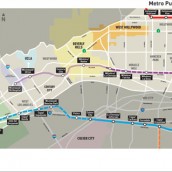
Ansaldo STS Awarded LA West Side Extension
1 Feb 2016
Ansaldo STS awarded 31.5 million USD contract for new Signalling and Train Control system for LACMTA Ansaldo STS (ASTS) – on December 31st 2015 – was awarded a 31.5 million USD contract to design, furnish, test and commission a Signalling and Train Control (S&TC) system for the Los Angeles County Metropolitan Transportation Authority (LACMTA) West Side Subway Extension. The extension will be approximately 3.9 miles from its current terminus at Wilshire/Western Station to a new Wilshire/La Cienega station and will include a total of 3 new stations. The new system will be designed to ensure the safe and efficient movement of trains along the extensions’ mainline and interlocked tracks. This system will meet these requirements through the implementation of Automatic Train Protection (ATP) functions and support of Automatic Train Operation (ATO) and Automatic Train Supervision (ATS) functions. The new system will also employ Train-To Wayside Communications (TWC). Stefano Siragusa, CEO of Ansaldo STS said: “This contract win exemplifies furthermore Ansaldo STS’s competitive position in the US market and highlights the company’s commitment to delivering quality leading edge products and services to its customers”. Ansaldo STS is a leader in the global rail market, with over a century of experience in developing and supplying leading edge technologies in the Americas, Australia, and around the world.
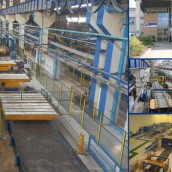
Wegh Group acquires the OLMI Sleeper Technology line of business to complete their technological offer for the railway industry
1 Feb 2016
In line with the expansion strategy to widen their product portfolio, Wegh Group acquires OLMI Sleeper Technology line of business from Alfa Laval Olmi.
Wegh Group, announce today the acquisition of OLMI Sleeper Technology line of business from Alfa Laval OLMI expanding their total Know-how thus positioning on the market as the major global leading provider of solutions for the manufacturing of the railway concrete sleepers and turnout bearers.
OLMI Sleeper Technology and SICI represent two excellences in the field: the first one in the Carousel process and the second one in the Long-Line process. Thanks to the synergy of these two historical brands, WEGH Group S.p.A. acquires an international leadership with 97 plants installed and referenced in different environmental and social sectors, such as, Italy, Russia, Mozambico, Germany, Cuba, Spain, Brazil, Saudi Arabia, Uzbekistan, Abu Dhabi, Argentina, Poland, Perù, Iran, Malaysia, India, Boliva, etc.
The acquisition of Olmi Sleeper Technology and the consolidated technology from SICI, complete Wegh experience and expertise as manufacturer of railway sleepers to grant our customers a continuous product and process improvement as well as to assure a dedicated assistance both in terms of quality and quantity of sleepers as well as in terms of expected return of investments.
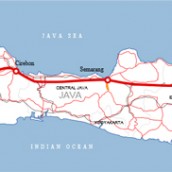
The high speed line between Jakarta and Bandung has started
1 Feb 2016
President of Indonesia Joko Widowo was joined by Jakarta Governor Basuki Purnama on January 21to lay a ceremonial foundation stone in Cikalong Witan to mark the launch of construction of a 142 km high speed line between Jakarta and Bandung. Indonesian officials had agreed last October to proceed with a “business to business” agreement whereby a consortium with 40% Chinese involvement would develop the railway with no financial involvement from the government in Jakarta. Three-quarters of the estimated US$5·5bn cost is coming via loans from China Development Bank, with China Railway International Co Ltd holding a 40% share in the construction consortium. Domestic participants include construction firm Wijaya Karya, toll road operator Jasa Marga and national railway PT KAI. Subject to completion of the land acquisition process, construction of the railway is expected to take three years, with trains planned to start running in the first half of 2019. The current plans would see terminus stations built on the edges of both cities at Jakarta Halim and Bandung Tegalluar, with metro and light rail links to both envisaged under existing urban rail plans. Two intermediate stations are to be built at Karawang and Walini. Trains would run at up to 250 km/h, giving an end-to-end journey time of between 40 min and 60 min. Wijaya Karya has appointed a consortium of engineering consultancy Atkins, architects Aedas and Singapore-based developer Surbana Jurong to design commercial and residential property around the stations as part of a development initiative planned to last until 2030.
Key Points
• The Jakarta-Bandung railway will become Indonesia’s first ever high-speed line; • Critics consider the project an odd choice as existing infrastructure between both cities is relatively adequate (railway and roads) while the route is not that critically important for business; • Indonesia is plagued by inadequate infrastructure (both in quality and quantity) causing high logistics costs while making the country’s investment climate less attractive. It also causes social issues as it limits people’s access to healthcare; • Two listed state-controlled companies are involved in the project: Jasa Marga and Wijava Karva.
Sources: http://www.railwaygazette.com – http://www.indonesia-investments.com - Photo: by Gunawan Kartapranata – Wikimedia Commons
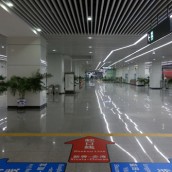
Asia’s largest underground railway station opens for business
1 Feb 2016
Second in the world only to New York’s Grand Central Terminal, Asia’s largest underground railway station, Futian, is now fully operational. Situated in downtown Shenzhen, Guangdong Province, China, the giant complex covers a total area of 147,000 square meters, or about the size of 21 football fields. The opening of Futian, is another landmark in the completion of the Guangzhou-Shenzen-Hong Kong Express Rail Link. The first phase, Shenzen (North) – Guangzhou (South) , commenced revenue operation in December 2011. Now Futian is online, the final phase, connecting Shenzhen-Futian to Hong Kong (Kowloon), is under construction and planned to be completed by third quarter of 2018. According to reports in Hong Kong newspaper, Wen Wei Po, the station cost RMB3.95 billion (HK$4.72 billion). Tickets from Futian to Guangzhou South sell for RMB82 (HK$98) and RMB108 (HK$129) for second class and first class cabins, respectively. The station’s three underground floors will have seating for excess of 3,000 passengers and will be operated by Guangzhou Railway Corporation. The estimated journey time after the construction of corridor will be reduced to 14 minutes between West Kowloon Terminus and the newly opened Futian station, 23 minutes between Hong Kong and Shenzhen North and 48 minutes between Hong Kong and Guangzhou South. According to the new train timetable, there will be 12 pairs of high-speed trains between the Futian Station and Guangzhou South Station running each day.The mainland China section of the high-speed railway is largely complete, but the line connecting into Hong Kong has suffered delays as the total cost of the project has continued to spiral. According to reports in the Hong King Free Press, the total construction cost has risen to HK$85.3 billion, which is 19 percent greater than the last estimate of HK$71.5 billion in 2014 and 31 percent more than the original estimate of HK$65 billion in 2010. There has also been a debate over the presence of Chinese customs officials, carrying out their duties within the special administrative region of Hong Kong. The recently departed MTR Corp Ltd chairman Raymond Ch’ien Kuo-fung stated that “99 per cent” of the delay and extra cost of the Guangzhou-Shenzhen-Hong Kong high-speed rail link were due to “objective environmental reasons.” The MTRCL had previously blamed the delay on complicated conditions at West Kowloon and the geology at the cross-border area beneath a protected wetland. The opening of Futian, Asia’s largest underground railway station is though a major sign that the line is close to completion.
Source: http://www.smartrailworld.com/ - Photo: By 颐园新居 – Wikimedia Commons
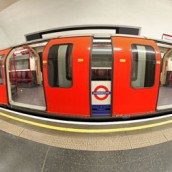
250 new metro trains for the London Underground
1 Feb 2016
London Underground has invited Alstom, Bombardier, CAF, Hitachi and Siemens, which previously pre-qualified, to submit tenders to supply a fleet of 250 trains under its New Tube for London project. A concept design for the new trains was completed in 2014 by Transport for London and design specialist Priestman Goode. The trains will be the first on the deep-level Tube lines, which have a very restricted loading-gauge, to have air cooling. They will have walk-though coaches and wider doors than existing trains. London Underground wants bidders to submit their proposals this summer, and plans to award a contract in autumn 2017 so that the new trains can enter service in the early 2020s. The trains will be deployed on four lines: with 100 trains each for the Piccadilly and Central lines, 40 for the Bakerloo Line, and 10 for the Waterloo & City Line. Introduction of the new fleet together with modernized signalling will increase capacity on the Piccadilly Line by 60% or 21,000 passengers/h, by 35% or 7000 passengers/h on the Waterloo & City Line, and by 25% on the Bakerloo (9000 passengers/h) and Central (12,000 passengers/h) lines.
Source: http://www.railjournal.com
Photo: Transport for London
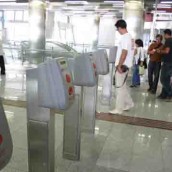
When tickets become smart
1 Feb 2016
We try to give a general vision of the evolution of ticketing from the past through the present and towards the future. Mrs. Montserrat Palasì, Indra’s director of Transports in Europe, helped us in this short but deep analysis
In this short but deep market analysis, Railway Engineering tries to detect the evolution of “ticketing”. To be more precise we see how people bought travel tickets (both in the public and private transport) in the past and which are the most used modern technologies today. Thanks to the help of an expert: Mr. Montserrat Palasì, *Indra’s director of Transports in Europe we give a look of the evolution of the market.
Mrs. Montserrat Palasí, could you please describe us in short the evolution of “ticketing” from the past to the present?
The evolution of the ticketing depends on the point of view of the operator, due to the needs of the transportation in every country/city at a time, and it is closely linked to the natural need of promoting the use of public transport, while making it cost-effective and sustainable. It was first based on manual collection through simple paper tickets, then moved to automatic fare collection with magnetic stripe tickets, featuring longer durability and higher data capacity to support a wider range of transportation services, and nowadays it is resolving around the use of secure higher speed and data capacity contactless smartcards in an interoperable and intermodal environment.
And what about the future of ticketing?
Telecommunications technologies have become one of the most evolving areas of knowledge during the last few decades. Internet and mobile applications have revealed to be both source of a stunning new world of services and commercial possibilities, and a definitive partner to enhance the productivity of companies and entities of all kinds. The transportation sector has not remained oblivious to such changing environment, and is definitively giving the steps towards that clouded and multi-service challenge through complementing, when not just replacing, the current card-centric approach based on the core ticketing logic being stored inside the contactless smartcards or magnetic stripes. With a back-office-centric approach, travel media as smartcards are just account-registered identifiers, and all the business logic to provide seamless door-to-door interoperable and intermodal services resides at the back-office level, drastically reducing front-end equipment procurement, maintenance, and operation costs, while exponentially bursting the business possibilities once the chains of the field hardware limitations are broken. NFC-enabled devices as unique point of service to customers and cell phone payment application with NFC, the use of financial cards as travel tokens, or the implementation of account-based systems, are just a few examples of paradigms that are paving the way for the ticketing sector to reach the future. Other trends are the importance of the intermodality systems for the smart mobility solutions, that allow the combined use of mixed modes of transport; the operator clearing house, etc.
Which means can the Transport Companies use today in order to offer to the consumer a fast, convenience and functional way to buy a ticket?
It is very important for the Transport Companies to offer a way to buy tickets that is secure to avoid fraud, that is fast to increase the volume, that is less expensive to reduce the final price and that is reliable to increase the satisfaction. The application of technology to public transport management improves the service and, the most important, fosters its use.The traditional ticket vending machines or sales ticket offices are still in place, and will be for long time, but mobile-based applications powered with shopping applications connected to the ticketing back-offices are starting to sparkle the transportation systems, and will become essential to access the travel services in the near future.
How is the ticketing market developing in the metro, tram and rail-ways? Are there differences among ticketing in the local, national and international transports?
The systems that these ways of transportation use are very similar in the purpose. The final system implemented depends on the operational and pricing rules they have to follow. Although with plenty of exceptions, the most massive the transportation network is, the sooner it embraces new technologies to achieve its goals in terms of higher revenues, more cost-effective operation, etc. But both the fact that in general technology is becoming cheaper, and the search for interoperability and intermodality offering seamless door-to-door travel products, are making metro, tram, suburban, and bus transit networks to go the same path. Moreover when it comes to talk about the ticketing market development on transportation, it currently makes a difference in favor of short distance transit networks, featuring far more evolved ticketing systems where higher transaction speeds, better cost-effectiveness, and richer business rules, are of the essence. But the already mentioned search for seamless door-to-door services comprising local, national, or international different modes, even those that are not particular to the ticketing sector as tolling systems, is starting to promote the integration of both worlds, short and long distance transportation networks, and will hopefully bring a full and homogeneous transportation ecosystem in the long term.
Which are the most developed Countries in this field? Which are the most advanced Transport Companies in the ticketing offer from a technological, functional and fastness point of view?
Nowadays USA is maybe the most demanding country of ticketing systems based on new mobile technologies, while European countries are mainly focused on knocking down barriers by building up interoperable and intermodal systems. Probably, the Transport Companies of USA and UK are some of the most advanced ones.
Which are the main novelties in this field? Nowadays, the use of the NFC technology and the financial cards are the most requested, but it is true that there are cities with both technologies already implemented.
Mobile ticketing applications, and financial cards used as travel tokens, are two of the most demanded new breaking technologies. Migration from a card-centric to a back-office-centric approach is already in place, and seems to have a brilliant future ahead.
Do you think that the old booking offices will disappear? How do you think the elder travelers could do without the booking office?
Disappearing is maybe an extreme statement, but nowadays there are many transportation companies that are really doing their best to replace those offices by automatic ticket vending machines, and the exponential evolution of mobile ticketing applications in the future will make them to be on the brink of extinction. A main trend of ticketing systems is making life easier to travelers, and elder ones will be able to get used to the new environment pretty straight forward.
by Anna Celenta – Photo by Indra
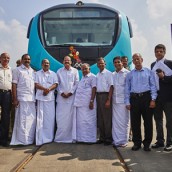
First Metropolis trainset delivered for Kochi Metro Rail
1 Feb 2016
Alstom has delivered last January 2, 2016, ahead of schedule, the first Metropolis trainset to Kochi Metro Rail (KMRL) of the 25 trainsets ordered by Delhi Metro Rail Corporation (DMRC) in August 2014. An official ceremony was held on this occasion at the Alstom’s Sricity facility where the metro was built. Present at the ceremony were Shri. Venkaiah Naidu, Union Minister for Urban Development, Parliamentary Affairs, Housing and Urban Poverty Alleviation; Shri Aryadan Muhammed, Minister for Power & Railways, Kerala; Elias George, Managing Director of KMRL; Mangu Singh, Managing Director of DMRC; Jean Francois Beaudoin, Deputy Senior Vice President, Alstom, Asia Pacific and Bharat Salhotra, Managing Director of Alstom India. This is the first time that a Metropolis trainset was produced at the Sricity facility in India. The 25 trainsets will circulate on an elevated metro rail network that is 25 km long and includes 22 stations. The line is expected to open in June 2016. The unique design of the Kochi metro, unveiled in September 2015, has set a new benchmark in urban mobility in India. The front end features LED lights that are in the shape of elephant’s tusks. As the metro will run on a viaduct, it will lighten the city at night.Speaking on the occasion, Elias George, Managing Director of KMRL said, “It is a big achievement for Kochi metro. These metro cars are manufactured end-to-end by Alstom in India and are delivered ahead of schedule at a record time of 15 months. I would like to take this opportunity to congratulate the teams from Alstom, DMRC and KMRL, who worked hard to make it happen.” “The delivery of the first train set of Kochi metro marks another major milestone for Alstom in India. The project re-affirms our strong commitment and endorsement of the ‘make in India’ initiative of current government. Kochi metro is our second metro contract in the country after Chennai, and with the recent award of the Lucknow contract, we are well geared to serve India. We are proud to be able to contribute to the metro development of the country”. Bharat Salhotra commented. With about 5,000 Metropolis cars sold to over 20 cities, Alstom is one of the largest metro suppliers in the world. Designed to address the specific needs of each city, Metropolis offers a large range of options and configurations, a high level of passenger comfort and innovative features to optimize energy consumption and life cycle costs.
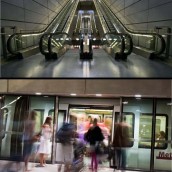
Global experts gather to deliver a vision of the metro network of the future
26 Nov 2015
The rapidly evolving business of delivering metro networks to global cities was the big focus of the 6th annual SmartMetro event, held in Copenhagen from 3rd to the 5th November 2015. The three day event presented hours of expert insight, practical case studies, high-level discussion, interactive workshops and networking for the 250+ delegation that came to Copenhagen from 5 continents. Co-located with the 6th annual CBTC World Congress, the showcase covered topics such as technology integration, passenger management and sustainability while discussing how to place Communications Based Train Control (CBTC) at the heart of smart operation upgrades to improve performance. With our increasingly inter-connected and urbanized world, evolving IT and the digital revolution that give metro systems an opportunity to improve service and meet ever evolving passenger demands were a big focus for the global speakers assembled in the Danish capital. Having focussed on CBTC for the past five editions, this year, the show evolved into the SmartMetro Congress to include all these exciting new areas and more. Global Transport Forum was honoured to have the support of local transport agencies Metroselskabet and Banedanmark who hosted popular site visits for the delegation. Further information and a deep analysis of the speech of the forum on the issue of Railway Engineering.
(Photo: – Copenhagen Metro by Stig Nygaard Copenhagen, Denmark http://www.rockland.dk – trough Wikimedia Commons)

Smartrail Usa: the next generation of technology for national transit operators
26 Nov 2015
The 5th annual SmartRail USA event took place last October in Charlotte, North Carolina. Attracting 400+ visitors across the two days, the congress led exhibition put innovative and new technology at the forefront of discussions on how to build the transportation system of the future. SmartRail USA presented a range of expert case studies, diverse panel discussions, interactive roundtables and networking opportunities to engage and bring together the transit community to share best practice and introduce innovative solutions to the national transport IT issues. Managing Directors such as Leanne Redden (Executive Director, RTA Chicago), Joseph C. Szabo (Executive Director, CMAP) and Keith T. Parker, (CEO, MARTA) shared their strategic insights for their transit agencies. While technical experts such as Dennis Story (Senior Manager, Communication & Control Systems, DART), Thomas Shaw (Manager, ATC Design and Construction, WMATA) and Richard Carter (Manager of Microwave, Norfolk Southern Railway) highlighted technical innovation. The SmartRail exhibitors also highlighted their smart transit innovation in the technical seminar room. Experts from companies such as Axinom, Alcatel Lucent, Lilee Systems, Nomad Digital, BAI Communications and CyberSecurity Analysis showcased their solutions and technology, complimenting the needs of the industry as highlighted in the congress. The annual SmartRail USA Innovation Awards were presented to winners Bombardier for Product of the Year and LA Metro for Project of the Year. Al Martinez, Director, Information Management at Los Angeles County Metropolitan Transportation Authority on winning the award: “We are excited to have received the Project of the Year Award from SmartRail USA. LA Metro is working hard to research new and innovative tools that will improve the customer experience as well as safety for the transit riders of Los Angeles. We believe implementing this new intelligence based surveillance system on our rail fleet will move us closer to this goal. We are grateful for recognizing LA Metro’s efforts with this award.”
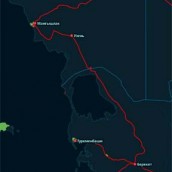
Trilateral meeting among the vice presidents of Iran-Kazakhstan-Turkmenistan Railways
26 Nov 2015
During numerous trilateral meeting among the railway authorities of Iran, Kazakhstan and Turkmenistan the existing obstacles were discussed. Fibally, a trilateral meeting among theDeputies of the said three railways was held last October in Tehran with an approach to provide facilities for more development of rail transportation among the three countries. There exists a considerable volume of consignment in Kazakhstan which must be carried to through the territory of the I.R. of Iran, the Persian Gulf States and other countries. Accordingly, these three took necessary measures for construction of Gorgan-Incheh Borun-Atrak-Berekat railway in their territory, i.e. around 120 km of the line is located in Kazakhstn, 700 km in Turkmenistan and 85 km in Iran.
(Photo: Svetlov Artem – Wikimedia Commons)
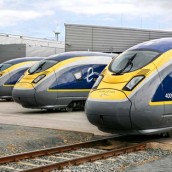
Eurostar E320 enters service
26 Nov 2015
The first of Eurostar’s 17 Siemens-built Velaro e320 trainsets began operating in limited commercial service on November 20, having been authorised for passenger operation through
the Channel Tunnel the previous day. According to Eurostar: “we received the final piece of safety authorization earlier than expected”, allowing the company to put the first train into
traffic on the 10.24 departure from London to Paris. The unit will operate ‘a small number of services’ on this route over the next few weeks in order to ‘fine-tune the onboard service’ ahead
of a formal launch in mid-December. The trains are expected to enter regular service before the end of this year, with all 10 of the first build ordered in 2009 due to be available by May
2016. On test for more than a year, the 320 km/h trainsets were formally authorized to operate in France by French safety authority EPSF on October 16. The final approval for use in
the Channel Tunnel was issued by the Intergovernmental Commission on November 19. As well as operating on existing routes, the e320s are also equipped to run into the Netherlands.
However, Eurostar has delayed the launch of its planned service to Amsterdam from December 2016 until early 2017. Styled by Pininfarina, the 16-car e320 with distributed traction equipment has three cars with premier seating at each end, flanking 10 standard class cars and two buffet-bar areas at the centre of the formation. Each trainset can carry up to 902 passengers.
(Source: http://www.railwaygazette.com – Photo: Siemens AG, Munich/Berlin)
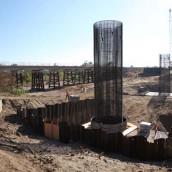
First vertical structure at the Fresno River viaduct
26 Nov 2015
The California High-Speed Rail Authority (Authority) and its design-build contractor Tutor Perini/Zachry/Parsons (TPZP) advanced work on 16 vertical columns that will support the
Fresno River Viaduct. The viaduct is the first vertical structure being built as part of the California High-Speed Rail program. Significant construction work at this site began in June and
most recently, the construction team has been working to build the 16 columns that will support the approximately 1,600-foot length of the viaduct. The Fresno River Viaduct will span from
Raymond Road to Watson Street in Madera County, crossing over the Fresno River and State Route 145, parallel to the Burlington Northern Santa Fe tracks. The viaduct is part of Construction Package 1, the first 29-mile construction area that stretches from Avenue 17 in Madera County to East American Avenue in Fresno County. Approximately 75 people will work on completing this structure, including TPZP subcontractors Moore TwiningA ssociates, Becho, Inc., Landavazo Bros., Inc and Schwager Davis, Inc. with materials being supplied by Martinez Steel Corporation and Outback Materials.
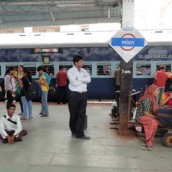
Indian railways doubles cancellation charges
26 Nov 2015
The railways has some bittersweet news for passengers. While it doubled ticket cancellation charges, it reduced the deadline to cancel waitlisted and reservation against cancellation (RAC) tickets to half an hour prior to departure of the train. The changes, which were announced earlier, came to effect on Thursday. The railway has said the move is to make cancellations more convenient to passengers and end black marketing of tickets by touts. The passengers who cancel their tickets even 48 hours prior to departure will lose anywhere between Rs 120 to Rs 300 per ticket. This is against the earlier cancellation charges of Rs 60 to Rs 150 per ticket. “While clerkage levied for cancellation has been raised from Rs 30 to Rs 60 for any
reserved class, cancellation charges have gone up from Rs 120 to Rs 240 for first air conditioned executive class, Rs 100 to Rs 200 for second class air conditioned coaches, Rs 90 to Rs
180 for third class AC coaches and Rs 30 to Rs 60 for second class tickets”, stated the press release from the railways. Even clerkage charges for cancellation of unreserved tickets has gone
up from Rs 15 to Rs 30.
(Source: http://timesofindia.indiatimes.com –Photo by World 8115 – Wikimedia Commons)
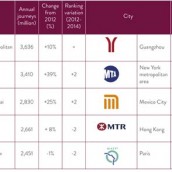
Asian cities dominate ranking of the world’s biggest and busiest metros
26 Nov 2015
This is what emerges from a new report from UITP, the International Association of Public Transport. The report, “World Metro Figures”, is a comprehensive study on the current state of the world’s metro networks and highlights potential future developments. The report shows that in 2014, 156 cities around the world had a metro system in operation, nearly two thirds of which were in Asia and Europe. The world’s busiest metro network is the Tokyo metropolitan area, with almost 3.6bn passenger journeys per year, a 10% increase compared to 2012. Chinese metro systems have also enjoyed significant growth and Beijing (3.4bn, +39%) and Shanghai (2.8bn, +25%) are 2nd and 3rd respectively. Rounding out the top five are Seoul (2.6bn, +8%) and Moscow (2.4bn, -1%). Metros carry over 160m passengers per day (+7.9% compared to 2012), nearly half of which are in Asia. Asian cities are also on top when it comes to the world’s longest metro networks, with the Chinese cities of Shanghai and Beijing boasting 548km and 527km of lines respectively, while London rounds out the top three with 436km. In 2014 alone, more than 500km of new lines were added in cities around the world.
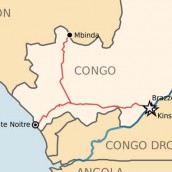
A new MoU between Italy and Congo
26 Nov 2015
A new training and support agreement was signed by the Italian Ferrovie dello Stato (FS) and Chemin de Fer Congo-Ocean (CFCO), the main railway company of the Republic of Congo. The memorandum of Understanding was signed at Palazzo Chigi at the presence of the Italian Prime Minister Matteo Renzi, and the President of the Republic of Congo, Denis Sassou N’ Guesso. The agreement was signed by Michele Mario Elia, CEO of FS, and Jean-Francois Coutin, CEO of CFCO. The MoU aims to develop cooperation between the two rail groups, especially on topics related to training and technical assistance. The Congolese railway group is interested in training support for the maintenance of the network and the supply of rolling stock
for maintenance. The Italian FS Group will also offer its technical expertise, through Italferr, for the review of the National Transport Plan. Italferr is also monitoring the reconstruction project of the Kintelè district, in Brazzaville, for which Italy and Congo signed a Memorandum of Understanding in July 2014. The FS are also involved in the development of the new railway line between Pointe Noire and Brazzaville.
(Source: © 9Colonne)
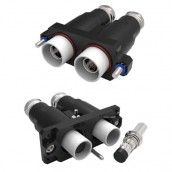
Company Profile: ITT Interconnect Solutions
29 Sep 2015
ITT Interconnect Solutions (ICS), a division of ITT Corporation, manufactures highly engineered, customized electrical and data connectors for the energy, aerospace, transportation and industrial markets. Within ITT ICS, the brand dedicated to the rail sector is Veam. The brand was originally established in 1936 as a manufacturer of screw machined parts, and began producing connectors in 1953. Veam was acquired by Litton Industries in 1969, which was itself acquired by Northrop Grumman in 2001.
Veam was then acquired by ITT in 2003, and in 2007, ITT Cannon Italy & Veam merged into ITT Cannon Veam Italia. The brand
has always focused on understanding challenges unique to specific customers, and designing highly tailored connector solutions to meet those specified needs.
What is your mission?
First and foremost, our mission is to enable the safe and reliable mobility of people, goods and equipment. We do that by providing electrical interconnects that allow rail equipment – primarily rolling stock, its subassemblies and components – to operate effectively in harsh environments over long lifetimes. We have always made it a priority to offer our customers complete, globally leveraged customization based on their unique needs, working with unique mechanical, electrical and form factor requirements. From design to manufacturing and distribution, we take great pride in delivering highly tailored interconnects that are reliable, cost-effective and created from the ground up to address specific customer challenges.
What is your specialization?
Our core business at ITT Veam is designing and producing robust interconnects for the transportation and industrial markets – including high speed, freight and passenger rail applications, nuclear power plant control systems and a full range of heavy vehicles. Applications include bogie, inter-vehicle, coupler, data communication, internal car, and railway infrastructure connectors.
Our engineers have a reputation for designing interconnects that function under tough conditions of vibration and shock, and that provide long-lasting performance through exposure to snow, sleet, rain, hail and other harsh environmental stressors including corrosion and pressure. Our connectors play an integral role in the infrastructure and electrical control functions in current and next-generation railway systems, performing in on-and off-board applications and providing reliable connections for electrical and data signals. We engineer our solutions to withstand the harshest environments – especially undercar, coupler and inter-vehicle connections, which are often exposed to the elements over the course of years. We also offer our clients a range of value-added services including harnessing, cable assemblies, customized junction boxes and jumper cables.
Can you list and describe your brands?
We have two brands focused on the transportation and industrial markets – Veam and Cannon. While the majority of rail solutions fall under the Veam brand, some of our connectors for industrial applications and electric vehicles are also included in the Cannon portfolio. The Cannon brand, which celebrates its 100th anniversary this year, produces interconnects for aircraft – military and commercial – hospitals operating sophisticated automated equipment, heavy and off road vehicles, and film, TV and audio production equipment. Together, the brands cover a range of industries for ITT, including space, aviation, defense, handheld devices, industrial, transportation and medical. Our third brand, BIW Connector Systems, is focused on electrical connectors for the energy market, predominantly in upstream energy production. Veam and Cannon have a history of dedication to innovation in the rail market, and offer a broad range of electrical and optical interconnect solutions that support automotive markets, rail vehicles, engine diagnostics, brake controls, environmental conditioning, electromechanical, electrical, computer and entertainment systems.
Which are your foreign markets?
ITT Corporation is an American company headquartered in New York, but we are a company with a truly global footprint. ITT’s Veam brand has a regional manufacturing presence in Lainate, Italy, Shenzhen, China and Nogales, Mexico. These facilities along with our design, sales, and distribution facilities on all three continents, serve our growing North American and Asian markets, while supporting existing customers in Europe. The Lainate plant provides high quality and reliable products combined with local customer support to serve the European region and support the global market. As the rail market becomes more consolidated and global, the need to offer solutions applicable across all regions is intensifying. To offer just one example, Chinese rail car manufacturer China Railway Rolling Stock Corp and the U.S. state of Massachusetts recently announced that the Chinese firm would open an assembly plant to supply railcars for the Massachusetts Bay Transportation Authority. We are keeping our finger on the pulse of the global shift underway in this market, and have the infrastructure and capabilities in place to continue offering our customized solutions on a global scale.
Where are you working on at the moment?
We have large ongoing projects in Europe, North America and China, and work closely with rolling stock Original Equipment Manufacturers (OEMs) as well as Tier 1 suppliers to the rail industry to provide connectors that continually push the boundaries of performance, endurance and reduced environmental impact. Our highest performance connectors are for high-speed trains that travel up to 400 km per hour. In Europe, ITT Veam connectors serve 25 million passengers per year in multiple metropolitan and inter-European rail applications. Our connectors also support underground metro systems in the three mentioned regions. Working closely with industry technicians, we have developed ceramic heat-resistive inserts, Restriction of Hazardous Substances (RoHS) compliant corrosion-resistant conductive platings, flame retardant insular materials, connectors that integrate power, signal and data lines within a single unit, field configurable circular connectors, high temperature connectors, and shielded solutions for data transmission that bundle Ethernet, WTB, MVB and video lines in one connector.
A Collaboration with Alstom for the 2016 Summer Olympics in Brazil
Alstom asked ITT Veam to develop a custom connector to enable their regenerative power system, Ecopack, to effectively harness power generated by braking and store it in on-board batteries. Alstom was looking for a highly tailored rail solution offering high performance, safety and reliability in a very limited amount of space. They needed a connector that would enable energy generated during traction and braking to flow to the tram’s supercapacitors. Alstom asked ITT to engineer a high-performance, compact connector rugged enough to deal with tough conditions yet safe and easy to disconnect for servicing and maintenance. The result was the Veam Power Plate connector. This multi-pole interconnection system is suited for high power applications and can withstand harsh environments while delivering power dependably. Power Plate is critical to the success of Ecopack. By connecting the power equipment – which collects energy during breaking – with supercapacitors on the roof of the vehicle, Power Plate ensures that energy flows unimpeded to power the tram, and that the tram uses one third less energy than traditional systems. Power Plate features a double screw latching mechanism that provides a fast connect and disconnect capability, meets railway standards on smoke and fire protection, and saves space due to its unique receptacle and plug dimensions. The first of the 32 Alstom Citadis trains was delivered to Rio de Janeiro in June. And with Veam Power Plate having proved its effectiveness, Alstom has announced the regenerative power system will become a standard on all Alstom trains operating without catenary power.
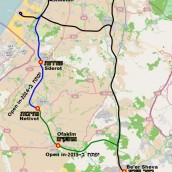
Officially opened the Ashkelon – Beer Sheva line
28 Sep 2015
The Israeli prime minister Mr Benjamin Netanyahu, together with Israel’s transport minister Mr Israel Katz, and Israel Railways’ general manager Mr Boaz Zafrir, officially opened the 70km Ashkelon – Beer-Sheva line on September 17. Public services on the double-track line started two days later on September 19. Israel Railways is operating 25 trains per day in each direction, with two trains per hour during peak periods. The journey time is 50 minutes with trains calling at Shderot and Ashkelon, and from December at Ofakim. To stimulate traffic, the government has agreed to allow passengers from Shderot, Netivot, and Ofakim a 50% reduction on rail tickets to any destination in Israel.
The project
The railway line from Ashkelon southwards, including linking it up with the Lod – Na‘an – Be`er Sheva Line and construction of new stations at Sderot, Netivot and Ofakim. The project involved the construction of 3 road bridges, 18 railway bridges, 4 grade separations, 11 agricultural crossings, and 48 culverts; the numerous infrastructures disposed along the route were also to be attended to by means of protective shielding or relocation. The project was divided into two main sections: Ashkelon – Netivot, and Netivot – Be`er Sheva. The Ashkelon – Yad Mordechai portion of the Ashkelon – Netivot Section was laid in double track formation; the remainder as far as Netivot was constructed as a single track line with an infrastructure suitable for double tracks. The Netivot – Be`er Sheva Section was laid in single track formation with infrastructure elements ready for future track doubling.
Route length: 60 km.
Expected journey time: Approximately 47 min. from Ashkelon to Be`er Sheva.
Peak hour service frequency: 2 trains in each direction.
In the future—4 trains in each direction (73 trains per day).
Sources: http://www.railjournal.com – http://www.rail.co.il
Photo: by Highlighted rail lines and stations added by משתמש:בן-ציוןממ English labels added by Atefrat – Wikimedia Commons

12 more trains to boost capacity of North-South and East-West lines
28 Sep 2015
The Land Transport Authority (LTA) has awarded a contract worth approximately S$136.8 million to Kawasaki Heavy Industries, Ltd/CSR Qingdao Sifang Co. Ltd/Kawasaki Heavy Industries (Singapore) Pte. Ltd. Consortium for the purchase of 12 new six–car trains for the North-South and East-West Lines (NSEWL). These 12 trains are the final batch of the 57 new trains that will be put into service from 2016 to 2019. The first of these 12 trains will arrive in Singapore in early-2018, and will undergo testing at the NSEWL depots before they are put into service around the middle of 2019. These NSEWL trains will be the first trains to feature tip-up seats that will provide additional flexibility in seat configuration. The trains will also come with commuter-centric features such as three rows of straphangers and triplicated grab-poles for standing passengers. Commuters can also refer to the Dynamic Route Map Display located at the top of each door for their current location, route information and the side the train doors will open at the next station. Kawasaki Heavy Industries, Ltd. has been in the railway manufacturing industry for over a century. Besides supplying trains in the Japanese domestic market, Kawasaki’s existing overseas projects include metro trains for the New York City Transit Authority and the Washington Metropolitan Area Authority. In Singapore, Kawasaki has supplied most of the trains on the NSEWL. Its first delivery was for the inaugural fleet of 66 six-car trains in 1986, with additional fleets of 56 trains delivered in 1999, 2011 and 2013. CSR Qingdao Sifang Co. Ltd has a history of cooperation with Kawasaki dating back to 1985. Since then, the two companies have worked on several joint contracts of linear motor MRT trains for Guangzhou Metro Line 4 and 5 and of high-speed trains for the Ministry of Railways of China. The Consortium is currently in progress of delivering 91 trains for the Thomson – East Coast Line.
More New Trains on Rail Network
From the start of this year to 2019, 99 more trains will be added to the NSEWL, North East Line (NEL) and Circle Line (CCL), increasing the overall train fleet size by close to 50%. This includes the 57 new trains for the NSEWL which will enter service from 2016. For the CCL, 12 new trains would have joined the CCL’s existing fleet of 40 trains by the end of 2015[2]; while four new trains would also have been added to the North East Line’s (NEL) fleet of 25 trains. By the end of 2016, all the 42 new trains for the CCL and NEL would be fully deployed
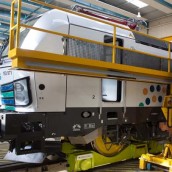
PKP CARGO develops a modern fleet for Europe
28 Sep 2015
PKP CARGO shall purchase 15 multi-system locomotives from the Siemens Group. These locomotives are intended for PKP CARGO trains in Poland and six other states of the European Union. Siemens will supply the locomotives to PKP CARGO starting from January 2016, with the last one to be delivered in 2017. The contract signed between the parties contains the option of fixed-price purchase of another five engines, which will be decided by PKP CARGO by the end of 2017. The multi-system locomotives enable smooth freight between the countries with different power systems. The contract was signed in the course of the International Railway Fair held in Gdansk. The contract value amounts to net EUR 75 million (app. PLN 315 million). “This is our greatest investment in rolling stock in long-time perspective and one of the largest tender procedures of such type in this part of Europe. After the acquisition of the Czech AWT we made another step towards building the international position of PKP CARGO and strengthening of our presence in the neighbouring countries. The multi-system locomotives are a cutting edge rolling stock making our offer of international freight even more competitive for the Polish and foreign Clients” –says Chief Executive Officer of PKP CARGO Adam Purwin. The multi-system locomotive is adapted for operation under the different power systems without the need to stop the train. It enables seamless operation of transborder transport in the countries with different rail network voltages. This solution enables freight from Germany to Hungary via Poland, Czech and Slovakia with a single locomotive and a single carrier.
The first Vectrons in January 2016
The first three from 15 new machines will be delivered to the rolling stock park at the end of January 2016, whereas the three subsequent ones a month later. The last engines (approved for seven EU Member States) will be supplied at the end of 1H 2017.To this moment, PKP CARGO had only one multi-system locomotive and the remaining ones were leased (operating lease). Such solution enabled rapid and flexible responding to the fluctuating freight conditions and allowed for obtaining the safety certificates abroad. At present, PKP CARGO implemented the stabilized level of multi-system locomotives use. In such conditions, purchase is the most favourable option, enabling more effective price competition with the foreign carriers. PKP CARGO is the largest rail freight carrier in Poland, with market share exceeding 56% in terms of transport performance (1H 2015). Rail freight of imported or exported goods generates more than 40% of transport performance of PKP CARGO. Apart from rail freight, the PKP CARGO Group acts also as a forwarder and terminals and sidings operator. Its other activities cover also repairs and maintenance of the rolling stock.
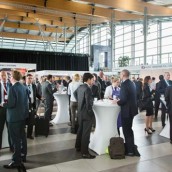
Winners announced for SmartRail USA Innovation Awards 2015
28 Sep 2015
The votes have all been counted and the winners of the inaugural SmartRail USA Innovation Awards 2015 have been confirmed. After a three month process this nationwide search for the most innovative new products and solutions for the transit (rail, metro and bus) industry in North America we finally have the winners. Both of whom will receive their awards at SmartRail USA Congress & Expo in Charlotte on October 28th. So who has won what? And who came in as runners up and highly commended after thepanel of judges voted?
Bombardier took the Product of the Year title with their YardSafe state-of-the-art engineered safety solution which provides improved location awareness for workers in rail yards and maintenance facilities. Speaking on the confirmation of their win Mark Willer, Product Manager, Technology Systems at Bombardier: “We are extremely pleased to have been selected by the SmartRail judging panel as the winning entry for Product of The Year for 2015. Bombardier’s Technology Solutions team is dedicated to developing and delivering systems that add real value and improve safety in the rail transit industry. We believe this award is a reflection of our team’s vision for the innovative application of technology and our commitment to achieving these goals. We would also like to recognize our colleagues in Bombardier that supported UP Express. Our team of Train Operating Crews, Guest Service Representatives and Maintenance teams along with their related management teams are thrilled to be a part of and to deliver such a world class link between Pearson Airport and Toronto’s downtown core”.
The Project of the Year title was secured by Los Angeles County Metropolitan Authority (LA Metro) with their new intelligence based surveillance system being implemented as part of a 30 year rail transit expansion. Al Martinez, Director, Information Management at Los Angeles County Metropolitan Transportation Authority on winning the award: “We are excited to receive the Project of the Year Award from SmartRail USA. LA Metro is working hard to research new and innovative tools that will improve the customer experience as well as safety for the transit riders of Los Angeles. We believe implementing this new intelligence based surveillance system on our rail fleet will move us closer to this goal. We are grateful for recognizing LA Metro’s efforts with this award”.
One of the panel of judges Jim Allison, Planning Manager, Capitol Corridor Joint Powers Authority (CCJPA) on the final voting said: “It’s a testament to the industry that there were so many high quality entrants across a wide variety of diversity of applications. It was not easy to pick the most transformational projects”. Whilst another judge, Paul C Worley, Rail Division Director, North Carolina Department of Transportation added: “I enjoyed being a part of Smart Rail’s competition for new technology in the rail industry. It was very interesting and rewarding to review the various new approaches to making rail operations safer and more efficient”. The winners will receive their awards at a ceremony at SmartRail USA Congress and Expo in Charlotte, North Carolina 28-29th October 2015. SmartRail USA is the only show dedicated to driving innovation in passenger rail in North America and is free to attend.
Award Details
Product of the Year identifies the best and most innovative products in the rail industry. Hardware or software, it can be a new product, an update of an existing solution or an improved way of utilizing current technology that will improve our industry. The focus can be large or small but the product and the improvement it makes is the important factor. Open to entrants from solution providers and individuals.
Winner: Bombardier (YardSafe™ – Innovation in improving Safety and Effectiveness within Rail Yards)
Runner up: Divvali LED (LED Locomotive Lamps)
Highly commended: Radwin (FiberinMotion Train-to-Ground Solution); Moovit (Your City, Your Local Transit App); One Bus Away (The Open Source platform for Real Time Transit Info)
Project of the Year recognizes new developments and ways of thinking in improving and increasing efficiency in rail project delivery and management. With a particular focus on projects that have helped deliver a safer, more reliable transit network, increased capacity, boosted ridership or improved passenger experience. We welcome entrants from transit agencies as well as solutions providers.
Winner: LA Metro (Metro Rail Intelligence Based Surveillance System)
Runner up: Amtrak (Next generation wireless communications project)
Highly commended: Up Express (An Integrated Transit Solution for Toronto)
The Judging Panel: Robert Stewart, Chairman, National Association of Railroad Passengers (NARP); Paul C Worley, Rail Division Director, North Carolina Department of Transportation; Jim Allison, Planning Manager, Capitol Corridor Joint Powers Authority (CCJPA); Alan F. Tilles, Attorney, Shulman Rogers; Dr. Kenneth Gilbert, Professor Emeritus, University of Tennessee; Luke Upton, Editor, SmartRail World
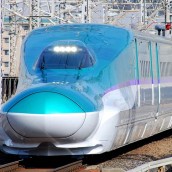
Hokkaido Shinkansen Line will run from March 26
28 Sep 2015
A long-awaited bullet train service that will link Hokkaido with Tokyo will open on March 26, railway operators have confirmed. Hokkaido Railway Co. and East Japan Railway Co. (JR East) will provide 13 round-trip runs per day on the Hokkaido Shinkansen Line. “This is an unprecedented project for the country, running through snowy areas and through the Seikan Tunnel (between Honshu and Hokkaido) as well as a section shared with cargo trains”- JR Hokkaido President Osamu Shimada said at a news conference at the railway’s headquarters in Sapporo. “We will put full efforts into starting the operation safely” Shimada added, noting that railway operators hope the passenger influx will benefit all of Hokkaido. Of the 13 runs, 10 will employ Hayabusa trains connecting Shin-Hakodate-Hokuto Station in southern Hokkaido and Tokyo. The fastest service will cover the distance in four hours and 10 minutes. One service will be covered by a Hayabusa train connecting Shin-Hakodate-Hokuto Station with Sendai, while Hayate trains will be employed for the remaining two services linking Shin-Hakodate-Hokuto Station with Shin-Aomori Station in Aomori Prefecture, and Morioka in Iwate Prefecture.
Source: http://www.japantimes.co.jp
Photo by Toshinori baba -Wikimedia Commons
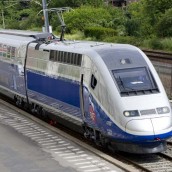
Tanger high speed train depot inaugurated
28 Sep 2015
The rolling stock depot in Tanger which will maintain and service the country’s fleet of high speed trains was officially inaugurated by King Mohammed VI and French President François Hollande on September 20, at a ceremony attended by ONCF Director-General Mohamed Rabie Khlie and SNCF President Guillaume Pepy. Two of the 14 Alstom-built double-deck trainsets have already been delivered to the port of Tanger-Med and are now undergoing static commissioning before the start of test running. The two railways have also formally established the joint venture company which will run the depot under a 15-year contract valued at €175m. Launched on September 15, Société Marocaine de Maintenance des Rames à Grande Vitesse is owned 60% by ONCF and 40% by the French national operator. According to SNCF, the new depot and maintenance regime will be derived from that used in France. Under an inter-government protocol signed in October 2007, the two railways have been co-operating in a ‘partnership of equals’ to support the development of the Moroccan high speed line. A technical co-operation team of around 30 people has been working on the project since 2009. SNCF staff will also support the early phase of operations, ‘building on more than 30 years of experience’ since the start of high speed services in France. The two partners have jointly established a railway engineering and operations training centre in Rabat. Although its new buildings are not expected to be ready until next year, the Institute de Formation Ferroviaire began work at the end of March 2015. With 30 lecturers drawn from both railways, it has already provided more than 5 000 days of training to around 1 700 students. By the end of this year, more than 2.200 ONCF and 1.100 SNCF trainees are expected to have passed through the facilities. As well as training employees of the parent railways, IFF will also make its courses available to other railways in Africa and the MENA region.

TMONET Joins OSPT Alliance to Expand its Mobile Pa yments Service Beyond Korea
28 Sep 2015
OSPT™ Alliance, the international association which provides an open standard for secure transit fare collection solutions, has welcomed TMONET, a mobile payment service and solution provider based in South Korea, as a Full Member. TMONET operates Mobile T-Money, the mobile application of the T-Money payment card launched by its partner, Korea Smart Card Co. (KSCC) in 2004. The service, which has been adopted in South Korea and New Zealand, allows users to make transactions for public transport fare collection and retail via a mobile phone. TMONET holds 90% of the mobile payment market share in Korea, with a service that has been adopted by 3.500.000 users across 45.000 bus and subway gates and 60.000 retail outlets. TMONET will integrate OSPT Alliance’s CIPURSE™ open standard – which offers an advanced foundation for developing highly secure, interoperable and flexible applications – into its Mobile T-Money solution. The company is evaluating opportunities to improve and expand its service, including the development of a cross-border mobile solution for transport ticketing. Seonku Lee, Vice President of TMONET, comments: “To maintain our position as a market leader in mobile payments it is important to constantly assess how our service can be improved and future-proofed. Security, usability and the enablement of seamless multi-application services are key factors that will be supported by integrating CIPURSE. We look forward to taking an active role in OSPT Alliance’s working groups and supporting the evolution of CIPURSE, both for the benefit of our Mobile T-Money solution – primarily within transit – and to facilitate its growth as a globally adopted standard. Ultimately, our aim is to develop a service that will enable cross-border travel via a single mobile device”. OSPT Alliance’s Executive Director, Laurent Cremer (in the picture) concludes: “More and more contactless applications, such as transport ticketing, payment and loyalty will be adapted to mobile devices over the coming years. To meet market requirements for cross border services, a secure, open, flexible and standardized foundation such as CIPURSE is imperative. I am pleased to see the standard gain traction in the mobile payments market, and excited to welcome TMONET, a company with significant market presence and expertise. I look with particular interest to its contributions to our global Working Groups and CIPURSE Mobile Sub-Working Group”.
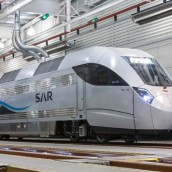
CAF presents first passenger train to Saudi Railway Company
28 Sep 2015
The first of six passenger trains being built by CAF was handed over by the company’s CEO Mr Andres Arizlorret to the chairman of Saudi Railway Company (SAR) Dr Saad A Al Qadhi and SAR’s CEO Dr Rumaih Al-Rumaih at the new station in Riyadh. The train had completed its first test run on part of the North-South Railway between Nariyah and Riyadh, a distance of 1130km. CAF is supplying four day trains and two overnight trains under a contract worth in excess of €400m. Each 280m-long day train comprises a diesel power car at each end and nine intermediate coaches, while the night trains will have a similar formation but with 13 intermediate coaches. The day trains will be able to seat 444 passengers. Testing and commissioning of fleet is expected to take 10 months, and each train must complete 10.000 km of trouble-free operation before it can enter service. SAR plans to introduce its first passenger services during the second half of 2016. SAR will operate the day trains between Riyadh, Buraydah and Ha’il, while the night trains will run from Riyadh via Hail to Jawf and Qurayyat near the Jordanian border. Studies will start shortly into a rail link between SAR’s new station in Riyadh and the station owned by Saudi Railway Organisation (SRO) to enable the operation of through services between SAR’s North-South Railway and SRO’s main line to Dammam.
Source: http://www.railjournal.com
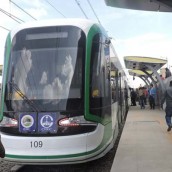
Addis Ababa’s first light railway comes online
28 Sep 2015
Addis Ababa’s $475-million light railway project became operational last 20th September following a colorful inauguration ceremony. According to Getachew Betru, CEO of the Ethiopian Railway Corporation, the new railway is capable of transporting up to 60,000 people each day. Speaking to Anadolu Agency during the maiden trip, Getachew said the railway – built by the Chinese Railway Engineering Corporation (CREC) – stretched some 35 kilometers across the eastern, western and northern parts of the city, which hosts the headquarters of both the African Union and the Economic Commission for Africa. On Sunday, Ethiopian Transport Minister Workineh Gebeyehu and CREC representative Zhang Zongyan both cut the ribbon marking the railway’s formal inauguration. According to Workineh, the railway offers a cheaper, faster and safer mode of transport for residents of the capital, with minimum and maximum fares ranging between two and six birr (from about $0.10 to $0.30).Workineh noted, however, that revenues collected from passenger fares would not be enough to cover the total cost of construction. “It’s hugely subsidized” he said, pointing out that the Ethiopian government planned to spend up to $1.5 billion on subsidies for the railway’s operations. The part of the project that became operational accounts for half of the railway’s total length. The remainder will become operational over the next two months, according to rail officials. Asked about the city’s erratic power supply, Workineh said this had been addressed by providing the railway with its own dedicated power source. Peter Olaseni Akinwumni, rail project manager for the Lagos Metropolitan Area Transport Authority, who also spoke to Anadolu Agency during the maiden commute, described the new railway as “a remarkable achievement”. “Not only Ethiopia, but all of Africa needs such a railway network, which is cheaper and accommodates many people at once – the way other modes of transport cannot,” he said.
Source: http://www.aa.com.tr
Photo: by Turtlewong – Wikimedia Common
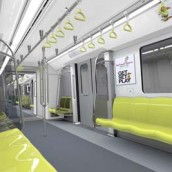
Metropolis for Kochi: design unveiled for the first time
28 Sep 2015
The design of the new Kochi Metropolis trainset, made by Alstom, was unveiled the 7th September by Kochi Metro Rail Limited (KMRL) to Kochi residents. Oommen Chandy, Hon’ble Chief Minister of Kerela, Elias George, KMRL Managing Director, and Bharat Salhotra, Managing Director of Alstom Transport India among others attended the event. The new metro will run on the Kochi’s new fully elevated metro rail network. Alstom – which was awarded the supply of 25 Metropolis trainsets in 2014 and 2 othersduring the course of 2015 – is the main supplier of the city’s new metro network. The Kochi metro was designed by Alstom’s Design&Styling department in Saint-Ouen in collaboration with the operator KMRL and TATA Elxsito enhance passenger experience, reflect KMRL’s identity and blend seamlessly into the city.The train is composed of 3 cars and is about 65 meters-long. It has an open gangway allowing passengers to walk from one end of the train to the other. The interior provides a feeling of serenity and security with sections marked in two bright, harmonious colors: green turquoise and lemon used for the seats and the handles. The metro train comprises 136 seats per car in a longitudinal seating arrangement optimizing transport capacity (975 passengers per car) and facilitating passenger boarding. The seats are made of a polyester composite, making them particularly easy to clean and maintain. For the comfort of elderly passengers or pregnant women, priority seats are filled with cushions. Persons with reduced mobility and wheelchair users will be able to use dedicated areas in the metro car while commuting. The front end of the train is made of polyester. Mostly green turquoise in color, it perfectly reflects KMRL’s new image, reinforced by the distinctive shape of its curved windshield. Representing an iconic symbol of India, the front LED lights are in the shape of elephant’s tusks. As the metro runs on a viaduct, the lights will illuminate the city at night. The side of the train is made of stainless steel. The train panels are made with aluminum and composites as well as anti-graffiti protection. The metro train features four external sliding doors per side making passenger traffic much smoother. Xavier Allard, Director Design & Styling, Alstom Transport said: “The design of the Kochi metro has set a new benchmark in urban mobility in India with its aesthetically-pleasing and stylish designs and technological innovations promoting greener urban transportation in the country. The metro for Kochi supports KMRL’s efforts to provide a comfortable, attractive and reliable service to Kochi residents and illustrates one of Alstom’s key strategies to enhance passenger experience”.
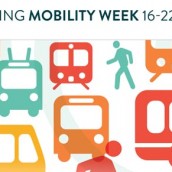
Travel green with public transport
28 Sep 2015
UITP (the International Association of Public Transport) is supporting the 2015 Mobility Week with a campaign aiming to highlight the vital role that public transport plays across the globe, transporting millions of people on a daily basis. In a world in which over 1,000 cities of more than 500,000 citizens are facing major mobility problems, UITP encouraged its members – and other transport stakeholders – around the world to join together in celebrating Mobility Week (16-22 September) to underline the crucial role played by public transport in keeping cities moving. In 2005, 47% of the daily trips worldwide were still made in private motorized vehicles, creating both pollution and congestion, degrading air quality and holding back economic growth. If significant action is not taken, energy use and greenhouse gas emissions are predicted to rise by nearly 30% by 2025 compared to 2005, primarily caused by a surge in the global stock of private vehicles. Encouraging a significant modal shift to public transport, as per UITP’s strategy of doubling the modal share of public transport by 2025, would play a major role in climate mitigation, making cities better places to live and work. “With more and more people living in cities across the globe, demand for urban mobility is rising, especially in developing countries,” said Alain Flausch, UITP Secretary General. “UITP’s campaign aims to highlight the vital role that public transport plays in both climate mitigation and sustainable growth”.
UITP and ECF together for more sustainable and active mobility
Another step towards greener and safer cities is the meeting between UITP and ECF (European Cyclists’ Federation) last 14th September to sign the very first Memorandum of Understanding between the two structures. The agreement will see the two work more closely on policy initiatives in order to strengthen the voice of sustainable urban transport. ECF and UITP have worked together for several years, both members of the SLoCaT Partnership (Sustainable Low Carbon Transport) and ECF being part of the UITP Combined Mobility Platform, and decided to take the relationship a step further. Both organizations will work closer together to achieve more sustainable and active mobility in Europe and support each other’s missions to ‘Double Cycling’ and ‘Double Public Transport’. For Europe, this would mean 15% of all trips to be cycled and doubling the modal share of public transport by 2025, which would result in more liveable and performing cities, contribute to green growth, and fight against climate change. Both parties see the benefits of an enhanced partnership to establish a stronger lobby position when talking to the European Institutions or the United Nations. Bernhard Ensink, Secretary General ECF said: “It is an important year to work together on the COP 21 and create impact in the process of the Sustainable Development Goals”. “Signing this Memorandum to kick off European Mobility Week 2015 marks a timely occasion to further strengthen ties between the public transport and cycling communities and unite to call for more sustainable mobility choices worldwide”- said UITP Secretary General Alain Flausch. The signature starts a more intensive collaboration process for the development of policy messages on economic benefits of sustainable mobility, public health, transport policy, and urban mobility data collection.
More information available on: http://www.uitp.org/mobilityweek
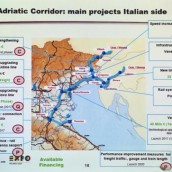
Trieste hosts the first Forum on Italo-Balkan relations
28 Sep 2015
The Balkans are one of the European regions with the most potential for development in the near future. The upgrading of the railway network and its complete integration in the TEN-T European Corridors is one of the most important drivers for the growth of the economies of the countries in that area. The strategies for the development of the railway infrastructures between Italy and the Balkans were the focus of a specialized Forum on 17 and 18 September, organized in Trieste by CIFI (Collegio degli Ingegneri Ferroviari Italiani – College of Italian Railway Engineers) with the cooperation of Gruppo Ferrovie dello Stato Italiane, Assifer (the association of Italian railway industries) and Aniaf (industrial enterprises specialized in railway superstructures). And of course Trieste was not chosen by chance: the capital of the Friuli Venezia Giulia Region is Italy’s natural port towards the Balkans, one of the main ports of the Adriatic Sea and it is involved in important railway projects. In addition to the CEO of FSI, Michele Mario Elia, the CEO of RFI, Maurizio Gentile, and that of Italferr, Matteo Triglia, and RFI engineers Enzo Marzilli, Donato Carillo and Giovanni Costa, the Forum was also attended by the representatives of Railway Administration Boards of Slovenia, Macedonia, Bulgaria, Albania and Montenegro. In the first part of the Forum, Gruppo FSI and the Railway Administration Boards of the guest countries illustrated their development programmes. This was followed by a second part dedicated to Italian industrial enterprises belonging to the sector which described their activities with particular attention to the possible need for the renewal and upgrading of the Balkan networks. The talk given by the CEO of Gruppo FSI, Michele Mario Elia, was of particular interest; he detailed the investments already in course and those planned for the future which are, directly or indirectly, functional to the development of railway relations with the Balkans. Elia reminded his listeners that the Adriatic-Ionian area includes a territory with a population totaling to approx. 60 million inhabitants, with a GDP of around 1000 billion euros, 600 of which are produced in the Italian regions overlooking these two seas. Integration between the two shores is facilitated by the railway infrastructure network, maritime links, intermodal hubs and port terminals. The commitment of Gruppo FSI is, therefore, chiefly focused on the technological upgrading of the link between Trieste and Venice, with an overall investment estimated to be around 250 million euros, and on that between Trieste and Divača, in Slovenia for which feasibility studies are currently underway, but also on the upgrading of the railway infrastructures that serve the Port of Trieste, for which 50 million euros have been earmarked. Moreover, FSI has commenced an upgrade on the entire Adriatic railway line that serves the ports overlooking the Balkans, from Ravenna, to Ancona, Brindisi and Taranto, with an increase in capacity and loading gauge. But Gruppo FSI has been operating in many countries in the Balkans for sometimes now, through its own engineering company, Italferr, and its certification company, Italcertifer. Italferr is involved, in Serbia and Montenegro, on studies for the upgrading of the goods line from Belgrade to the port of Bar, and it is working on the National Transport Plan. Feasibility studies have also commenced in Croatia for the upgrading of Corridor X, and in Albania for the new passenger station of the capital city, while in Bosnia a review of the local railway regulations is underway. Meanwhile, Italcertifer is working in Serbia, Greece and Bulgaria for the certification of traffic control systems and entire new railway lines.
by Franco Tanel
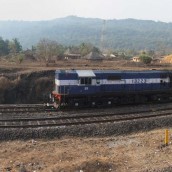
Port link opened under non-government railway policy
22 Jul 2015
Minister of Railways Shri Suresh Prabhakar Prabhu inaugurated last 14th July the newly constructed broad-gauge railway-line between Gandhidham and Tuna-Tekra Port in Gujarat by flagging off a goods train.Gandhidham is a town in Kutch district of Gujarat while Tuna-Tekra Port is a port 20 k.m. west of Kandla in Gulf of Kutch in Gujarat. The inauguration was done from Delhi through remote control by setting-up a video-conferencing between Rail Bhawan, New Delhi and Gandhidham Railway Station.The project has been complete under the private line/Non-Government Railway (NGR) Model of Participative Model Policy of 2012 of Ministry of Railways for undertaking rail connectivity and capacity augmentation projects. It is yet another significant initiative under PPP. This railway-line is the first Non-Government Railway Project of Indian Railways under the NGR policy of 2012. This project has been funded by M/s Kandla Port Trust (KPT). It is the Western Railway Zone of Indian Railways which has coordinated and pioneered this important infrastructure project. This approx. 17 kms. long ambitious project was approved by Railway Board in October 2013. Construction work commenced in May, 2014 and was completed in record time in May, 2015. Cost of this project is approx. Rs.185 crore. Major traffic from the port is coal and fertilizer with an expected commodity traffic of average 4 rakes daily. Indian Railways will get approximate revenue of Rs.5.00 crore from the line by moving this traffic. This line has been constructed for M/s Kandla Port Trust to bring about better and faster rail connectivity to Port of Tuna & Tekra.The project has been executed in two parts – 11 kms. Gandhidham- Tuna Rail line by Western Railway Zone (as deposite work) and 6 km. line between Tuna-Tekra by M/s Kandla Port Trust. Under the participative policy of 2012, Ministry of Railways have undertaken connectivity to 4 ports namely Dhamra port, Tuna port, Jaigarh Port, Dighi port. These four projects will generate investment of approx. Rs.2400 crore with no financial commitment to equity from Ministry of Railways. In principle clearance have been granted for another five port connectivity projects. These five projects will generate investment of approx. Rs.2800 crore with no financial commitment to equity from Ministry of Railways. Earlier, between 2002-2012 seven port connectivity projects were implemented. These projects have added approximately 950 km of railway line bringing an investment of approximately Rs.3000 crore.
Photo by Arne Hückelheim through Wikimedia Commons
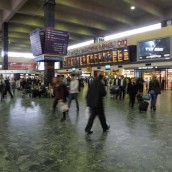
Railway stations get caffeine kick thanks to coffee recycling deal
22 Jul 2015
Buying a coffee in Britain’s biggest and busiest railway stations just got greener thanks to a new recycling project which is turning coffee waste into fuel and helping cut the cost of running the railway. Following a successful trial at London’s Victoria and Waterloo stations, Network Rail has signed an agreement with bio-bean – an award-winning green energy company that recycles waste coffee grounds and converts them to advanced biofuels – that will see six of the largest railway stations in Britain all committing their coffee waste to the project. Between them, Network Rail’s six biggest stations (Euston, King’s Cross, Liverpool Street, Paddington, Victoria and Waterloo) generate nearly 700 tonnes of coffee waste each year. Rather than sending it to landfill, this waste will now go to the bio-bean factory to be converted into over 650 tonnes of carbon-neutral biofuels for heating homes, offices and factories, saving more than 5,000 tonnes of carbon dioxide from entering the atmosphere each year. Each tonne of waste coffee grounds creates over 5,700 kilowatt hours of energy, with the 700 tonnes enough to power 1000 homes for a year. David Biggs, managing director of property at Network Rail, said: “Millions of cups of coffee are bought in our stations every year and that number is growing as passenger numbers continue to rise. This partnership will see the waste from those purchases put to good use, creating biofuels that can be used in vehicles and to heat homes and saving more than 5,000 tonnes of carbon dioxide from entering the atmosphere. It’s good news that our stations are cutting their carbon footprint while also saving passengers and taxpayers money. The new solution is cheaper than sending the waste to landfill, which means we can invest more in making the railway better for the four million people who travel by rail each day”. Arthur Kay, CEO of bio-bean added: “The UK generates over 500,000 tonnes of waste coffee grounds each year, costing the coffee industry almost £80 million in waste disposal fees. Bio-bean recycles waste coffee grounds into advanced biofuels at an industrial scale, creating local, sustainable green energy as an alternative to fossil fuels. We are delighted to provide a cost-effective disposal solution for waste coffee grounds from these major transport hubs”.
Photo by Sunil060902 through Wikimedia Commons
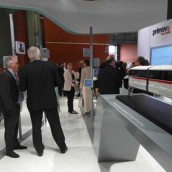
Bombardier Showcases Latest Mobility Solutions for Livable Cities at the 61st UITP World Congress and Exhibition in Milan
22 Jul 2015
Rail technology leader Bombardier Transportation is a major player at this year’s UITP World Congress and Exhibition held in Milan, Italy from June 8-10, 2015. UITP’s slogan “SMILE in the city” and acronym “SMILE”, Sustainability, Mobility, Innovation, Lifestyle and Economy, provide the keywords for this year’s most important event for public transport operators. Lutz Bertling, President and Chief Operating Officer, Bombardier Transportation, said, “Fast growing cities and booming populations are increasing demand for efficient and sustainable public transport systems. Bombardier is responding with the solutions that address the 21st century’s major mobility challenges; how to increase performance while making cities more livable”. At the exhibition, Bombardier demonstrated how its products and services are driving innovation forward. It highlighted its role as a leading provider of integrated transport solutions and presented its portfolio of services that make Bombardier the long-term partner of choice for public transport operators all over the world. Bombardier presented urban mobility developments including the eco-friendly BOMBARDIER C30 MOVIA Metro for Stockholm and latest BOMBARDIER PRIMOVE e-bus projects. New innovative safety technologies for BOMBARDIER FLEXITY light rail vehicles on show including the Driver Assistance system and BodyGuardTM Bombardier also highlighted long-term fleet services solutions that minimize operational costs and add value for city and regional transport operators.
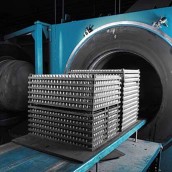
The importance of materials: sintered alloys
22 Jul 2015
La Celsia sintered products can increase the main features, improving reliability, safety and life time of the entire devices.
Every specific application need a different switch or contactor so it is necessary to analyze their characteristics to achieve higher profitability. This article highlights the importance in which each kind of breaking device must be used on every type of maneuver and also in critical or disadvantaged environments conditions without problems. To obtain these benefits you can act on the type of sintered alloy used, choosing different materials to compensate problems of employment. In the context of the construction of an electrical contact there are several factors that must be taken into account in order to obtain an excellent result. It is necessary to take in consideration the following criteria:
- the type of switch which is to be applied;
- if you have heat dissipation;
- if you are having arc extinguishing taking into consideration the duration and amplitude of arc. It must be reduced to the minimum compatible with appropriate arc voltage;
- removal or dissipation of energy;
- the interruption interval (to avoid heating);
- the pressure to be submitted and the deformation to which it will be subjected;
- temperature and temperature increase;-
- the influence of currents to limits rebounds;
- electromechanical phenomena;
The best method to create materials with better electrical and mechanical Characteristics is applying alloys which offer the advantage of reducing the transfer of material during operation and that create a sort of protective film, which reduces the possibility of welding or fusion of the material itself. These metal alloys areobtained through sintering by mixing or infiltration, as Treaty for the powder metallurgy. Thanks to its deep knowledge of the phenomena and sintered alloys La Celsia can offer and suggest a wide range of sintered alloys for every kind of application, solving many problems of malfunctioning of electrical appliances in terms of time of operations/hour.
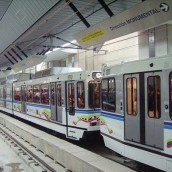
The President Maduro opens the new section of light metro
22 May 2015
The first section of second phase of the light metro network in Valencia was officially opened by President Nicolás Maduro on April 29, running for 630 m from Cedeño to Rafael Urdaneta and Francisco de Miranda. Having cost US$1·6bn to build, the extension is expected to be used by 30,000 passengers per day. The second phase of the Valencia network will run for a total of 4·3 km and serve six stations, expected to be used by 175,000 passengers per day and creating 2,000 direct and indirect jobs. With work now 70% completed, the stations at Negra Hipólita and Josefa Camejo are expected to enter service in 2016, followed by Atanasio Girardot and Tacarigua.
Source: www.railwaygazette.com - Photo by Javier Rumbos 2010
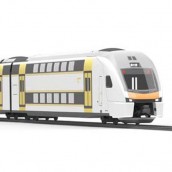
Stadler sells 5 Kiss Double Deckers to Azerbaijan Railways
22 May 2015
Stadler Bussnang AG and Azerbaijan Railways ADY has signed a contract for the delivery of 5 double-deck KISS trains on the international transport exhibition TransCaspian. The new broad gauge electric multiple units will operate between the cities of the capital Baku and Sumgait. Azerbaijan Railways (ADY) has decided to buy KISS trains from Stadler as part of the program for the development of rail transport in Azerbaijan. The four car units will satisfy the growing demand for high-quality public transport and offer passengers great comfort in a bright and spacious interior, comfortable seats, full air conditioning, passenger information system, WiFi and other functions. The trains will have 396 seats, including 84 business class seats, and have a total capacity of carrying 919 passengers. Trains fulfi all standards of the Azerbaijan Republic and will become the new standard for suburban rail transport in the country. The value of the deal totals to EUR 70 million. The delivery of all the units will be completed by January 2016, after which the 5 new vehicles will operate on the railway line between Baku and Sumgait. Stadler and ADY started negotiations about the modernization of passenger rail transport between Baku and Sumgait already back in 2014. The discussions also touched the possibility of presenting the first units already on the European Games, which Baku is hosting this year. In order to make it possible, the production process of technically identical trains has been accelerated, by which measure Stadler is able to deliver two units on a very short notice to ADY. Stadler will immediately start the training of train drivers in Minsk, however according to the agreement, during passenger operation in the first months an instructor from Stadler will permanently stay in the driver’s cabin.
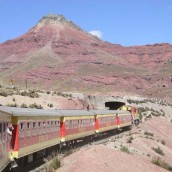
Peru-Chile rail link opens again
22 May 2015
Rehabilitation is underway of the 62km line linking Tacna in southern Peru, with Arica in northern Chile, and the passenger service should be restored in July with two round trips per day using a refurbished railbus. The service was discontinued in March 2012 due to the poor state of the track and mechanical problems with the only operational railbus. The Tacna-Arica Railway (FCTA) belongs to the Tacna regional government which had initiated repair work, but this has now intensified with funding from the Peruvian National Transport and Communications Ministry. The Peruvian government agency ProInversión has contracted a feasibility study into the operation of freight services between the port of Arica and the Tacna Duty-Free Zone, both of which lie close to the railway, as well as local services in Tacna. If they prove viable, the services would be put out to tender. This is second South America cross-border passenger rail service to be revived. At the end of 2014, a DMU service was inaugurated between Posadas, Argentina, and Encarnación, Paraguay, vía the San Roque González de Santa Cruz bridge across the Paraná river. The service is carrying up to 8000 passengers per day, whereas the revived FCTA service cannot be expected to carry more than a few hundred.
Source: http://www.railjournal.com - Photo by Maurice Chédel
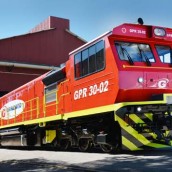
Two locos Grindrod of eight delivered to Doula
22 May 2015
Railway concessionaire Camrail, owned by Bolloré Africa Logistics, has taken delivery of two CC 3300 locomotives at the port of Douala. Representing an investment of FrCFA3bn each, the locomotives were supplied by South African manufacturer Grindrod as part of an initial batch of eight diesel heavy freight locos which are due to be accepted by the end of the year. The next pair of locos is due to arrive by the end of May. Camrail says that the locomotives will enhance the operator’s ability to run longer freight trains through their haulage capability of up to 1,500 tonnes. The acquisitions are part of the commitments made by Camrail under the terms of its national railway concession agreement, which runs until December 31, 2034. This agreement covers railway investment totalling FrCFA230bn between 2009 and 2020, of which FrCFA158bn would be fi anced by Camrail. Camrail was established by Bolloré when it took over operation of the 980 km metre-gauge network in 1999. Camrail was born out of the privatisation of the Cameroon national Railways, initiated by the Cameroon Government in her economic boosting policy. The privatisation process which took off in the month of January 1996 ended in January 1999 with the signing of a concession agreement. CamrailL effectively started its activities on the 1st of April 1999. The concession agreement conceded to Camral: technical and commercial management of the railway System; maintenance, renewal, development and the exploitation of Railways infrastructure; management of the railway estate.
Source: http://www.railwaygazette.com/ - http://www.grindrod.co.za/ – Photo by Grindrod
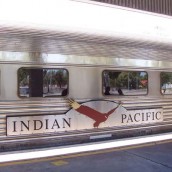
Great Southern Sold
22 May 2015
On 1 November 1997, the Australian luxury passenger train services The Ghan, Indian Pacific and The Overland were sold to Great Southern Rail, a consortium of GB Railways, Legal & General, Macquarie Bank, RailAmerica, G13 Pty Ltd and Serco. Included were 186 items of rolling stock, primarily stainless steel coaches, as well as the stations at Adelaide and Alice Springs. In October 1999, Serco bought out its consortium partners. Serco in turn sold the entire operation to Allegro Funds in March 2015. The Ghan travels 2,979km from Adelaide to Darwin. The Indian Pacific covers 4,352km from Sydney to Perth. Operation of The Overland (Adelaide-Melbourne) is subsidised by the Victorian and South Australian governments. The other services are profit. Allegro founding partner and managing director Adrian Loader explains that luxury travel is benefiting from a drop in the value of the Australian dollar, giving overseas tourists more spending power. As high as $US1.10 in late 2011, the Australian dollar is presently trading around $US0.77. Sounds hard to believe, yet the South African Rand was once worth about $US1.10. That was back in the mid- seventies.
Source: www.railwaysafrica.com - Photo by Hourann Bosci from Perth, Australia
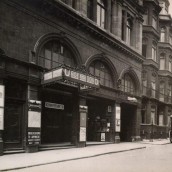
TFL seeks partner to transform disused Down Street station
22 May 2015
Transport for London (TfL) is inviting businesses to submit innovative ideas to transform Down Street Tube station into a commercially viable business as part of its plans to generate £3.4bn in non-fare revenue to reinvest in the transport network. Down Street Tube station, is located on a quiet residential street off Piccadilly. It opened on the Great Northern Piccadilly & Brompton Railway on 15 March 1907 and closed on 22 May 1932 due to low passenger usage because of its close proximity to Hyde Park Corner and Green Park (formerly Dover Street) stations. TfL is offering a unique opportunity for established and enterprising businesses to develop the untapped potential of the disused station, which is located in the heart of one of the most exclusive postcodes in London. Although Down Street station is closed to the public, it is still in regular use as part of the day to day operation of the Tube. TfL will lease out part of the station, around 400m2, to businesses who have the ability to use the space to create something exceptional and establish the next chapter in the station’s history. Graeme Craig, TfL’s Director of Commercial Development, said: “The combination of space, history, and location, makes this a unique opportunity. We are looking for a partner with the imagination to see the potential here and the capability to deliver it”. Adjoining parts of the station are still required for running the Tube, but we will work with interested parties to ensure the commercial and operational activities can happily coexist”. The station played a vital role in the Second World War when it was used as the protected underground headquarters for the Railway Executive Committee. It is also believed that the station was used by Sir Winston Churchill and the War Cabinet while the Cabinet War Rooms were being prepared. Potential tenants can find out more about the station at: http://www.tfl.gov.uk/info-for/business-and-commercial/ commercial-opportunities/new-projects
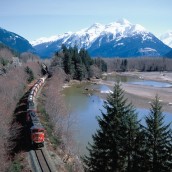
CN invests to raise network safety and efficiency
22 May 2015
CN announced the details of its 2015 plan to invest C$2.7 billion in rail infrastructure maintenance and improvements, as well as in new capacity, equipment and technology to raise network safety and efficiency, improve service and support future growth. Claude Mongeau, president and chief executive officer, said: “With the work season now well underway, CN is embarking on a large number of maintenance and construction projects to ensure we continue to run a safe railway and play a continuing role as a true backbone of the economy”. CN is planning to spend approximately C$1.4 billion on track infrastructure. This will include the replacement of rail, ties and other track materials, bridge improvements, as well as various branch-line upgrades. Such investments allow CN to improve the network and are part of a multi-year program aimed at maintaining a high level of safety and efficiency while helping CN’s customers grow. Within its track infrastructure spending, CN is allocating C$100 million to upgrade its feeder network. This investment is part of theC$500-million program announced earlier this year to upgrade branch lines that are experiencing rising volumes of traffic. CN safety investments this year will include additional fault detection systems such as wayside inspection system technology, hot wheel detectors, wheel impact load detectors, signaled sidings to detect broken rails, and new geometry testing and joint- bar inspection technology. CN will also spend approximately C$800 million in 2015 on growth and productivity initiatives such as yard improvements, intermodal terminals, transload and distribution centres and information technology. CN’s equipment capital expenditures in 2015 are targeted to reach approximately C$500 million, allowing the company to tap growth opportunities and improve the quality of the fleet. As part of this initiative, CN expects to take delivery of 90 new high-horsepower locomotives and will invest in new rolling stock and freight car refurbishments. Mongeau concluded: “CN is investing in a safe, efficient railway that is building on a strong foundation as well as building for the future in this the 20th anniversary year of our initial public offering of shares. We are proud of our achievements and our record of investing significant capital in the business to ensure a sustainable enterprise for many years to come”.
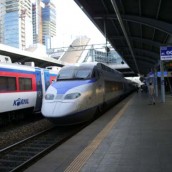
The new Korean high-speed line inaugurated
22 May 2015
South Korea’s new 182.3km high-speed line from Osong to Gwangju entered public service on 2 April. The new line was inaugurated on 1 April by Korean president Park Geunhye. Osong lies on the existing Seoul-Busan high-speed route, which means that Seoul- Gwangju journey times decrease by 1h 6min from the 2h 39min taken on the original line. Completion of the new facility is in line with the government’s aim to have all the country’s major cities within half-a-day’s train travel. The Osong-Gwangju project, budgeted at $US 9.28 billion, was begun in 2009, funded entirely by the ministry of transport and infrastructure. Stations on the new line include Namgongju, Iksan, Jeongeup, Gwangju-Songjeong. Trainsets being used comprise 15 new 410-seat Honam KTX units from Hyundai Rotem. A further seven sets are still to be delivered. High-speed rail service has not only reduced the travel to anywhere in South Korea to less than 3 hours, causing a dramatic change in the people’s lifestyle, but also had a significant social, economic and cultural impact.
Source: www.railwaysafrica.com - Photo by skinnylawyer from Los Angeles, California, USA
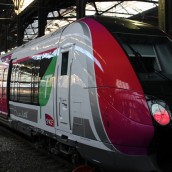
Bommbardier to supply 19 additional Francilien commuter trains to Île-de- France
22 May 2015
Rail technology leader Bombardier Transportation announced that France’s state-owned railway company, Société nationale des chemins de fer français, (SNCF) has exercised an option for 19 additional Francilien Electric Multiple Unit (EMU) commuter trains. The order, entirely financed by Île-de-France’s transport authority Syndicat des transports d’Île-de-France (STIF), is valued at approximately 127 million euro ($141 million US). The original firm order for 172 trains was part of a contract signed in 2006 for up to 372 trains. The fi call off option order for 22 trains came in 2014 and this second call off order for 19 units brings the total number of Francilien trains ordered by SNCF to 213, leaving the potential for an additional 159 trains. The additional trains will contribute to STIF’s overall fleet modernization and be rolled out on the SNCF Transilien line L on the Versailles Rive Droite branch. Jean Bergé, President, Bombardier Transportation France, said, “Due to the high passenger demand placed on the SNCF Transilien network, our clients require not only improved reliability and performance, but also a comfortable train that is able to increase capacity. These trains meet and exceed those needs, making the Francilien the best performing train in the Île-de-France fleet. According to SNCF, nine out of 10 Line H passengers are satisfied with the service, as a result of the improvement of transportation conditions, punctuality, on-board information and comfort. Line H, which operates with a full Francilien fl scores the Transilien SNCF network’s highest punctuality rate of 95%. Scheduled for delivery between the end of 2016 and mid-2017, the trains have room for up to 1,000 people, feature large seats, open gangways and wide doors to facilitate passenger flow. They will also include proven technology like Bombardier Flexx Compact bogies and Bombardier Mitrac t Train Control and Management System (TCMS) to provide a smooth and comfortable ride. At present, 155 Bombardier Francilien trains operate out of the Gare du Nord, Gare de L’Est, and Gare Saint-Lazare stations in Paris, France.
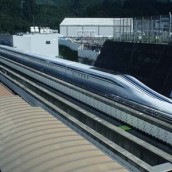
Magalev Train breaks world speed record again
22 May 2015
A Japanese magnetic levitation train has broken its own world speed record, hitting 603km/h (374mph) in a test run near Mount Fuji. This was enough to break its own 12-year-old, 361 mph world record set back in 2003. The train reportedly carried 29 engineers during its run. Maglev trains use electrically charged magnets to lift and move carriages above the rail tracks. Central Japan Railway (JR Central), which owns the trains, wants to introduce the service between Tokyo and the central city of Nagoya by 2027. The 280km journey would take only about 40 minutes, less than half the current time. However, passengers will not get to experience the maglev’s record-breaking speeds because the company said its trains will operate at a maximum of 505km/h. In comparison, the fastest operating speed of a Japanese shinkansen, or “bullet train” is 320km/h.
Source: http://www.bbc.com - Photo by Saruno Hirobano
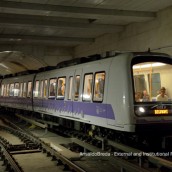
Milano metro line 5 extension begins driverless operation
22 May 2015
New driverless vehicles have begun operation on the Milan Metro Line 5 extension which opened on the 29th April 2015. Finmeccanica-AnsaldoBreda delivered 19 trains listed in the contract with the Milan Metro operator ATM. The trains will run along the extended 12.8km line to San Siro Stadio and will stop at five newly opened stations – FNM Domodossola, Lotto, Segesta, San Siro Ippodromo and San Siro Stadio. A further five stations will be opened in October this year; they include Monumentale, Cenisio, Gerusalemme, The Torri and Portello. At the end of the ceremony, attended by the Mayor Giuliano Pisapia, held at the station of San Siro, Maurizio Manfellotto, CEO of the company part of the Finmeccanica Group, commented on the introduction of new trains on Line 5: “After the delivery of 19 trains listed in the contract, AB has further strengthened its leadership in the category of the driverless metros in operation, tangible sign that our technological level is increasingly appreciated. We have now reached the 30% of the market share but we want to go further and we are working to introduce products that are able to catch more and more the needs of our customers”.
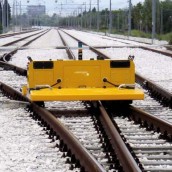
Felix, the mobile robot
22 May 2015
The railway network maintenance is a critical issue when it comes to safety. The railroad switches are identified as the most critical points. The current scenario requires that the operators of the rail network carry out surveys samplings with manual instruments. Felix, developed by Loccioni Group, is the first robot which is able to automatically measure the conditions of railroad switches. The robot is equipped with sensors of artificial vision able to create a three-dimensional reconstruction of the inspected surfaces. Algorithms then extract the dimensional parameters, for example distances and depths, to detect the presence of anomalies. The flexibility of the instrument is one of its greatest potential: Felix is able to replace multiple manual tools currently applied to get different measures. Moreover, it can be used on both railroad switches and on tracks. Thanks to the motorized structure, it is possible to analyze more switches in series. The robot reaches a top speed of 5 km/h and a minimum interval between two successive measurements of 5 mm. The system is modular and can be managed by just two operators, thanks to the ease of transport and assembly. It is managed remotely, ensuring greater safety to the workers. Felix can store, process and display all measurements, creating specific reports. The test results are automatically transferred in all environmental conditions (rain, snow, temperature excursions), to be continuously operative for more than 6 hours. Felix is also provided with a calibration certificate in full compliance with EN 13848. It increases performance measurement, makes surveys objective and restricts the error both in the acquisition and in the data transfer phase. The robot increases economic efficiency: automatic operations halve the operating time for measurements and cancel that for the transfer of the reports. The consequence is an increase in productivity and professionalism of the employees. Another economic advantage is an increase in the efficiency of transport: the objectivity of the measure leads to slow down only the sections which are definitely damaged, avoiding the payment of fines for train delays. The success of the project was the creation of a work group between RFI and Loccioni since 2010, to share the know how about railway maintenance procedures and measure and automation competences, in way to create a turn-key solution for the requested needs. The advantages of the use of Felix were quantified through extended field tests conducted by RFI. The product was approved for the “L94 legislation” focused on the inspection of switches. During this year, a fleet of to the centralized network manager system, further simplifying the procedures. The robustness of the robot makes it able to operate 37 robots will be distributed into the geographical areas of the network. RFI, in fact, manages approximately 40,000 witches and it checks them every 4 months.
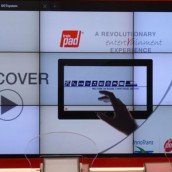
TrainPAD® changes travelling experience on train
25 Mar 2015
During the last edition of Eurasia, in Instanbul, DOT System has presented TrainPAD®, an innovative system of EnterTrainment that will allow travellers to access to a wide range of multimedia services, and its solutions for the rail sector to the Asian rail market. TrainPAD® has been presented for the first time in Berlin, during Innotrans, the most important rail fair in Berlin.
TrainPAD® is a high quality device featured by a 9 inches high resolution LCD display with a robust “multi-touch”, NFC interface, stereo audio and other advanced and attractive features. “TrainPAD® represents the new challenge for the High Speed and Very High Speed market and for long distance journeys, says Luciano Scaccabarozzi, Dot System Ceo. It’s a new business opportunity also for rail operators that will be able to develop and provide applications linked to commercial offers and discounts, including customer loyalty programs.
The services
As an instance, TrainPAD® offers a virtually unlimited set of top class multimedia services, including the opportunity to get the most fascinating and trendy APPs from one of the largest APP store in the world, or to enjoy the only one exclusively developed by the Rail Operator for its customers. Overall, TrainPAD® can be continuously updated with new services, attractive APPs and can be came foundation for a promising new business model for the Rail Company. TrainPAD® offers the possibility to download and use app to read newspapers in digital format, to listen to your favorite music, to watch a movie or a live match, to challenge your friends with interactive games or book directly from your seat your breakfast, lunch or dinner. It will be possible to see guides and interactive maps, view your current location, find the nearest railway station or the most interesting cities along the way, take advantage of the special discounts reserved to passenger in the exclusive market, send email directly from the train and to get a personal trainer to learn useful exercises to do on board. Every traveler will be able to book a restaurant at the destination place, rent a car or other services, optimizing the time of the trip.
The technology
The TrainPAD® hearth is the Hyper Dot Link (HDL) Technology. This revolutionary technology, specifically designed and proven for the high demanding rail requirements, delivers up to 2 high quality “HD” class videos, high quality stereo audio and bidirectional data over a low cost, highly standardized Cat5e shielded Ethernet cable inside a rail vehicle. Moreover, on the same Cat5e cable, the HDL technology carries the Power supply for the two TrainPAD® units sharing the same cable. Through HDL information runs via Cat5e cable, in high audio and video definition at the impressive rate of 2 gigabits per second (20 times more than Ethernet 100BaseTx and more than 40 times than wi-fi speed on board). Thanks to HDL, you can surf on internet from your seat, watch movies, listen music through TrainPAD®device, thanks to a fast and costant network connection for whole travel time.

Official Opening of the suburban network from Glenfield to Leppington
25 Mar 2015
The South West Rail Link (SWRL) extension to the Sydney Trains suburban network from Glenfield to Leppington was officially opened to the public last February. The premier of the state of New South Wales Mr Mike Baird said the $A 1.8bn ($US 1.4bn) 11.4km extension had been completed more than a year ahead of schedule and $A 300m under budget.
Transport minister Ms Gladys Berejiklian said planning work had already started to extend the line to a proposed second Sydney airport at Badgery’s Creek. A half-hourly Leppington – Liverpool shuttle service operates daily between 05.00 and 00.00 with journey time of 16 minutes. It is anticipated that through working to other parts of the network will be initiated as part of a future system-wide timetable revision. In the meantime, connections with the rest of the Sydney Trains network are made at either the mainline junction at Glenfield or Liverpool. Work on the project commenced in 2011 and included a major rebuild of Glenfield station, with a flyover connecting the new line to the existing main line. The project also included the construction of a train stabling facility at Rossmore near Leppington. CEO of the Australasian Railway Association Mr Bryan Nye congratulated the state government on its achievement, but said with a state election next month, it is critical that rail infrastructure projects remain a priority on the policy agenda of all political parties. “With the completion of the SWRL and construction underway for the North West Rail Link, it is paramount that momentum continues for the other vital rail projects planned for Sydney, such as the second harbour crossing and the George Street and Parramatta light rail systems,” he says.
(Source: http://www.railjournal.com/ – photo: Wykymania at en.wikipedia)
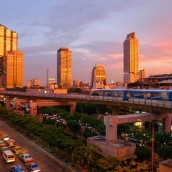
Bangkok Mass Rapid Transit-Green Line Extension,
25 Mar 2015
Bangkok assigned the Team Consulting Engineering & Management Company to undertake feasibility studies into extending the existing “skytrain” line. Three possible routes have been submitted for consideration.
The first would be about 8km in length with six stations, following Ratchaphruek Road. The second – 10km with eight stations – would head west along Phran Nok-Phutthamonthon Sai 4. The third – 8km with six stations – would also head west, but along Tharit Issarayangyun. The third option, Team Consulting points out, would serve the most people but, unlike the other two options, would necessitate the expropriating of land. The existing Green Line, also known as the Sukhumvit Line, is an elevated rail line from Mo Chit in the Chatuchak District to Bearing in Bang Na District of Bangkok. In the southern expansion, the Green Line will be extended from Bearing to Samutprakarn. The northern expansion will include the extension of the line from Mo Chit to Khu Khot, via Saphan Mai. The Bearing-Samutprakarn section of the MRT Green Line project is in advanced stage of development. The extended line is scheduled to open for service in 2017. The 12.6km elevated line from Bearing to Samutprakarn will involve the construction of nine new stations along the route. The stations are designed to stand along the median of Sukhumvit road with few of them integrated with other mass transit lines. A 48-acre depot capable of housing 40 three-car trains will be built at the ending point of the route near Bang Pu. The Operation Control Centre (OCC) and administration buildings for the project will also be located in the depot area. The Bearing- Samutprakarn extension line is expected to serve up to 57,000 passengers a day when it is complete in 2017. Preliminary construction works of the project started in 2012. The estimated cost of the project is THB 24.54bn ($763.5m). A total of 16 stations have been identified for the Mo Chit-Khu Khot section of the MRT Green Line extension. The depot housing 36 trains and the OCC will be located near Khu Khot station. The Mo Chit-Khu Khot Green Line MRT project was estimated to cost THB 52.97bn ($1.6bn) in 2012. It is expected to be completed in 2018 or 2019. Both sections of the Green Line extension will be operated with 750V DC rolling stock with three to six cars.
(Sources: http://www.railway-technology.com/ and http://www.railwaysafrica.com/ – Photo: Diliff)
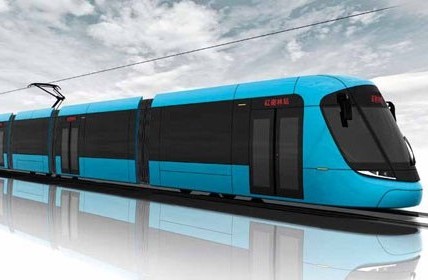
Voith engineers to develop new low-floor tram for Taiwan
25 Mar 2015
Voith Engineering Services wins order for “Green Mountain Line” in New Taipei City. First trams scheduled to come into service in 2018. The Taiwan Rolling Stock Company (TRSC) has engaged Voith Engineering Services to develop a tram for the Danhai New Township in New Taipei City (Taiwan).
Over an 8 km route, the “Green Mountain Line” tram will connect the center of New Taipei City with the mountains on the outskirts of Danhai. Later, a “Blue Ocean Line” is set to also connect the coast with the city center. The entire infrastructure to do this has to be established, meaning rails, bridges and depot facilities have to be built, media and energy provision ensured and vehicles supplied. The entire project will be headed by China Steel Corporation, Taiwan‘s largest steel manufacturer, while the Taiwan Rolling Stock Company (TRSC) is responsible for providing the rail vehicles. The 34.5 m long trams are to have a five-section low-floor design and must be capable of travelling in both directions. They should also be standard gauge and capable of travelling through larger intersections and track sections without overhead wires, so they have to be equipped with additional energy storage. TRSC has engaged the experts from Voith Engineering Services to develop these vehicles. “It was important to us to have an experienced and reliable partner like Voith Engineering Services to support us,” says Michael Chung, Vice President, TRSC. For this project the engineering specialists will take over the entire development of the vehicle, from concept and design through the prototyping phase to subsequent commissioning, including analyses of reliability, maintainability and safety. In addition, they will provide support with production planning and factory planning, will design fixtures for welding assemblies and integrate system components. Voith will supervise production of the prototype vehicle and the starting phase of volume production and will provide support with approval and commissioning (with acceptance inspection by a government body). “We are delighted that TRSC has confidence in our expertise and experience and that we have been able to win yet another major project to develop a tram,” says Frank Salzwedel, Executive Vice President Rail at Voith Engineering Services. The first prototype is scheduled for completion by the end of 2016, with volume production envisaged for 2017. The first trams should run on the “Green Mountain Line” in 2018.

President Zuma promises to improve train service and safety
25 Mar 2015
On 9 March, as part of the presidential Siyahlola service delivery monitoring programme, President Zuma carried out unannounced visits to public transport facilities around Pretoria to assess performance and the state of infrastructure.
His day began with an inspection at Metrorail’s Denneboom station, which serves Mamelodi, a vast township east of the capital. Residents told the president they were constantly late for work due to trains running behind time and said safety and security were serious problems. Women, schoolchildren and senior citizens were the most vulnerable to criminal activities “that occur daily in the trains”. They urged the President to act because numerous community protests about these shortcomings had resulted in no improvement. President Zuma promised to attend to the complaints, saying: “I will engage relevant government departments and institutions to swiftly deal with these problems so that more trains are provided to ensure that the situation is addressed immediately”. He told journalists: “During this Siyahlola programme, I have personally identified some serious challenges concerning our public transport. I am more concerned with the railway transport system because I have personally experienced and witnessed the challenges faced by our people and indeed a lot needs to be done to improve our railway transport system”.
(source: http://www.railwaysafrica.com/ – Photo: Bertramz)
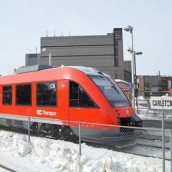
The “new” Ottawa’s Trillum Line
25 Mar 2015
Ottawa’s C$60·3m O-Train capacity expansion project was officially completed on March 2, with the entry into service of six Alstom Coradia Lint 41 diesel multiple-units. However, the launch was delayed by a points failure, and services were suspended the following day owing to signalling problems.
The line has been rebranded as the Trillium Line, with the O-Train name now being used to refer to both the Trillium Line and the Confederation light rail line which is currently under construction. The Trillium Line capacity expansion project included upgrading the track, signalling and five stations on the 8 km route. The decision to adopt a centralized control system led a slight cost increase from the original estimate and a delay to the completion date. Passing loops have been installed at Brookfield and Gladstone to permit the operation of a more frequent service, with 10 to 12 min headways Monday–Saturday and a train every 10 to 15 min on Sundays. Operator OC Transport plans to increase services to every 8 to 10 min in the future. The six Coradia Lint 41 DMUs were ordered in September 2011 at cost of C$34m. They have a capacity of 260 passengers and are expected to offer lower emissions, better fuel economy and shorter stopping distances than the three Bombardier Talent DMUs in use since O-Train was launched in 2001. “Today is yet another milestone in Ottawa’s transit history”, said Mayor Jim Watson. “The completion of the O-Train Trillium Line expansion project demonstrates our city’s continued commitment to providing safe, reliable and efficient transit service. The new trains will meet the demand of growing ridership to and from the south end of Ottawa now and well into the future”.
(Source: http://www.railwaygazette.com/)
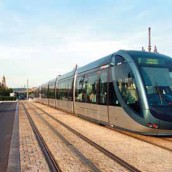
Alstom inaugurates its first Citadis tramway manufacturing line in Latin America
25 Mar 2015
Alstom has inaugurated a new production line for Citadis trams at its Taubaté plant, state of São Paulo, in Brazil. The opening ceremony was attended by local authorities, company representatives and Henri Poupart-Lafarge, President of Alstom Transport.
This new production facility – in which Alstom has invested about €15 million – will serve the Brazilian market and, in a near future, the Latin America region where a number of new tramway projects are emerging. When fully operational, the facility will employ around 150 people. The first trams to be produced in Taubaté are the 32 Citadis for Rio de Janeiro ordered to Alstom within the VLT Carioca consortium in September 2013[1]. This contract is part of a program called Porto Maravilha led by the municipality to modernize the port area. The trams are expected to be delivered between 2015 and mid-2016, in time for the Olympic Games. “More than a transport mode, the tramway redesigns the cities and offers their residents with sustainable, comfortable and accessible mobility. It has already been adopted by a larger number of cities around the world over the last decades. With no doubt, this trend is now starting in Brazil and this is why Alstom has invested in this new manufacturing line to accompany tramway projects not only for Brazil but also for all Latin America,” says Michel Boccaccio, Senior Vice President for Alstom Transport in Latin America. The production line is 16,000 sq meters and is able to produce about 7 or 8 trams per month. The factory adopts state-of-the-art environmental practices with, for example, the use of rain water to test the leakage of the train.
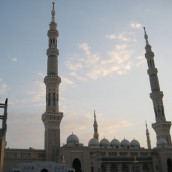
Design studies for Medina metro
25 Mar 2015
The Medina Metro Development Authority (MMDA) has just awarded Egis, in association with Systra, a contract to carry out the design studies of the future metro network in Medina. The contract relates to three lines (green, blue, red) stretching a total of 95 km, including 25 km underground and 48 km overhead.
The project is part of an ambitious plan initiated over the past few years by Saudi Arabia to develop and modernize its transport infrastructure. As the second holiest city in the country, Medina has to deal with an influx of several million pilgrims each year. The metro is due to enter into service in 2020, with the project divided up into two distinct phases. The consortium will be tasked with carrying out the feasibility studies and the preliminary design for the metro, including the preparation of invitation to tender documentation for “Design and Build” contracts. Over a 12-month period, the project team based in Medina will draw on all of Egis’ expertise required for this huge project: civil engineering, architecture, environment, rolling stock, signalling, telecoms, operating strategy, etc. This new contract comes as a complementary addition to the metro services provided currently by Egis in the Middle East in the fields of project management and works supervision contracts. Indeed, since 2013, Egis has been in charge of the project management and construction supervision of three lines of the future Riyadh metro, in partnership with Systra and the American firm Parsons. Egis is also active in Qatar on the project management of the Doha metro (civil engineering of its yellow line, civil engineering and equipment of Musheireb and Education City stations), and more recently on the project management of the overhead and ground-level sections of the Doha metro.
(Photo: Omar Chatriwala from Doha, Qatar)
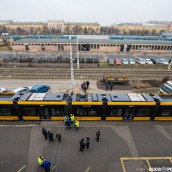
Budapest receives first CAF Urbos LRV
25 Mar 2015
BKK Centre for Budapest Transport’s first CAF tram has already arrived to Budapest and the necessary test runs will be performed in the near future. Later in 2015 and 2016 another 46 low-floor CAF trams are expected to be delivered from Spain. The trams are made in Zaragoza and Beasain, Basque Country.
The ordered CAF fleet includes 35 shorter and 12 longer versions of the trams. Following the prescribed test runs and brake tests the first CAF trams will enter passenger service from the autumn of 2015.The shorter, 34-metre-long trams will serve line 3 in Pest and later on lines 19 and 61 of the interconnected tram network in Buda. The longer, 56-metre-long trams will appear on line 1, however, the first line where passengers will get a chance to try out the brand new CAF trams will be recently refurbished line 3 serving four districts in Budapest. The CAF trams are fully low-floor, air-conditioned and equipped with onboard cameras and GPS-based passenger information systems. An advantageous feature of the technical design is that there are no seats located on top of wheel-boxes inside the passenger cabin. The shorter version can carry a total 200 passengers, 46 seated. The longer CAF trams are suitable for 345 passengers with 81 seats. The contract includes an option for a further 77 CAF trams for the Hungarian capital until 2020. The optional vehicles can be shorter or longer depending on the decision of BKK, the integrated transport organiser.
(Photo: BKK Centre for Budapest Transport/David Nyitrai)
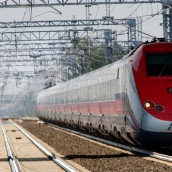
The 11th World Congress of Railway Research in Milan
25 Mar 2015
The eleventh edition of the World Congress of Railway Research will be hosted in Milan from 29 May to 2 June 2016. On an international level, this is the most important event dedicated to railway research which in 2013 was held in Sydney.
The 2016 edition will go under the title “Research and Innovation from Today Towards 2050”, in other words it will be a vision of the future of railway infrastructure, rolling stock and the management and organization of services for the next three decades. This international congress is coordinated by two Committees, (the Organizing Committee with 11 members and the Executive Committee with 16 members) made up of 24 representatives of the 7 founders and permanent members, i.e. the Transportation Technology Center, Inc. (TTCI, which is part of the Association of American Railroads), the British Rail Safety and Standards Board (RSSB), the German railways Deutsche Bahn, the French railways SNCF, the Railway Technical Research Institute (RTRI, belonging to the Japan Railways Group), Trenitalia S.p.A. (part of the FS Italiane Group) and the Union Internationale des Chemins de Fer (UIC). Added to which 3 representatives of the Unione delle industrie ferroviarie europee (UNIFE - Association of the European Rail Industry) are also part of the Committees. The Italian Organizing Committee is led by the professionalism and experience of the Ferrovie dello Stato Italiane Group and Trenitalia S.p.A.
About the 11th Congress
Over 1000 participants representing over 30 nations are expected to take part in the eleventh edition, with a panel of over 200 speakers. The Organizing and Executive Committees have decided to change formula for the Italian edition and propose an innovative format: top-class papers, an increase in the number of delegates and the creation of greater opportunities for speakers and audience to meet and exchange ideas. Each day will be divided up into three sections: a plenary session which will be followed by a session dedicated to future scenarios (Vision & Future) and two sessions on research currently underway (Today’s Research).
What’s new for 2016: e-posters and proof of concept
Two novel concepts will liven up the congress: e-posters and poof of concept stations. The first consists in being able to present traditional posters in an electronic format (known as e-posters): two stations will be set up in strategic locations in the congress facilities and each station will hold two totems divided up into 8 thematic areas. The screens will run through video contributions, each of which may contain up to four pages, providing the opportunity to publish audio and video material. This multimedia leap in poster presentation is also due to the continuous increase in the number of people who use Apps to keep up to date with the topics under discussion. The second involves providing tables (between 10 – 20) where researchers can present demonstration prototypes of their research/applications.
Exhibition of rolling stock and technical visits
On the fringe of the Congress there will be an exhibition of rolling stock set up in the Milano Fiorenza plant, used by Trenord for servicing its rolling stock, which will be dedicated to railway companies who overall will have 4 covered tracks, each measuring 300 metres, at their disposal. A number of technical visits are also planned.
The topics dealt with at WCRR 2016
In addition to the plenary sessions, the working sessions will be “Vision & Future” and “Today’s Research” which will be divided into the eight thematic areas selected by the committees: Rolling Stock – Infrastructure – Rail System – Door-to-door passenger mobility – Freight logistics – Sustainability – Economy & Politics – Operations & Safety. Each topic will be subdivided into 6 specific subject areas so that they can be discussed in greater detail. The biggest novelty is the face-to-face between the audience and the speakers. Finally, 11 awards will be presented: eight for the best papers (one for each topic under discussion), one for the best paper from a young researcher (under 30), one for the best e-poster and one for the best proof of concept.
Submission of abstracts by 30 April 2015
The deadline for submitting abstracts by anyone wishing to present his/her paper at the next edition of WCRR is this coming 30 April, with registration on-line. By 31 October 2015 the abstracts which have been accepted will be announced and by the end of 31 January 2016 the written papers must be handed in so that final revision can be carried out.
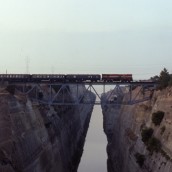
Italcertifer’s Greek contract for railway certification
23 Jan 2015
Italcertifer, a company of the Gruppo Ferrovie dello Stato, is one of the best railway certification companies in the world. In Greece, it is now the only Designated Body (Debo), meaning that it is the only company that can offer its customers the entire certification process in the context of rail transport. The new title allows the Company to certify rail systems and subsystems in accordance with Greek national regulations. Italcertifer was already Notified Body (NoBo), a subject that may issue certificates with regard to European interoperability standards. The Accreditation Ministerial Decree for Italcertifer as Designated Body was signed in recent days by the Greek Deputy Minister for Infrastructure, Transport and Communications, Michalis Papadopoulos. The fact that Italcertifer was chosen for this important role confirms its reliability and credibility, established through many years of activity in Italy, Greece, Turkey, Poland, countries in the Arabian Gulf, India, China and Australia.
Photo: by Phil Richards from London, UK – with licence CC BY-SA 2.0 – Wikimedia Commons
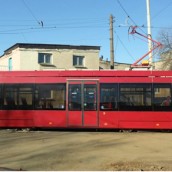
Single-section tram on test
23 Jan 2015
Belkommunmash’s first Type BKM-802 single-section tram has entered trial service on the 11 km line linking the city of Navapolatsk with a nearby petrochemical complex. Derived from the articulated BKM-843/84300M design, the 1524 m gauge four-axle BKM-802 is intended as a low-cost vehicle for use on smaller networks. The 15·5 m long tram partially low-floor, with 37% of the floor at 370 mm and the remainder at 750 mm above the rail. There are 28 seats and space for 137 standing passengers, with a ramp for wheelchair access. The interior has LED lighting and a passenger information system. Four IGBT controlled 50 kW traction motors give a maximum acceleration of 1·2m/s2 and speed of 62km/h. Belkommunmash is a Belarusian manufacturer of electric public transport vehicles. The enterprise was based on a tram and trolley bus repair facility which was opened in 1974. Today it is the leading industrial enterprise in Belarus in the field of manufacture and major overhaul of rolling stock for electric transportation in cities.
Source: http://www.railwaygazette.com/ - Photo: tn_by-belkommunmash-tram-bkm-802
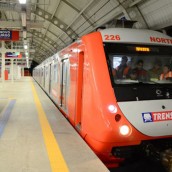
Alstom delivers the last metro train to Trensurb, in Porto Alegre
23 Jan 2015
Alstom delivers the last of the 15 Metropolis trains to Empresa de Trens Urbanos de Porto Alegre (Trensurb), following a contract signed in 2012. After it enters into commercial operation, the train will contribute to urban mobility improvements in the city of Porto Alegre, in the south of Brazil. Manufactured at Alstom Transport plant in Lapa, São Paulo, this new train will be able to carry around a thousand passengers. It has a modern design, high performance air-conditioning with automatic temperature control and a system of alternating current traction that allows recovering energy while braking. The train will also be equipped with information and communication systems that include CCTV with data recorder, offering greater security to the passengers. The trains are part of Alstom Metropolis range. They are made in stainless steel and feature four large automatic doors per car and wide corridors that ensure greater fluidity and accessibility for passengers, especially those with reduced mobility. “It is gratifying to conclude one more project on time and to be part of the mobility changes of the cities in Brazil”, says Michel Boccaccio, Senior Vice President for Alstom Transport in Latin America. Alstom’s Metropolis is a world leading, proven, safe and reliable train that serves many of the great global cities including Panama, Singapore, Sao Paulo, Shanghai and Amsterdam with more than 10 years of operational experience. About 4500 Metropolis cars have been sold worldwide since 1998.

Ethiad Rail “close” to phase 2 launch
23 Jan 2015
Etihad Rail, which is developing the railway network in the United Arab Emirates, says it is close to proceeding with construction of the long-awaited second phase of its network. Tenders for the project were issued as long ago as 2012 but the 628km project, which will provide a link from Habshan to Oman via Al Ain, and will connect with the UAE’s three major ports at Khalifa, Dubai and Mussafah, and extend the existing line from Ruwais to the Saudi Arabian border has failed to progress.However, Etihad Rail acting CEO Mr Faris Saif Al Mazrouei told delegates at the GCC Rail and Metro conference in Muscat, Oman, on January 11 that the project, which is estimated to cost $US 11bn, is close to receiving the green light from the UAE government. “Stage two is with the government right now,” Al Mazrouei said. “They’re reviewing all of the documents as we speak. We’re almost there; all the work has been done. I know the contractors have been waiting, but it’s a lot of money that the country has got to spend and we have to answer all of the queries from the government.” Al Mazrouei told the conference that testing and commissioning of the first phase, the 264km line from Shah to Habshan and Ruwais, is close to completion, with the first completed section of the railway already carrying granulated sulphur. In addition, Al Mazrouei also expressed his desire to proceed with the third phase of the national railway project, which will add 279km to the network and provide a connection to the northern regions of the country.
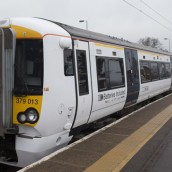
Britain’s first battery-powered train
23 Jan 2015
The first battery-powered train to run on Britain’s rail network in more than half a century carries its first passengers the second week of January 2015. This marks an important milestone in the project to demonstrate the viability of an eco-friendly battery-powered train for the twenty-first century. The new train contributes to Network Rail’s commitment to reduce its environmental impact, improve sustainability and reduce the cost of running the railway by 20 per cent over the next five years. It could ultimately lead to a fleet of battery-powered trains running on Britain’s rail network which are quieter and more efficient than diesel-powered trains, making them better for passengers and the environment. Network Rail and its industry partners – including Bombardier, Abellio Greater Anglia, and the Rail Executive arm of the Department for Transport (which is co-funding the project through the FutureRailway innovation programme) – recognise the potential for battery-powered trains to bridge gaps between electrified parts of the network and to run on branch lines where it would be too expensive to install overhead electrification.” Following its successful retrofitting and trials at test tracks in Derby and Leicestershire last year by Bombardier, the modified Class 379 Electrostar battery-powered train – also known as an Independently Powered Electric Multiple Unite (IPEMU) – will run in weekday timetable service for five weeks between Harwich International and Manningtree stations in Essex. Network Rail Principal Engineer James Amborsel said: “We’ve made terrific progress with this project so far and seeing the battery-powered train in timetabled service is a huge step forward. “After months of engineering and testing, the train is running just as we would like it. We’ll be using this five-week period to gather data on how it handles during passenger service – most travellers will recognise how quiet and smooth the ride is compared to a diesel-powered train.” James continued: “We are always looking for ways to reduce the cost of running the railway and make it greener too. This project has the potential to contribute significantly towards both those goals.” Rail Minister Claire Perry said: “This is a major milestone in this innovative project, and further proof of our commitment to deliver a world-class rail network fit for the 21st century. “These trains potentially offer a real alternative where diesel or electrified services aren’t suitable, and I look forward to seeing the results of the trials.”

High-Speed Rail Authority Hosts Official Groundbreaking Ceremony
23 Jan 2015
Marking significant progress toward modernizing, on 6th January California’s transportation infrastructure, the California High-Speed Rail Authority, joined hundreds of supporters and government, student, community, transportation, business and labor leaders to break ground on the nation’s first high-speed rail system in Fresno. “What is important is the connection that we are rooted in our forebears and we are committed and linked to our descendants” – said Governor Edmund G. Brown Jr. at a ceremony held at the site of the future high-speed rail station in downtown Fresno. “And the high-speed rail links us from the past to the future, from the south to Fresno and north; this is truly a California project bringing us together today”. In addition to the support of federal, state and local dignitaries, there was strong backing from Central Valley and California-based construction crews, small businesses, and local students who were eager to highlight how high-speed rail is positively affecting California today and will continue to into the future. “We now enter a period of sustained construction on the nation’s first high-speed rail system – for the next five years in the Central Valley and for a decade after that across California” – said High-Speed Rail Authority Board of Directors Chairman Dan Richard. “This is an investment that will forever improve the way Californians commute, travel, and live. And today is also a celebration of the renewed spirit that built California”. The ceremony included remarks from owners of a family-owned steel manufacturer already benefitting from high-speed rail construction. Student leaders from Fresno State and University of California, Merced also explained how high-speed rail is creating new local opportunities. Although today represented the official groundbreaking ceremony, the event also showcased ground that has already been broken in the Central Valley. The Authority provided tours of nearby construction activity, including various demolition sites. Other achievements to date include finalization of project designs, ongoing right-of-way purchases, and workforce training and mobilization. Local and statewide small businesses are completing a majority of this work. As of September 2014, 40 small businesses have active contracts valued at $296 million on Construction Package 1, a 29-mile stretch from Avenue 17 in Madera County to East American Avenue in Fresno County. This phase of construction includes 12 grade separations, two viaducts, a tunnel, and a bridge over the San Joaquin River. California-based Tutor Perini Zachry/Parsons (TPZP), A Joint Venture, is designing and building this first phase of the project.
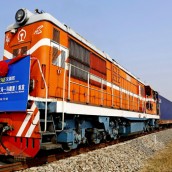
The first direct rail from China to Spain
23 Jan 2015
The first direct rail freight service to operate between China and Spain arrived at ADIF’s Madrid Abroñigal intermodal terminal on December 9, welcomed by Spanish Development Minister Ana Pastor. Carrying a total of 30 containers, the train had left Yiwu in China on November 18, covering 13 000 km in 21 days. The route via Kazakhstan, Russia, Belarus, Poland, Germany and France involved a change of gauge at three border crossings, as well as locomotive changes approximately every 800 km. The service was operated by InterRail Services and DB Schenker Rail, with DB’s Spanish subsidiary Transfesa providing traction on the final leg to Madrid. The through service is the result of initiatives agreed by the governments of China and Spain in September 2014 to develop closer trading relations. The Spanish Ministry of Development points out that the trial has demonstrated the ‘reliable, versatile and competitive’ nature of rail freight, the overland journey having saved over 10 days of transit time compared to sea freight.
Source: http://www.railwaygazette.com/
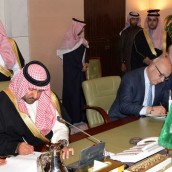
Signed in Riyadh the biggest ticketing contract in the world
23 Jan 2015
Indra has signed a €266 M contract to implement the entire ticketing and access control technology in the new public transportation system currently under construction in the capital of Saudi Arabia, Riyadh. ArRiyadh Development Authority (ADA), the company responsible for modernizing Riyadh’s infrastructures, has chosen Indra’s bid as a winning bid after an international public tender involving 10 leading multinational companies. This is the biggest ticketing project in the world up-to-date, to be completed in 54 months, and it includes maintenance and technological assistance for 10 years. The Governor of Riyadh, Prince Turki bin Abdullah bin Abdul Aziz, Chairman of the High Comission for the Development of Arriyadh and Chairman of the High Ministerial Committee for the Riyadh Public Transport Project and Indra’s Executive Vice President, Eduardo Bonet signed the contract on Monday January 05th in Riyadh. In Riyadh, Indra will develop the entire advanced pricing management system for the city’s public transportation network. This includes a ticketing control center with information from the various systems, financial management software, the operator clearing house, and other value-added systems for commercial management. Indra will provide onboard ticket sale and validation systems for the entire public bus network, which will include around 800 to 1,000 vehicles; and the sale and access control systems for more than 80 stations in six subway lines (this network will total 175 kilometers and serve about six million users). Thanks to contactless technology, users will be able to access the entire public transportation system using only one card, which they can validate quickly and easily by placing it near the reader. This solution will also include one-way tickets with a bar code (similar to the tickets for the high-speed service in Spain) and a cell phone payment application that uses NFC (Near Field Communication).

Sydney transport electronic ticketing system
23 Jan 2015
After more than a decade of delays, public transport tickets in Sydney are finally going electronic, with a trial set to commence on Sydney Ferries in December. NSW Transport Minister Gladys Berejiklian said that commuters would be able to use a single card to pay for tickets on ferries, trains, buses, and light rail by 2015. The so-called Opal card will be available on all Sydney ferries and some trains in 2013, with buses and light rail to come on line two years later, Berejiklian said: “This is something that will change the way we use public transport. It will be an easy system, where commuters simply have to tap on and tap off, and it will be like having an e-tag in your pocket”. The announcement has been a long time coming, with an e-ticketing system first proposed by the former Labor government in 1997 to be in place in time for the 2000 Olympics. That plan was scrapped, and a long-running dispute between the NSW government and the sacked developer of the previous e-card was only settled in February this year. Berejiklian said that the first commuters to have access to the card will be patrons on the Neutral Bay ferry route in a trial of the system from December 7. She said that fares would remain the same during the Neutral Bay trial, while further announcements on charges would be made during the system’s rollout. The Opal card itself will be free, with public transport users putting money on it in a similar way to the e-tag for cars. Berejiklian said that a big benefit of the Opal card will be that after eight journeys using it in a given week, all further trips will be free. She also said that there would be a daily travel cap of AU$15 from Monday to Saturday for Opal card customers, with a cap on Sundays of AU$2.50. She expects that there will be a “few glitches” during the rollout, and said that’s why the single card system is being implemented progressively.
Source: http://www.zdnet.com/ - Photo: Beau Giles
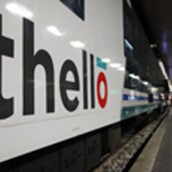
Thello to launch Marseilles-Milan service
25 Nov 2014
Open-access long-distance operator Thello announced on October 30 that tickets have gone on sale for its new Marseilles – Milan service, which is due to begin operating next month.The daily service will call at Nice, Monaco and Genoa and each train will be formed of 1 or two first class coaches and six or seven standard class vehicles providing a total of 450-600 seats depending on demand. Thello says the recently-refurbished rolling stock will be provided by Trenitalia.The first Milan – Marseilles service will run on December 14, with Marseille – Milan services set to start the following day. The new Thello service from Marseilles to Milan, calling at Nice, Monaco and Genoa, will take tourists and cross-border employees from France to Italy (and vice versa), with no changes and at very reasonable prices, between 30 and 70 euro for the Marseilles-Milan trip (second class).Tickets will be available online and at Trenitalia ticket offices, as well as Thello self-service ticket machines, which will be installed at Marseilles Saint-Charles, Toulon, Nice, Monaco, and Menton stations in time for the launch. Tickets for domestic trips on the route are also available. Bookings can now be made for domestic Italian trips. French trips can be booked as of mid-December. Thello plans to launch two additional Nice – Milan services next April, increasing the service to three trains per day on this section of the route. After a difficult year in 2013, which concluded with the withdrawal of its Paris – Rome overnight service in December, the Transdev-Trenitalia joint venture says traffic levels are looking positive with 345,000 passengers using its trains so far this year, a 12% increase compared with the same period in 2013. Press Release and Photo by Thello
The new Thello service from Marseilles to Milan, calling at Nice, Monaco and Genoa, will take tourists and cross-border employees from France to Italy (and vice versa), with no changes and at very reasonable prices, between 30 and 70 euro for the Marseilles-Milan trip (second class).Tickets will be available online and at Trenitalia ticket offices, as well as Thello self-service ticket machines, which will be installed at Marseilles Saint-Charles, Toulon, Nice, Monaco, and Menton stations in time for the launch. Tickets for domestic trips on the route are also available. Bookings can now be made for domestic Italian trips. French trips can be booked as of mid-December. Thello plans to launch two additional Nice – Milan services next April, increasing the service to three trains per day on this section of the route. After a difficult year in 2013, which concluded with the withdrawal of its Paris – Rome overnight service in December, the Transdev-Trenitalia joint venture says traffic levels are looking positive with 345,000 passengers using its trains so far this year, a 12% increase compared with the same period in 2013. Press Release and Photo by Thello
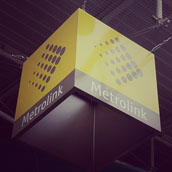
Manchester Metrolink Airport extension opens
25 Nov 2014
Passenger operations began on the 14.5 km extension of Manchester’s Metrolink light rail extension from St Werburgh’s Road to Wythenshawe and Manchester Airport on November 3, more than a year ahead of schedule. Services operate at 12-minute intervals between the airport and currently terminate at Cornbrook, where passengers can change onto services into the city centre. However services from the airport will be extended into the centre of Manchester when the Second City Crossing is completed in 2017. The airport line has 15 stations, including a 300-space park-and-ride facility at Sale Water Park, which is located near the M60 highway. Theopening of the line was marked with a visit from Britain’s Chancellor of the Exchequer Mr George Osborne, who announced that central government powers for transport investment will be devolved to the city of Manchester. Under the plans Metrolink will come under the powers of a the city’s elected mayor, supporting the rollout of contactless smartcard ticketing system. Transport for Greater Manchester (TfGM) says the move will also enable it to implement the £350m 5.5km Metrolink extension to Trafford Park “as a priority.”
Source: http://www.railjournal.com/
03 November 2014
Photo: Nicholas Smale (Metrolink Cube)
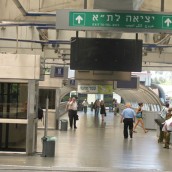
Israelis do well
25 Nov 2014
Israel Railways (IR) reported promising results for the first six months of 2014, with freight traffic volumes of 3.61 million tonnes compared with 3.47 in the corresponding period of the previous year. IR largely attributes a significant improvement in punctual operation (85% on-time trains compared with 45%) to many new locomotives and wagons in service. In addition, these made it possible to run more trains than previously. Passengers carried total led 23.5 million – an 8% rise – with fare revenue improving by 10$. The opening of new lines and improved performance are expected to result in total ridership of 48 million for the full year.
Source: http://www.railwayafrica.com
28 October 2014
Photo: לכ-ןיערג תידוהי Yehudit Garinkol
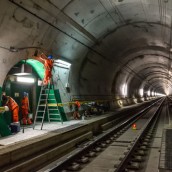
Last sleeper laid in the Gotthard Base Tunnel
25 Nov 2014
On Wednesday, October 31, 2014, the last rails were laid in the Gotthard Base Tunnel. At a distance of around 54 m from the south portal, the contractor cast the “golden sleeper”. A big moment for everyone involved and an important milestone for the project. The pure laying time was 39 months. 290 km of track have been laid. The entire 57 km of the world’s longest railway tunnel can now be continuously travelled by diesel locomotives. At exactly 12.00 noon, the concreting train that was specially developed for the Gotthard Base Tunnel was used for the last time. At a formal ceremony in the tunnel, the “golden sleeper” of the ballastless track was cast. In total, the general contractor, Transtec Gotthard, has used around 131,000 m3 of concrete, transported 380,000 monolithic sleepers into the tunnel, and laid 290 km of rails. Around 125 workers were in action in shifts, 24 hours a day, seven days a week. The ballastless track in the Gotthard Base Tunnel is an important factor for installation of the railway infrastructure systems. It makes rail-based transport possible for all subsequent work operations. With the end of track-laying, the first major area of the railway infrastructure systems is complete. Renzo Simoni, CEO of AlpTransit Gotthard Ltd, expressed his great satisfaction: “An important milestone in the Gotthard Base Tunnel has been accomplished on time. The work is on schedule. The timetable for opening in June 2016 is valid.” Marco Hirzel, CEO of Transtec Gotthard, also showed pleasure at the achievement: “Installing the railway infrastructure systems in the world’s longest railway tunnel is a very challenging task. Only thanks to the collaboration of all of the approximately 720 people who are working on this project, can we achieve our goal of punctual handover of the tunnel.” All other work on the Gotthard axis is also on schedule. The surface installation sites along the Gotthard Base Tunnel have already been removed and recultivated. In autumn 2015, test operation in the entire Gotthard Base Tunnel will begin. On June 2, 2016, and at the following weekend, the opening celebrations for the Gotthard Base Tunnel will be held. Integration into the SFR network with scheduled train services will take place in December 2016. In the Ceneri Base Tunnel, excavation work is progressing rapidly: 85% of the entire tunnel system has already been cut. Now that the Federal Supreme Court has confirmed the original awards, planning and implementation of the railway infrastructure systems can also proceed. The date of December 2019 for opening the Ceneri Base Tunnel to commercial operations that was already planned therefore remains the goal of AlpTransit Gotthard Ltd.
Press Release and photo by Alp Transit Gotthard LTD
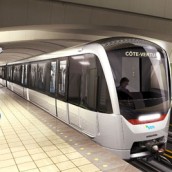
Oran plans to launch metro tender in 2015
25 Nov 2014
Plans to build the first metro line in Oran, Algeria’s second city, have been completed and it is hoped to launch a tender for the first phase in the first quarter of 2015. Algerian Metro Enterprise (EMA), the organization responsible for metro and light rail projects in Algeria, appointed Sener, Spain to draw up plans for the city’s first metro line. Sener has now defined the route for a 19 km line with 20 stations, running from Bouakeul in the west via the Great Market, Palais des Sports, the main station, Wilaya, Hai Essabah, and the Olympic Stadium to the University. There would also be branch from Wilaya to the city centre. The first phase would run from Bouakeul to Hai Essabah and include a depot. “The design has been done by Sener, and the only decision we now have is whether we go turnkey or separate out the system and the rolling stock,” Mr Aomar Hadbi, EMA’s director general, told delegates attending MEED’s recent Mena Rail and Metro Summit in Dubai. The first line would be fitted with rigid catenary and stations would be designed for installation of platform screen doors. It would be operated by a fleet of 74m-long four-car trains each able to accommodate 626 passengers. It is hoped to open Line 1 in 2020. The metro would interchange with Oran’s 18 km light rail line, which opened in May 2013, at the main station. The city also plans to build a second light rail line to serve the northeast of Oran, as well as a second metro line.
Algerian Metro Enterprise (EMA), the organization responsible for metro and light rail projects in Algeria, appointed Sener, Spain to draw up plans for the city’s first metro line. Sener has now defined the route for a 19 km line with 20 stations, running from Bouakeul in the west via the Great Market, Palais des Sports, the main station, Wilaya, Hai Essabah, and the Olympic Stadium to the University. There would also be branch from Wilaya to the city centre. The first phase would run from Bouakeul to Hai Essabah and include a depot. “The design has been done by Sener, and the only decision we now have is whether we go turnkey or separate out the system and the rolling stock,” Mr Aomar Hadbi, EMA’s director general, told delegates attending MEED’s recent Mena Rail and Metro Summit in Dubai. The first line would be fitted with rigid catenary and stations would be designed for installation of platform screen doors. It would be operated by a fleet of 74m-long four-car trains each able to accommodate 626 passengers. It is hoped to open Line 1 in 2020. The metro would interchange with Oran’s 18 km light rail line, which opened in May 2013, at the main station. The city also plans to build a second light rail line to serve the northeast of Oran, as well as a second metro line.
Source: http://www.railjournal.com/
31 October 2014
Photo: www.bombardier.com
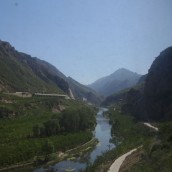
The new Rail Policy in Mongolia
25 Nov 2014
A new National Rail Policy (“Rail Policy”) was approved by a strong majority of the Mongolian Parliament. The new Rail Policy includes the extension of rail from Erdenet to Ovoot and on to the Russian border at Arts Suuri (“Northern Rail Line”). This represents a new important rail connection between Russia, Mongolia and through the Trans-Mongolian Railway to China. The Rail Policy also stipulates the required rail gauges for specific rail lines in Mongolia’s south. The Mongolian Government is now empowered to negotiate a Concession Agreement for the railway between Erdenet to Ovoot as the first stage of the Northern Rail Line. This Rail Policy decision follows the recent addition of the Erdenet to Ovoot railway onto the Mongolian Government’s Concession List of “Approved Projects”. In the medium term, the Erdenet to Ovoot railway is positioned to form a critical link within a highly strategic rail network connecting the Ulug Khem coking coal basin in Russia’s south with the Trans- Mongolian Railway through to China. The Ulug Khem coking coal basin is estimated to contain approximately 2.5 billion tonnes of metallurgical coal reserves and when combined with Aspire’s wholly owned Ovoot Coking Coal Project (“Ovoot Project”), will represent a major new long term source of high quality coking coal. Exports from this very large coal basin in Russia to China are expected to provide substantial transit freight volumes for both the Erdenet to Ovoot railway and the Trans-Mongolian Railway.
Press Release of Aspire Mining Limited
Photo: Clay Gilliland
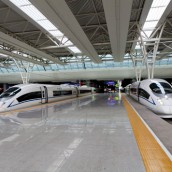
Contract awarded for Mexico City – Querétaro high speed line
25 Nov 2014
On November 3 the federal Secretariat of Communications & Transport announced that a consortium including China Railway Construction Corp and CSR had been selected for the turnkey contract to build, operate and maintain a high speed line between Mexico City and Querétaro. Including rolling stock and other railway equipment, the cost of the project is 50∙82bn pesos.As well as the Chinese suppliers, the consortium also includes four Mexican civil works contractors: Constructora y Edificadora GIA, Prodemex, GHP Infraestructura Mexicana and Constructora Teya. Systra will be involved in operating the new high speed line.The 210 km route from Mexico City to Querétaro will include 15∙9 km on viaduct and 11∙6 km in tunnel. A fleet of eight-car trainsets, each able to accommodate 426 passengers, would operate at up to 300 km/h. High speed services are expected to carry 27,000 passengers/day during the first year of operations. It is forecast that over 18,000 road vehicles would be removed from the motorway between Mexico City and Querétaro, cutting CO2 emissions by 95,000 tonnes/year.
Source: www.railwaygazette.com
04 November 2014
The trains for the new line will be similar to the CRH380A EMUs CSR has already supplied to CRC in China and MTR in Hong Kong, as in the picture.
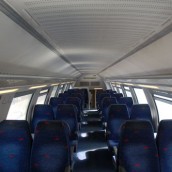
First Indian double-deck train
25 Nov 2014
Coaches seating 110 people characterize India’s first double-deck passenger train, to be introduced between Luckow and Delhi in the second week of November. Test runs will be completed by the end of October. The train comprises 12 fully air-conditioned coaches.The seating capacity would be 105 instead of 70 as in a standard coach, but overall height would only increase by 10 cm.
Source: http://www.railwayafrica.com. 21 October 2014
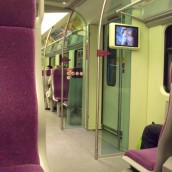
Malaysia High-Speed Rail
25 Nov 2014
Construction of the new 325 km high-speed line from Singapore to Kuala Lumpur is expected to start 2015. It will reduce travel time from six or more hours to 90 minutes. There are to be intermediate stations at Putrajaya, Seremban, Ayer Keroh, Muar, Batu Pahat and Nusajaya. Singapore is currently working on its own feasibility study.
Source: http://www.railwayafrica.com
Photo: Guillaume G.
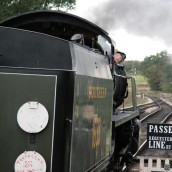
Seeing machines signs up EMD
25 Nov 2014
Seeing Machines Ltd. Said it “had signed a strategic agreement with Electro-Motive Diesel, Inc (EMD), a subsidiary of Progress Rail Services Corporation (a Caterpillar Company) to develop and adapt its technology for the rail industry.
 Australia-based Seeing Machines Limited specializes in in-cab, real-time driver-safety monitoring. It developed its patented system through appreciation of the significance of driver fatigue when the underlying cause of many accidents is identified. Seeing Machines’ driver-safety system (DSS) monitors fatigue and distraction events, enabled by intelligent sensing technologies and analytics. The company works closely with select research and development partners to refine eye-tracking, head movement and gaze-tracking technologies. Following a “global alliance agreement” signed with Caterpillar Global Mining in 2013, it is claimed that fatigue and distraction events were reduced by an average of 80% in mines around the world, through real-time monitoring and intervention. On 22 September 2014, Seeing Machines Ltd. Said it “had signed a strategic agreement with Electro-Motive Diesel, Inc (EMD), a subsidiary of Progress Rail Services Corporation (a Caterpillar Company) to develop and adapt its technology for the rail industry”. “We are excited to be working with EMD,” said Seeing Machines CEO Ken Kroeger. “Our operator-facing cameras and accelerometer sensors provide key streams of data that are designed to help improve productivity and safety outcomes. I believe we are providing this in the challenging industrial applications of mining, and we expect to achieve the same positive results working with EMD in rail transport.” Progress Rail and EMD President and CEO Billy Ainsworth said. “There have been significant steps in recent years to enhance safety in the rail industry, and today’s announcement builds upon those advancements. Working with Seeing Machines, we can develop the on-board technology designed to deliver enhanced safety to our customers and their fleets by ensuring operators remain alert while controlling the locomotive”.
Australia-based Seeing Machines Limited specializes in in-cab, real-time driver-safety monitoring. It developed its patented system through appreciation of the significance of driver fatigue when the underlying cause of many accidents is identified. Seeing Machines’ driver-safety system (DSS) monitors fatigue and distraction events, enabled by intelligent sensing technologies and analytics. The company works closely with select research and development partners to refine eye-tracking, head movement and gaze-tracking technologies. Following a “global alliance agreement” signed with Caterpillar Global Mining in 2013, it is claimed that fatigue and distraction events were reduced by an average of 80% in mines around the world, through real-time monitoring and intervention. On 22 September 2014, Seeing Machines Ltd. Said it “had signed a strategic agreement with Electro-Motive Diesel, Inc (EMD), a subsidiary of Progress Rail Services Corporation (a Caterpillar Company) to develop and adapt its technology for the rail industry”. “We are excited to be working with EMD,” said Seeing Machines CEO Ken Kroeger. “Our operator-facing cameras and accelerometer sensors provide key streams of data that are designed to help improve productivity and safety outcomes. I believe we are providing this in the challenging industrial applications of mining, and we expect to achieve the same positive results working with EMD in rail transport.” Progress Rail and EMD President and CEO Billy Ainsworth said. “There have been significant steps in recent years to enhance safety in the rail industry, and today’s announcement builds upon those advancements. Working with Seeing Machines, we can develop the on-board technology designed to deliver enhanced safety to our customers and their fleets by ensuring operators remain alert while controlling the locomotive”.
Source: http://www.railwayafrica.com 30 September 2014
Photo: Karen Roe from Bury St Edmunds, Suffolk, UK – Bluebell Railway 22-10-2010
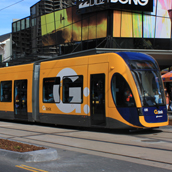
Bombardier Celebrates the Opening of Queensland’s Light Rail System on the Gold Coast in Australia
16 Sep 2014
Rail technology leader Bombardier Transportation is celebrating the start of passenger services on the Gold Coast light rail system in Queensland, Australia. The GoldLinQ consortium has successfully delivered the 13 km light rail line with 16 stations and 14 distinctive, modern BOMBARDIER FLEXITY 2 trams in just three years, as part of an 18-year Public Private Partnership with the Government of Queensland and the Gold Coast City Council.
Phil Mumford, Chief Executive Officer, GoldLinQ said: “Stage one of the Gold Coast light rail is all about connecting the city’s key precincts and providing sound transport infrastructure around which the city can grow. Now that light rail is here, citizens can choose to live, work and travel in new and different ways in and around the Gold Coast.”
Pierre Attendu, President, Systems Division, Bombardier Transportation, added: “Bombardier and our partners in the GoldLinQ consortium have delivered to the Gold Coast a first-class light rail system from which a truly integrated and sustainable transport network will flourish.”
The new light rail corridor connects the new Gold Coast University Hospital and Griffith University with the key activity centres of Southport, Surfers Paradise and Broadbeach. It promises to improve the liveability of the Gold Coast significantly by improving accessibility while reducing the effects of congestion that come with a rapidly growing city. Each of the new trams has capacity for 308 passengers with seating for 84, and the overall system has been designed to accommodate up to 75,000 passengers per day.
Bombardier has delivered the electrical and mechanical (E&M) scope including the new electrically powered, low-floor FLEXITY 2 trams. The trams’ outstanding visual design has already been recognised with a Good Design® Award in the automotive and transport category. The Australian Good Design Awards are Australia’s longest standing national design award and promotion program.
Each tram is 43.5 m long, 2.65 m wide and 3.6 m high. The trams are bi-directional with a cab at each end and have a top speed of 70 km/h. Inside features include comfortable seating, air conditioning, wheelchair spaces and multipurpose areas for luggage and prams, as well as surf board racks.
As part of its turnkey system package, Bombardier also delivered signalling and control systems, communications systems, electrification including traction power supply substations and overhead line equipment (OHLE). In addition, it provided project management, systems engineering and integration, testing and commissioning for the new LRVs and signalling system. At the depot, Bombardier supplied depot and plant equipment and will now provide the vehicle maintenance for a period of 15 years.
Trams and light rail vehicles are the most energy efficient mode of transportation, consuming up to five times less energy per passenger than cars travelling with an average of between one and two people. Bombardier’s fully customisable trams and LRVs have a recyclability rate of approximately 92 per cent and a recoverability rate of about 98 per cent (recycling + energy recovery). They are designed for sustainable mobility throughout their life cycle. To date, 3,500 trams and light rail vehicles from Bombardier have either been ordered or are already operating in about 100 cities in more than 20 countries around the globe.
GoldLinQ is a group of companies consisting of GoldLinQ Pty Ltd, McConnell Dowell Constructors Pty Ltd and KDR Gold Coast Pty Ltd. Bombardier Transportation Australia Pty Ltd is part of the D&C Joint Venture, GoldLinq’s sub-contractor responsible for the design and construction of the system.
Press Release of Bombardier, 21 July 2014
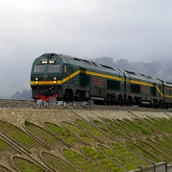
New Tibetan rail line a boost for region
16 Sep 2014
A modern railway linking the two largest cities in the Tibet autonomous region started operation on Saturday, and many Tibetans said the line will greatly improve their quality of life. With an investment of 13.2 billion yuan ($2.1 billion), the 251-kilometer high-elevation railway, the second railroad in Tibet, will cut travel time between Lhasa, the regional capital, and Xigaze, the second-largest city in the region, from five hours (by bus) to about two hours. Tickets for the new line became sought-after since going on sale on Thursday night. All seats on Saturday’s service had been booked before 3 pm on Friday. The first passenger train was expected to leave Lhasa for Xigaze at 9 am on Saturday. A ticket for the trip from Lhasa to Xigaze costs 40.5 yuan, while the best seats are 175.5 yuan.
The line, which began construction in January 2011, has 14 stations and a maximum train speed of 120 km per hour. It will be capable of transporting more than 8.3 million metric tons of cargo each year. The opening of the Lhasa-Xigaze railway will “consummate the rail network in Tibet, reduce the region’s heavy dependence on road transportation, boost social and economic development as well as improve the lives of those from all ethnic groups living along the line”, said a statement from China Railway Corp, the national rail operator. The new railway will enable travelers to set out from Lhasa in the morning and arrive at scenic attractions around the Himalaya Mountains, which are located south of Xigaze, before sunset, according to People’s Daily. In the past, travelers had no choice but to make the trip on the No 318 National Highway, which is said to have many safety hazards. The average altitude of the Lhasa-Xigaze line ranges from 3,600 meters to 4,000 meters, so oxygen supply equipment has been installed under each seat to help passengers overcome altitude sickness.
“The line links Lhasa, the region’s center, with Xigaze, the most populous city in Tibet, and extends the current Qinghai-Tibet railway,” Galsang Drolma, a researcher at the China Tibetology Research Center in Beijing, said. “Its opening will significantly accelerate the speed of Tibet’s connecting with the inland transport networks.” She said Xigaze is the biggest producer of grain in Tibet and grows many other agricultural products, but farmers have suffered from poor transport conditions and were unable to do business with buyers from afar. “The line will help them sell products to the huge markets in Tibet and other provinces, thus increasing their income,” she added, noting the trains will also bring more tourists so local tourism will benefit greatly. “In addition, more travelers are coming to remote regions in Tibet, and more local residents are going out, so this will definitely promote the exchange of different cultures and create more opportunities for local people.”
Her words were echoed by Rigzin, an elderly farmer from the Gephel village of Quxu county, who said he always wanted to travel to Xigaze with his wife to go to temples there but was kept from doing so by car sickness. “Now the railway will make our dream come true. We will take the train to Xigaze after the harvest season,” he said. “We are very much looking forward to the trip because none of us has traveled by train.” Buchung, general manager of the Rinpung Darawa Barley Wine Co Ltd in Xigaze, said the railway will reduce the company’s transport costs and enable it to expand its market share in Lhasa.
Source: www.chinadaily.com.cn, 16 August 2014
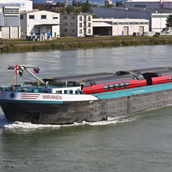
Spectacular transport of double-decker trains for Aeroexpress
16 Sep 2014
The first six-carriage double-decker train for railway company Aeroexpress has begun its ship journey from Muttenz BL via Amsterdam to the Baltic Sea right on time. The trains will be used on the lines running from the city centre of Moscow to the three airports. The first four of a total of 25 trains are being built by Stadler Rail in Altenrhein SG on Lake Constance. They need to be transported as part of a well-planned exercise via Basel (Muttenz), Amsterdam and Sassnitz on the Baltic Sea to the Stadler factory in Minsk. As the trains in all CIS countries are essentially taller and wider than in the rest of Europe, rail transport is not an option.
Even the first leg from Altenrhein SG to the river harbour at Muttenz BL provided a few challenges for the companies involved. In consultation with the authorities and the police in all the cantons passed through, a road route needed to be found which was even accessible with a vehicle of such massive proportions. Not only did height have to be considered, for example in order to prevent getting stuck when passing under a bridge, but width and length also had to be factored in. The latter two were most often an issue at crossroads.
After 13 months of planning, the transport project went ahead in mid-August, and the six carriages of the first train reached Muttenz BL in good time for the scheduled loading date last Saturday. Transport was then able to continue on a ship on the Rhine towards Amsterdam. From Amsterdam, the trains board a coastal cargo liner to Sassnitz via the Kiel Canal. They are then transferred to the Kaunas track ferry, which works on broad-gauge tracks; this will then take the train to Klaipėda in Lithuania. From there, the train will be transported on the broad-gauge route to Minsk, where commissioning work can be completed in the new Stadler factory.
Press Release of Stadler, 9 September 2014
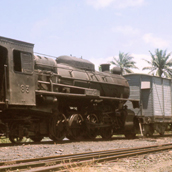
Abuja-Kaduna trains by December
16 Sep 2014
The Nigerian Federal Ministry of Transport has restated its commitment to finish construction of the new railway from the capital Abuja to Kaduna by December 2014. Official reports say the project is currently 80% complete.
Rehabilitation of the 1,124km western line from Lagos to Kano) was completed in December 2012. According to the Lagos Guardian, work on the 1,657km Eastern line (Port Harcourt to Maiduguri) “is progressing steadily with the Port Harcourt-Jos section including the branch line from Kafanchan to Kaduna to be completed by August 2014″.
All these lines use 1,067mm gauge. However, the new Abuja-Kaduna section is being constructed to 1,435mm gauge, as is a new 180km railway from Lagos to Ibadan. No information has been released about the acquisition of locomotives and rolling stock for these lines and whether sufficient will be available to work the Abuja railway when it is finished.
Source: www.railwaysafrica.com, 19 August 2014
Photo: Nigerian River Class near Port Harcourt 1974 by 8474tim at en.wikipedia
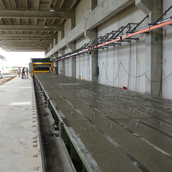
New contract signed with Prear
16 Sep 2014
WEGH Group Long-Line technology confirms its leadership in Latin America. PREAR Pretenseados Argentinos s.a., a company of the Cartellone Group, one of the most important business groups in Argentina, signed a new contract for the purchaising of a second line for the production of prestressed concrete sleepers.
On the 16th of July, in Buenos Aires, Mr Pablo Mazzucchelli, CEO of Prear and Gianpaolo Beghi, Latin America Area Manager of WEGH Group signed the contract that will double the productive capacity of the plant up to 260.000 sleepers per year. With this purchaising one of the biggest sleepers plants in Argentina will be born.
Sleepers will be used for the construction of the railway lines Mar del Plata-Buenos Aires and Buenos Aires-Rosario. At the contract signature, also Mrs.Graciela Priori, Head of the Accountant Departiment of PREAR, Mr Carlos Salvatore, Head of the San Pedro factory and Mr. Ruben Calvani, Head of the Purchaising Department, were present.
Press Release of WEGH Group, 6 August 2014
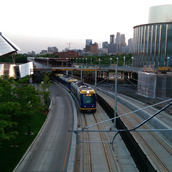
Minneapolis Metro Blue Line Extension in US obtains federal approval
16 Sep 2014
The Metropolitan Council in Minnesota has secured federal approval from US Federal Transit Administration (FTA) to begin designing the Metro Blue Line Extension in the north-west of Minneapolis. The13-mile long light rail transit (LRT) line will have 11 new stations and it will extend through north Minneapolis, Golden Valley, Robbinsdale and Crystal to Brooklyn Park. It will connect Minneapolis and the north-west communities with transitways, including the existing LRT on the Metro Blue and Green lines, future LRT on the Metro Green Line Extension, bus rapid transit on the Metro Red Line, the Northstar commuter rail line and local and express bus routes.
“Completion of these lines is the key to building a fully-developed multi-modal system to serve the people of this region.” Metropolitan Council chair Sue Haigh said: “The Blue Line Extension and the future Green Line Extension will help Minneapolis residents and those from north-west and south-west communities get to work and school, delivering on our promise of equity. “Completion of these lines is the key to building a fully-developed multi-modal system to serve the people of this region.”
Once operational in 2021, the double-tracked Blue Line Extension is estimated to have 27,000 average weekday riders by 2030. Approximately 50% of the project’s $997m budget will come from the FTA, 30% from the Counties Transit Improvement Board, 10% from Hennepin County and 10% from the state.
Source: www.railwaytechnology.com, 27 August 2014
Photo by Michael Hicks
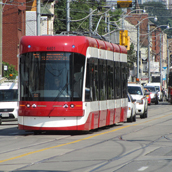
Toronto’s new low-floor trams enter service
16 Sep 2014
Toronto has begun a complete replacement of its tram fleet, with the first two new vehicles entering service in the city. Ontario is investing $416.3 million on 204 new low-floor Flexity Outlook trams to modernise Toronto’s streetcar network.
The new Bombardier-built stock, the first new generation of vehicles to operate on the TTC network in 30 years, will replace trams on all 11 lines by 2019. The first two vehicles have now entered revenue service on the 510 Spadina line. As well as the new trams, various infrastructure projects have taken place to accomodate the new vehicles, including platform modifications, upgrades to the overhead catenary and the construction of a new maintenance depot.
Source: www.globalrailnews.com, 2 September 2014
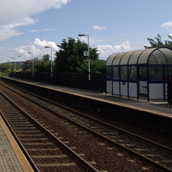
Northern Brings Security Systems To 200 Stations
16 Sep 2014
The UK’s largest rail operator, Northern Rail, has reached a landmark in its security provision and has now installed 200 CCTV facilities at its stations. In the ten years since its franchise began, Northern has increased the number of security systems from 84 to 200, making 58% more of its stations safer for customers.
Having recently installed a wave of systems in the North East at Marske, Longbeck, Southbank and Redcar East stations, Northern is demonstrating the success of taking ownership of the CCTV installation in-house. By developing this solution, costs were significantly reduced and more systems have been possible to install.
Martyn Guiver, Head of Crime Management for Northern Rail, comments: “To reach a total of 200 stations now offering peace of mind for both customers and staff, is a fantastic milestone. Many of our stations are small, positioned on rural and isolated routes, and CCTV brings a level of security we wouldn’t otherwise be able to provide.”
The installation of CCTV on Northern’s network has reduced crime by 55% since the start of the franchise against a national average reduction of 35%.
Press Release of Northern Rail, 1st September 2014
Photo by Mattbuck
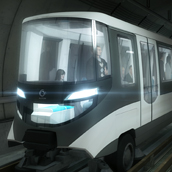
Alstom and Huawei launch the first live 4G pilot for CBTC
16 Sep 2014
Alstom launches an LTE1 (4G) pilot for the metro market to demonstrate the performance of a multi-services broadband radio network. Alstom has been working on LTE since the technology has been available from the telecom industry. This pilot will be using Huawei’s LTE technology following the Memorandum of Understanding (MoU) signed between the two companies in April 2014.
Alstom and Huawei are now ready to test the new equipment on tracks at Alstom’s Valenciennes site (France). Huawei will provide the LTE network while Alstom will provide the train and LTE-compliant onboard equipment.
With LTE, rail customers benefit from operating a single wireless infrastructure that provides mission critical voice communication, secure train signalling according to the CBTC standard and broadband data communication such as live video streaming of surveillance cameras and Passenger Information System. This will result in lower cost for the operator, more fluid and quicker passenger information and higher train availability.
This solution complements Alstom’s world leading CBTC solution Urbalis2. By the end of 2014, Alstom will be able to supply LTE technology in a converged and powerful multi-service solution. Huawei’s LTE solution has already been successfully deployed in a number of rail projects and the integration with Alstom’s CBTC solution Urbalis underlines the suitability of LTE as a converged network for rail operations.
1 – Long Term Evolution : 4th generation of radio communication based on the 3GPP standard
2 – Alstom’s Urbalis CBTC technology (Communication Based Train Control) allows real time information about the location of the trains, which substantially improves line operability and safety
Press Release of Alstom, 6 August 2014
Photo: Urbalis Fluence and Metro of Lille © Alstom Transport / Milleetuneimages
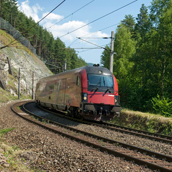
ÖBB order further nine Railjet units
16 Sep 2014
Austrian Federal Railways (ÖBB) is ordering a further nine Railjet trains from Siemens, with delivery of the seven-car units planned for December 2016. The order is worth around 145 million euros in total. ÖBB already operate 51 Railjets across Austria, Germany, Hungary and Switzerland. The new units will run on the Vienna-Salzburg western route and be equipped to operate in Italy, being deployed on the route to Venice, for example. Final assembly of the Railjets will be completed at Siemens’ plant in Vienna, while the bogies will come from the company’s plant in Graz.
“Quality is a decisive factor for us and our customers who will benefit immensely from the modernization of our train fleet with another nine railjets. Thanks to the increased profitability in passenger services, we are able to make this investment on our own and are thus investing in even greater customer satisfaction”, explains Christian Kern, CEO of ÖBB.
“Our Railjet is the hallmark of more than 160 years of Siemens’ experience in the passenger coach industry. Our Vienna plant is home to the Siemens’ World Competence Center for the development and manufacture of passenger vehicles, so we are especially delighted that ÖBB have once again placed their trust in us and expanded their Railjet fleet to no less than 420 cars”, said Jochen Eickholt, CEO of Siemens Rail Systems.
The technical design is based on the service-proven Viaggio Comfort type intercity vehicles, and the trains meet all the requirements for international high-speed rail operation. The standard configuration for the new trains consists of four different types of vehicle: a driving trailer with business and first class seating; a bistro car; and five open-saloon type cars for economy class, one of which has a zone for families with children as well as a multi-purpose area. There is an area available to disabled passengers in the bistro car, which wheelchair users can access, via a platform lift fitted to the carriage entrance, with the aid of the train’s crew. All cars are fully air-conditioned.
The new trains are equipped with the Ecojet package, composed of LED lighting and an energy-optimized air-conditioning system that uses CO2 sensors to detect the number of passengers in the carriage and adjusts its output accordingly. A Siemens research project concluded that this package could save ÖBB more than five million euros of its annual energy costs for operating the current Railjet fleet.
Railjets are propelled in push-pull mode by a Taurus locomotive, and each unit is 186 meters long, or 205 meters with the locomotive included. The trains are designed to travel at speeds of up to 230 km/h.
Press Release of Siemens, 1 August 2014
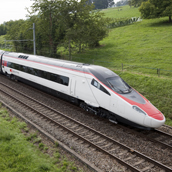
SBB to invest SFr 1.5bn in Ticino rail network
16 Sep 2014
SWISS Federal Railways (SBB) will spend around SFr 1.5bn ($US 1.66bn) on revamping stations, modernising infrastructure and acquiring new rolling stock for Ticino, Switzerland’s southernmost canton by 2020.
The first of eight ETR 610 tilting trains being supplied by Alstom, which will enter service between Zürich and Milan in December, was named Ticino at a ceremony in Lugano on August 7. At the same, the newly renovated historic part of Lugano station was inaugurated by SBB CEO Mr Andreas Meyer and the mayor of Lugano Mr Marco Borradori. Work started in February on the construction of a new main ticket hall for completion in 2016.
There are also plans to restructure the station at Bellinzona, known as the gateway to Ticino, by 2016 in time for the opening of the Gotthard base tunnel on December 11 2016.
The annual meeting between SBB and local government representatives in Ticino, which took place on the same day, underlined both parties’ commitment to the development of local rail services, including the planned expansion of S-Bahn Line S40, which will offer a cross-border connection between Mendrisio and Varese, Italy, from December.
Source: www.railjournal.com, 8 August 2014
Photo ©SBB CFF FFS

Bombardier Signs Framework Agreement with Railpool for 65 TRAXX Locomotives and Upgrade of Existing Fleet
25 Jul 2014
Rail technology leader Bombardier Transportation and the leasing company Railpool have signed a framework agreement for the delivery of 65 BOMBARDIER TRAXX locomotives, with a first call-off of 35 locomotives and an option of up to 30 additional locomotives. The total potential contract value is up to 250 million euro (340 million US). The value of the call-off based on the list price is approximately 135 million euro (184 million US).
This contract extends the operating range of the TRAXX locomotives: The MS[1] locomotive will operate on the new East-West corridor linking Poland with the Netherlands. The AC[2] locomotive will operate not only in Germany, Switzerland and Austria but also in Hungary and Romania and will be newly equipped with ETCS (European Train Control System) and Last Mile functionality. The last mile feature, an additional diesel-electric engine plus battery, enables AC locomotives to operate even in non-electrified areas such as terminals, stations or ports – changing locomotives for the non-electrified last mile is now a thing of the past.
“With this contract we continue our successful partnership with Bombardier and are able to offer our customers the proven TRAXX locomotives concept. Furthermore, we are developing with Bombardier new corridors and are upgrading our existing fleet with new safety systems, to follow our customers’ demands as a reliable partner for the future”, said Torsten Lehnert, CEO at Railpool.
“These innovative locomotives will facilitate rail operation on new, international corridors. They also allow for a much longer range and for more flexibility in operation than ever before,” added Ulrich Jochem, President Locomotives, Bombardier Transportation.
The locomotives are designed for speeds of up to 160 km/h. Bombardier will assemble the locomotives in Kassel, Germany, carbodies at its Wroclaw site in Poland and bogies in Siegen, Germany. Propulsion and controls as well as ATP (Automatic Train Protection) equipment will be manufactured at Bombardier’s sites in Mannheim and Hennigsdorf, Germany, and Västeras, Sweden.
The locomotives are powered by BOMBARDIER MITRAC traction converters offering unmatched reliability. The sophisticated MITRAC control system offers safe and energy efficient traction power for sustainable mobility. MITRAC equipment drives more than 3,000 locomotives globally.
Press Release of Bombardier,
25 June 2014

Passeig de Gràcia on Barcelona metro Line 3 – an energetically sustainable station
25 Jul 2014
From this month, Barcelona’s Passeig de Gràcia metro station on line 3 del metro de Barcelona incorporates measures for monitoring and environmental analysis in order to reduce its electricity consumption. Transports Metropolitans de Barcelona (TMB) is taking part in SEAM4US, a European programme co-financed by the EU’s Seventh Framework Programme (FP7) bestowed with a fund of 2.9 million euros.
The objective of the SEAM4US project Opens page in new window is to develop advanced technologies for the optimal and scalable control of metro stations capable of producing energy savings of at least 5% in non-traction electricity consumption in one year, the equivalent of the electricity consumed in over 700 households in the same period.
TMB has been selected to host this pilot scheme thanks to its position as a major public transport operator. Also taking part is the Universitat Politècnica de Catalunya – Barcelona Tech, and another seven organisations, including European development centres and private companies from the sector. This is a huge opportunity for TMB, as it benefits from significant investment in knowledge along with users and company departments involved in the project, in operation, maintenance and technology departments.
Lighting, ventilation and escalator control
Following an analysis of the entire metro network, Passeig de Gràcia (L3) was chosen as the pilot station for a system to monitor, control and gather data (through some fifty sensors) to achieve energy efficiency and optimise resources.
The station is like a small smart city. Factors such as temperature, humidity, outdoor weather conditions and number of passengers are monitored throughout the day. The station’s subsystems, such as lighting, escalators and lifts, and ventilation are modulated accordingly. None of this affects passenger experience; in fact, the project reduces energy consumption without the user even noticing.
If SEAM4US obtains positive results, it is planned to study the possibility of implementing the project in more Barcelona metro stations, provided the required investment is minimal.
In this respect, it should be borne in mind that underground transportation systems are energy consumers. A third of the energy required to operate an underground network is used to operate station subsystems, such as ventilation, vertical transportation and lighting.
The companies and entities taking part in the project at international level are: Cofely Italia Spa Co (Italy), Universitá Politecnica delle Marche (Italy), Fraunhofer-Gesellschaft zur Foerderung der Angewandtenforschung E.V (Germany), Teknologian Tutkimuskeskus Vtt (Finland), Universitaet Kassel (Germany), Almende B.V. (Netherlands) and CNet Svenska AB (Sweden).
Press Release of TMB,
10 July 2014
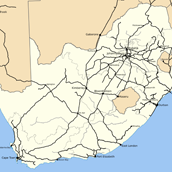
PRASA and Gibela unveil the finalised design of their new commuter train
25 Jul 2014
The project achieves its first milestone and now advances at full speed towards the manufacture of the vehicles.
The final design of the new X’Ttrapolis MEGA commuter train to be delivered by Gibela to PRASA was unveiled during Africa Rail, in the presence of the Minister of Transport, Ms Dipuo Peters and PRASA Group CEO, Mr Lucky Montana. Among the features of the train which were finalized were its interior and exterior outlines.
Since the contract for the supply of 600 trains came into force, PRASA and Gibela have finalized the so-called “Design Review” and it will now be possible to commence with the manufacturing phase.
“The project is running at full speed and we have successfully completed the first important milestone,” said PRASA Group CEO Mr Lucky Montana.
“The PRASA and Gibela project teams worked together with a very positive spirit of collaboration. Thanks to Alstom’s advanced technology the review was done quickly and efficiently,” explained Gibela CEO Marc Granger.
Alstom is equipped with a 3D “virtual reality” room which allows the showcasing and review of all the features and configurations of the train in real scale 3D imagery. Engineers can examine the train details or view specific parts in their actual size and can better judge how components will fit into the final product in the context of the design calculations.
Alstom Design & Styling Department worked in unison with PRASA’s designers to achieve the final look of the train. “In the case of PRASA, the design of the train is inspired by South Africa’s rapid advancement towards increased modernity and technological progress.” explained Alstom Design & Styling Director, Mr Xavier Allard.
Alongside this milestone, the first group of Gibela’s newly hired South African engineers is being trained, over an 18-month period, in train technology in various Alstom facilities in Europe. In Lapa, Brazil, preparatory work has begun in the Alstom plant where the first 20 trains will be manufactured and where the assembly of the first vehicle will start in the coming weeks.
Press Release of Alstom,
4 July 2014

JR unveils amazing luxury train that we’d like to live in like high-class hobos
25 Jul 2014
Last spring, Japan Railways, operator of Japan’s fabled bullet trains, unveiled its design for a new Shinkansen that will whisk travelers to northeastern Japan as they relax at the onboard foot baths. Then came the announcement of an overnight train servicing Kyoto, Osaka, and Hiroshima with amenities rivaling those of a fancy hotel.
Now, it’s east Japan’s turn, as JR East has released new images of its upcoming luxury sleeper train for the region, plus its passenger suites that look genuinely large enough to live in.
JR originally shared its plans for the train last year, when famed train and auto designer Kiyoyuki Okuyama, who also goes by the name Ken, came onboard the project. Okuyama, who also headed the design of the footbath-equipped Shinkansen mentioned above, has pegged the design theme as “a train where passengers can enjoy the flow of time and space.”
What this seems to translate to, in concrete terms, is carriages that make use of extremely large windows to provide occupants with the widest possible view of the outside landscape. At either end of the 10-car train is an observation area with sofas and natural light streaming in from all directions.
Of course, nothing ruins your tranquil contemplation of the beauty of nature like the sound of your stomach growling, so of course there’s a dining car.
There’s also a lounge, if you’re looking for something lighter than a full meal.
The remaining six cars are used for guest rooms. Five of these contain three suites each, all of which include private bathroom and shower, and look to be a far cry from a packed Tokyo commuter train in terms of comfort.
The jewel in this rail-riding crown, though, is the centra car which houses the deluxe suites.
This split-level room includes two beds, a living room seating area, and even a bathtub. Honestly, if this was an apartment in Tokyo, you’d have no problem at all finding someone willing to sign the lease. The lack of a fixed address would make receiving mail tricky, though.
This isn’t even all the sleeper has to offer, as the deluxe suite car will also contain a seperate, single-level guestroom, although no images of it have been released yet.
JR East’s new pride and joy is expected to go into service in spring of 2017, so plan your trips (or apartment hunting) accordingly.
Press Release of Japan Railways
5 June 2014

Five reasons why Canberra needs Light Rail
25 Jul 2014
Canberra is a city of big thinkers, entrepreneurs and planners.
We have the opportunity to dictate our future and turn it into something we want Canberra to be.
Canberra is growing as a city and as we enter our second century of existence our growth has accelerated.
Here are five reasons why light rail has a part to play in this acceleration.
Sustainability is crucial in Canberra’s growth
Canberra needs to keep growing as a smart and sustainable city. We are growing towards a population of 500,000 and that growth must be directed by a vision that includes high quality transport connections, more active lifestyles and a revitalised city centre. Light rail will play an important role in delivering this vision and it will help to reduce the congestion that costs Canberra more than $100 million every year.
We can’t keep building more roads for more cars
Canberra has the highest car dependency of any major Australian city and we travel further in our cars than residents in any other major city in Australia. As the city grows this car and road reliance will become unsustainable and the grandest road network plans will not allow us to keep growing sustainably and responsibly. One light rail vehicle will hold up to 300 people, equating to 300 cars off the road. This will improve traffic congestion and our environment.
Diversifying the economy and creating jobs
The Capital Metro project has a positive benefit cost ratio and it is forecast to support 3,500 jobs during construction. In a time when Canberra needs jobs, light rail will deliver. Light rail also has a track record of driving extra commercial activity along its route. Passenger exposure and the convenience of living and operating businesses near light rail stops, drives significant commercial opportunities.
Better health and environment
Light rail will support a big reduction in emissions and a much healthier lifestyle. Today in Canberra the vast majority of people sit in cars as part of our daily commute and many of these cars are carrying just one person. If the 200 or more people that light rail can carry left the car at home, walked to a light rail stop, enjoyed a quick and smooth trip and then walked to work their health and our precious local environment would benefit immensely.
Connecting Communities
The corridor between Gungahlin and the City is bursting with opportunities and they need to be connected. Decades of planning is contributing to a revitalised Northbourne Avenue, fast growing mixed use areas in Gungahlin and a major upgrade to Dickson’s commercial precinct. The certainty of light rail tracks in the ground and high frequency and high capacity services is the glue that connects the opportunities together.
Press Release of www.capitalmetro.act.gov.au,
3 July 2014

Los Angeles Metro awards $1.6bn contract for Metro Purple Line extension
25 Jul 2014
The Los Angeles County Metropolitan Transportation Authority (Metro) in the US has awarded a $1.6bn contract to a joint venture comprising Skanska, Traylor Bros and J F Shea for the construction of Metro Purple Line extension.
The contract covers the design and construction of a 3.9-mile long extension of the Metro Purple Line subway from Wilshire and Western to Wilshire and La Cienega, where new stations will be constructed.
The contract also includes the installation of train control and signals, communications, traction power supply and distribution, as well as new fare collection systems on the existing Metro Rail system.
Construction work will begin later this year and it is expected to be completed in October 2024.
Phase I of the project is being funded by federal grants and low-interest loans, funds from Measure R and the City of Los Angeles, as well as other existing local and federal funds.
Two other contracts will also be awarded to extend the Purple Line subway westward for approximately nine miles with a total of seven new stations.
“Construction work will begin later this year and it is expected to be completed in October 2024.”
Skanska is currently building the extension of the Expo light rail project from Culver City to Santa Monica, which is scheduled to open in early 2016, while Skanska and Traylor Bros are building a 1.9-mile underground light rail project in downtown Los Angeles that will connect the Metro Blue, Gold and Expo lines.
Shea is part of a joint venture building the Crenshaw/LAX Transit Project, which will connect the Metro Expo and Green light rail lines in the Crenshaw and Inglewood corridors.
Shea and Traylor have worked on the Los Angeles north-east interceptor sewer tunnel.
Source: www.railway-technology.com,
8 July 2014

Cuba completes Mariel port rail link
25 Jul 2014
CUBA completed construction of its first new railway for more than two decades on July 1 with the opening of the 65km link between Havana and the port of Mariel, which provides access to a new container terminal.
The line uses parts of an abandoned railway between Havana and Guanajay and a new alignment between Guanajay and Mariel. The railway is double-track throughout and includes a link from Guanajay to Artemisa, where it joins the Havana – Pinar de Rio main line.
At Havana the line joins the existing network at Almendares station. The new container terminal at Mariel will replace existing facilities in Havana, which will release land in the capital for redevelopment.
The port of Mariel has recently been developed in a joint venture with Odebrecht, Brazil, and in addition to the construction of new intermodal facilities this includes the establishment of a free trade zone.
The new line will be officially inaugurated on July 26, which is a national holiday in Cuba, although trains have already begun running. A passenger service operates over the line, primarily to carry dock workers from Havana to Mariel, although the new line will also help to improve passenger services in Artemisa province. It is expected that the new Russian DMUs currently being delivered to Cuba will be used for these services.
Cuban Railways hope to increase container movements by rail significantly as the port of Havana suffers from insufficient capacity at present and this situation should improve with the new terminal, which will have capacity to handle 1 million TEUs per year, compared with just 350,000 TEUs at Havana.
Source: www.railjournal.com,
03 July 2014
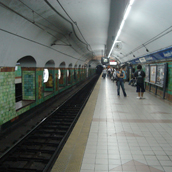
New Buenos Aires suburban trains on test
25 Jul 2014
ARGENTINA’s minister of the interior and transport Mr Floriencio Randazzo inspected one of the first new suburban EMUs for Buenos Aires’ Sarmiento Line during nocturnal testing on June 6.
CSR Qingdao Sifang, China, is supplying 25 nine-car trains for the Sarmiento Line and 30 six-car trains for the Mitre Line under a contract awarded by the Argentine government in January 2013.
So far nine of the 100km/h trains have been delivered to the Argentine capital for testing and a further 14 sets are due to be delivered over the next four weeks. Deliveries are expected to continue until November 2015.
Randazzo said tests have been highly satisfactory and he expects the first trains to enter passenger service on the Sarmiento line within the next two months.
The new fleet will replace all existing trains on the Mitre and Sarmiento lines, which are more than 50 years old.
Source: www.railjournal.com,
12 June 2014
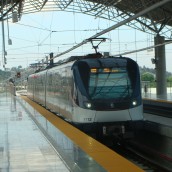
Panama Metro Line 1 opens
29 May 2014
The Republic of Panama President Ricardo Martinelli has inaugurated the new 15.9km-long Panama Metro Line 1 that connect Albrook national bus station in the north to San Isidro station in the south.
Delivered by French transport group Alstom, the Panama Metro forms a part of the Alstom Metropolis range and is the first metro system with 14 stations in Central America.
The line will run from the Grand National Transport Terminal in Albrook to the Los Andes shopping centre, in the town of San Miguelito, and is expected to directly benefit nearly one million people.
Construction of the $1.8bn Panama Metro began in November 2010.
The new metro will help reduce the increasing traffic congestion in the city, with an estimated capacity to carry 15,000 people an hour in 2014, which will rise to 40,000 people an hour by 2035.
Alstom supplied a fleet of 57 metro cars and the communication-based train control (CBTC) system for the project, as well as engineering, installation and integration services.
It offers two CBTC system solutions including Urbalis 400 and Urbalis Fluence.
The Urbalis 400 provides high transport capacity and high availability for interlocking systems, while Urbalis Fluence offers optimum train-centric architecture and higher operational availability with extreme flexibility of train movements.
Manufactured on Santa Perpetua site, near Barcelona in Spain, 19 trainsets were shipped across the Mediterranean, the Straits of Gibraltar, the Atlantic Ocean and the Caribbean Sea, before arriving in Panama Canal.
Alstom has also completed testing on the metro that commenced in October 2013.
Besides Alstom, the consortium includes FCC and Brazilian company Norberto Odebrecht.
In addition, the city of Panama has announced plans to launch a tender for the construction of a second metro line.
FCC consortium is expected to be responsible for the development of the proposed metro line extension.
Source: www.railway-technology.com , 9 April 2014
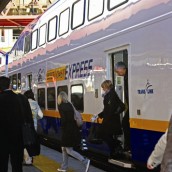
Bombardier Launches Crewing Services for West Coast Express
29 May 2014
Rail technology leader Bombardier Transportation today launched its crewing services for TransLink’s highly successful West Coast Express commuter rail system in the Lower Mainland region of British Columbia.
Bombardier will provide crews for the West Coast ExpressBOMBARDIER BiLevel commuter rail fleet of 44 vehicles. Nearly 1,200 BiLevel cars are already in operation across the United States and Canada.
Over the last 20 years, Bombardier has grown to become the North American leader in operations and maintenance services for public transit authorities. Every day, Bombardier Transportation employees across the world launch more than 60 fleets of transit vehicles into safe, reliable and efficient service, providing passengers with an exceptional transportation experience.
“Safe, reliable and courteous service is what our West Coast Express customers have come to expect,” said Fred Cummings, President and General Manager of British Columbia Rapid Transit Co. Ltd (BCRTC). BCRTC is an operating subsidiary of TransLink, the regional transportation funding and planning authority, and is responsible for West Coast Express.
“West Coast Express routinely boasts the highest customer service ratings in our regional transportation network, and we look forward to continuing that trend with Bombardier providing crewing services,” said Cummings.
“Bombardier is proud to support and partner with West Coast Express in its efforts to further enhance its reputation for reliability and outstanding customer service,” said Raymond Bachant, President, Bombardier Transportation Americas. “All our employees are committed to offering safe, high-quality, on-time train performance to the passengers of West Coast Express,” he added.
Bombardier has a long-standing track record of providing operations and maintenance services to transit systems across North America including Agence Métropolitaine de Transport in Montréal, GO Transit in Toronto, the Maryland Area Regional Commuter (MARC) Train Service, New Jersey Transit, North County Transit District in California, OC Transpo in Ottawa, the South Florida Regional Transportation Authority, the Southern California Regional Rail Authority and, since May 1, 2014, the Central Florida Commuter Rail Transit project (SunRail) Train Service. Bombardier also supports transit systems with overhaul and refurbishment programs and material and technology solutions.
Source: www.bombardier.com , 5 May 2014
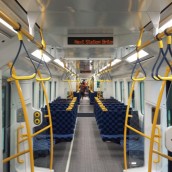
Electric Trains start running in Auckland
29 May 2014
Until 27 April, all rail commuter services in New Zealand’s Auckland were provided using diesel multiple-unit sets previously run in Western Australia. Both Perth and Auckland rail networks are on 1,067mm gauge – the same as South Africa. On 28 April, eight new three-car electric sets took over from the diesels on two lines in Auckland. Electric services on other lines will follow as the rest of the 57-coach order becomes available during 2014 and 2015. The replacement rolling stock is being supplied by Construcciones y Auxiliar de Ferrocarriles SA (CAF) in Spain.
The $US429.3 million Auckland 25kV AC electrification project involved the erection of some 3,500 traction wire supporting masts. Siemens supplied a new train control system featuring bi-directional signaling and updated centralized control. The 72-metre coaches, with 40% more passenger capacity than the diesels, are based on the design used for London’s Heathrow Express. Maximum speed is 110km/h. CAF New Zealand is to maintain the trains at a new facility in Wiri, South Auckland, until 2026.
Source: www.railwaysafrica.com , 6 May 2014
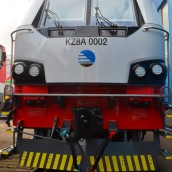
Alstom to supply 50 KZ8A freight locomotives to Azerbaijan
29 May 2014
Alstom has been awarded a contract to supply 50 KZ8A freight locomotives to Azerbaijan Railways (ADDY) which will be assembled in Alstom’s JV EKZ between 2016 and 2018. The total amount of the contract is €300 million. Alstom’s share amounts to around €150 million. The contract was signed in the Azerbaijani capital of Baku in the presence of the French President Francois Hollande and the President of Azerbaijan, Ilham Aliyev. The contract may also include the construction of a depot, technical assistance and maintenance, as well as training for ADDY staff. These are subject to negotiation within the next six months.
KZ8A locomotives rank among the most powerful locomotives in the world (8,800 kW) with asynchronous traction, able to run at 120 km/h and to haul up to 9,000 tons. The KZ8A electric locomotives for this contract will be assembled in Alstom’s JV manufacturing site in Astana, Kazakhstan.
“Azerbaijan is a strategic transit point between Europe and Central Asia. The modern KZ8A freight locomotives will help increasing its carrying capacity in transportation of raw materials and goods,” saidThibault Desteract, SVP Alstom Transport Russia and CIS.
The total length of Azerbaijan’s rail network is 2,932 km, of which 1,278 km is electrified (3 kV). In 2006 Azerbaijan railways launched a long-term program for the renovation and modernization of its railways, including its traction fleet, reconstruction of infrastructure, and a gradual switch from DC to AC. According to the latest forecasts, the volume of the railway traffic in the country should almost double by 2017 from current figures.
Alstom also signed on 12 May a Memorandum of Mutual Cooperation with Baku Metropoliten with a view to develop modern metro cars for both the new lines and the gradual replacement of the existing fleet of Baku metro. Both parties have agreed to sign a final agreement in the coming two months.
Press Release of Alstom, 13 May 2014
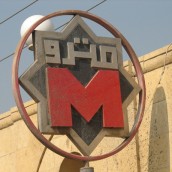
Cairo opens Metro Line 3 Phase 2
29 May 2014
Cairo’s Line 3 is the first in the city’s metro to have automatic train operation. The initial 4.3km, five-station section to Abbasiya from Attaba (the interchange with Line 2) has been operating since February 2012. On 7 May 2014, the $US1.7 billion, five-station, 7.2km eastern section extension to Line 3 was officially opened. It runs from Abbasiya to Haroun El Rachid in the Heliopolis district. Daily passengers on this line are now expected to total some 600,000. The proceeds of a loan agreement signed by the government with the French Development Agency and the European Investment Bank will provide some of the funding required for the third phase, which is to be 18km in length with 15 stations. Line 3 will eventually extend 34km in total, from the Giza district in the west of the city to the international airport in the east.
Source: www.railwaysafrica.com , 13 May 2014
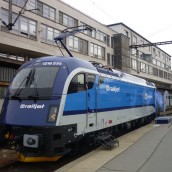
Česke drahy railjet launches test operations with passengers
29 May 2014
The first ČD railjet unit officially launched test operations with passengers on 6 May. The ČD railjet train commenced its maiden voyage on regular connection IC 571 Zdeněk Fibich from Prague Main Station (Praha hl.n.) to Břeclav. In the coming days, passengers will encounter a ČD railjet unit on IC 572 / 573 Brněnský drak Brno hl.n. (dep. 6:39) – Praha hl.n. (arr. 9:21 / dep. 16:39) – Brno hl.n. (arr. 19:19). From mid-June, ČD is planning international test operations of a ČD railjet unit on EC 72 / 73 Smetana and EC 74 / 75 Franz Schubert, and from December ČD railjet units and ÖBB railjet units will connect Prague, Brno, Vienna and Graz at regular two-hour intervals.
By introducing railjets, ČD is strengthening its position in the area of international long-distance transport, and the Czech national carrier thus becomes part of an international network of fast and comfortable trains to which it will connect directly at the newly constructed Vienna Main Station transfer hub. This cooperation will benefit mainly passengers, who can also use the most modern type of train in inland transport between Prague, Pardubice, Brno and Břeclav.
“Today, we have enabled our passengers to use the first completely new train for long-distance transport, which represents – in addition to many technical innovations – a new level of quality in travel. Air-conditioning, an information system, restaurant, accessibility modifications for passengers using wheelchairs – these are already automatic components of many of our trains, but here we are offering our passengers additional new services and improvements as well,” says ČD’s Chairman and CEO, Daniel Kurucz, adding specific examples: “Business travellers can take advantage of the serenity of the new business class section with comfortable adjustable armchairs, while families with children will appreciate reserved seating near the children’s cinema. Nearby, there is also space for stowing prams and strollers. We’re also thinking about cyclists, which is not usual for similar fast trains. For these reasons, railjet between Prague and Brno is a good alternative not only to the bus but also to the personal automobile. The quality and speed of trains on this line is now at the European level, and railjet trains only confirm this fact.”
“Today’s launch of test operations of the railjet fast train moves the realisation of the contract between ČD and Siemens into the next phase. Railjets will bring to Czech customers modern railway travel at the European standard to which passengers in Western Europe are accustomed. The remaining six railjet units should appear gradually on the Czech railway network by the end of this year. A Czech team from the Siemens development centres in Prague and Ostrava participated in the structural design of the high-speed railjet trains,” says Roman Kokšal, director of the transport division at Siemens.
Modern ČD railjet units offer their passengers a high level of comfort as well as faster travel. Travel time between Prague and Vienna will be reduced from the current 4 hours 45 minutes to approximately 4 hours 10 minutes. After modernisations are completed on several line segments in the Czech Republic, ČD plans to reduce travel time between Prague and Brno as well. It will then be possible to travel from Prague to Vienna in less than 4 hours.
ČD railjet units offer their passengers the following services and benefits:
- a comfortable business section with adjustable armchairs;
- a 1st class section with leather adjustable seats and folding or retractable table trays;
- 2nd class seats arranged behind one another or opposite one another with folding or retractable table trays;
- 230 V electrical outlets in all carriages for charging passengers’ small electronic devices, e.g. laptops, mobile telephones, tablets and other devices;
- an on-board restaurant with a rich offering of foods and beverages;
- in 1st class and business class, in-seat food and beverage service from the restaurant carriage; in 2nd class, an offering of refreshments from the minibar;
- spaces for passengers using wheelchairs, including modified accessible WCs;
- a children’s cinema with reserved seating for passengers travelling with children, including space for stowing prams and strollers;
- space for transporting 6 bicycles;
- generously dimensioned storage spaces for luggage;
- a modern audio-visual information system with LCD displays and an electronic reservation system;
- air-conditioning;
- a pressure-tight carriage body which reduces unpleasant sudden charges of pressure when entering tunnels or when two trains pass each other;
- wide, accessible passages between carriages without doors.
ČD’s 7-carriage railjet has a total of 442 seats, of which 6 are in business class and 42 are in 1st class. The train can travel at up to 230 km/h, is 185 m long without the locomotive and weighs 350 tonnes. Today, railjet trains are deployed on international connections between Hungary, Austria, Switzerland and Germany. And from December 2014 the Czech Republic will be added to this list as well.
This year, ČD is celebrating 175 years of railway transport. The first line on Czech territory, running from Vienna to Břeclav, was opened on 6 June 1839, and train operations from Vienna all the way to Brno were christened on 7 July 1839. ČD’s completely new railjet units are heading for this country’s oldest line in the jubilee year 2014. České dráhy, a.s., (ČD) is the continuator and direct successor of the former railway companies.
Press Release of Ceske drahy, 5 May 2014
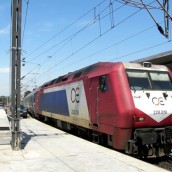
Greece restores international passenger services
29 May 2014
More than three years after Greece was severed from the European passenger rail network, Greek national train operator Trainose restored international services from Thessaloniki to Bulgaria, Macedonia, and Serbia on May 10.
One daytime train per day now links Thessaloniki with Sofia with a journey time of 6h 50min for the northbound trip. The Hellas Express service from Thessaloniki to Skopje and Belgrade runs overnight with couchette and sleeping accommodation, completing the 730km trip in 12h 41min.
Trainose suspended all cross-border services on February 11 2011 during Greece’s crippling economic crisis.
Source: http://www.railjournal.com/ , 12 May 2014
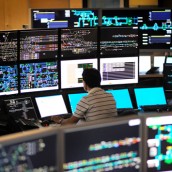
IT INNOVATION: RFI (Rete Ferroviaria Italiana) 2013 SAP QUALITY AWARD SILVER MEDALIST
29 May 2014
An award for Rete Ferroviaria Italiana at the 2013 Sap Quality Awards.
The “Voci di Tariffa” (Tariff Items) software developed by the company’s ICT department to support the management process for railway infrastructure works, came second in the Medium Implementation category.
The award was presented to RFI (Gruppo FS Italiane) by SAP AG, world leader in IT solutions for business within the scope of the Quality Award competition which recognizes the best software at an international level based on strict quality criteria.
An award which confirms the supremacy of Rete Ferroviaria Italiana in the field of technological innovation: it had already taken gold and silver awards in the 2011 SAP Quality Awards for the “Pianificazione strategica” (Strategic Planning) and “Vendor Rating Materiali” (Materials Vendor Rating) projects.
Press Release of FS Italiane, 13 May 2014
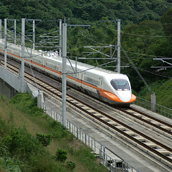
Toshiba Receives Order from Taiwan High Speed Rail Corporation for E&M Systems for New Stations
31 Mar 2014
Toshiba Corporation today announced that it has received a turnkey order for electrical and mechanical systems (E&M) for three new stations from Taiwan High Speed Rail Corporation (THSRC). The stations will be constructed at Miaoli, Changhua and Yunlin on the Taiwan High Speed Rail line (THSR) and open by the end of 2015. The E&M systems cover passenger announcement systems, passenger information systems, signaling systems, electrification and power systems, and the maintenance management information system. Total order has a value of approximately 2.8 billion yen.
THSRC placed the original order for the THSR project in 2000 with a consortium of seven Japanese companies, including Mitsubishi Heavy Industries, Ltd. (MHI), Toshiba and Mitsui & Co., Ltd. At that time, Toshiba received orders for train electrical equipment, the electrification and power supply system, train traffic control system, communications system and maintenance management information system. In May 2012, Toshiba and Kawasaki Heavy Industries, Ltd. together received a further order for four 12-car train sets, and in July 2013, Toshiba and MHI received an order for E&M systems, including the railway power supply system, for the Nangang extension project that will take the high speed line from Taipei to Nangang.
Commenting on the award of the contract, Mr. Toshio Masaki, President and CEO of Toshiba’s Social Infrastructure Systems Company, said: “We believe the company’s record in the THSR system contributed to the award of the contract for the new stations. Toshiba is committed to fully supporting the project and bringing it in on schedule. We strongly hope that THSRC will continue to advance its system, and that we can introduce THSR as a successful example of the Shinkansen system to other countries planning to build high speed rail lines.”
THSR services started in January 2007. Regularly scheduled trains currently travel the 345km between Taiwan’s two major cities, Taipei and Kaohsiung, with a travel time of approximately 90 minutes. By 2016, construction of the three new stations and the Nangang extension project will be completed. With these new stations, the THSR is expected to play an even more central role in vitalizing Taiwan’s economy.
Going forward, Toshiba will bring its cumulative advanced technologies, know-how, sophisticated system integration capabilities, and proactive marketing activities that demonstrate how Toshiba can contribute to high-speed rail projects, especially in developing economies.
Press Release of Toshiba, 21 February 2014
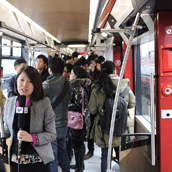
First prototype of the tram ForCity is now in operation in China
31 Mar 2014
Škoda Transportation signed a contract with the Chinese company CSR Sifang Quingdao Co.Ltd. about licence for technologies for production of low-floor trams of the type ForCity (15T) in June last year. First prototype was manufactured in China recently and the company CSR Sifang Quingdao begins to offer this modern vehicle on the local market.
“The prototype of the tram ForCity in China was successfully activated and tested in the middle of January and trial runs were made in the production plant with the participance of our technicians. We can now announce that the tram manufactured in China is prepared for presentation to potential clients. It is a proof that the cooperation between our two companies has been a success,” says Tomáš Krsek, chairman of the Board of Directors of the company Škoda Transportation.
There are more than 160 cities in China with more than one million of inhabitants. These cities plan great investments into the development of their infrastructure and rail vehicles are to form the backbone system of public transport. ”I must emphasise that the Chinese market starts to be very demanding with regard to requirements, which concern technological level of products – they require only the world top products. That is why we are very proud in our company that we were able to sell them the licence for production of trams ForCity last year. Besides Prague, this tram is also used in the Latvian city of Riga,” adds Petr Vízdal, director of business development of the company Škoda Transportation.
More than 150 Chinese professionals from the ranks of technical management were trained in the production plants of Škoda Transportation during last year and these trainings will continue even this year. Each of the phases of these trainings were focused on some of the crucial areas of a production of a tram, so today the Chinese are prepared to offer the tram ForCity in tenders issued by Chinese towns. “ForCity is in the portfolio of trams, which we offer to our clients, it is absolutely a top product. It is a fully low-floor tram with individual drive for all wheels and unique rotating chassis. This means that it can manage the most difficult tracks in the city,“ said Josef Bernard, general manager of Škoda Transportation.
In the middle of the previous year, Škoda Transportation concluded the contract with the Chinese company CSR Sifang Quingdao for 10 year licence for production of ForCity trams. The sale of the licence confirms the uniqueness and high technical level of the tram 15T.
Press Release of Škoda Transportation, 6 March 2014
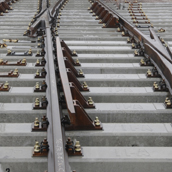
WEGH Group doubles its contribution to the construction of Nacala Corridor, in Mozambique: awarded the contract for turnout bearers
31 Mar 2014
After the important results achieved in Mozambique with the supply of 1.200.000 concrete sleepers for the Nacala railway Corridor, WEGH Group signs a contract for the supply of all the turnout bearers needed for the completion and renewal of the line.
It is a railway line of 912km , that will link the coalfield of Moatize to the Nacala Port, on the North of Mozambique. The line is estimated to be operative within the end of 2014, in order to transport, in 2015, over 11 million tons of coal/year, a volume that will gradually increase to 18 million tons/year on 2017.
The existing Namialo factory, in charge for sleeper’s production, will accommodate the new dedicated production unit, with a modern Long-Line plant.
Press Release of WEGH Group, 27 January 2014

Siemens wins an additional locomotive contract in the USA
31 Mar 2014
The Departments of Transportation for the U.S. states of Illinois, California, Michigan, Missouri and Washington have awarded Siemens a contract for the delivery of 32 diesel-electric passenger locomotives. The contract is valued at approximately €165 million ($225 million). It includes a purchase option for another 225 locomotives which will be used for regional and mainline trains traveling at speeds of up to 200 km/h (125 mph). The 32 locomotives ordered are scheduled to be delivered between fall of 2016 and mid-2017. “For Siemens this order marks our entry into the U.S. diesel-electric locomotive market and strongly underscores our long-term vision for the U.S. passenger rail market”, Jochen Eickholt, CEO of the Siemens Rail Systems Division, emphasized. The diesel-electric locomotives will be manufactured at the Siemens plant in Sacramento, California.
On December, 2013, the Illinois Department of Transportation, which is coordinating the order on behalf of California, Michigan, Missouri and Washington, announced its intention to move forward on the order with Siemens. The official Notice to Proceed has now been formally granted.
The Charger locomotives will be used exclusively in passenger service. The primary traction drive, a 4,400 hp-rated diesel engine with 16 cylinders and a cubic capacity of 95 liters, will be manufactured in the U.S. by Cummins Inc., headquartered in Columbus, Indiana. These modern locomotives are powerful and efficient and will deliver a cleaner ride, with better air quality and reduced emission rates ensuring compliance with the Federal Railroad’s EPA Tier IV regulation required to be in place in 2015.
As one of the fastest, most efficient and safest modes of transportation, passenger rail is a key priority for U.S. infrastructure development. After all, Siemens wants to play a major role in this lucrative market and can already look back on first successes, for example the recent fanfare surrounding the new, advanced technology electric locomotives built in Sacramento for America’s premier passenger rail operator, Amtrak. Just a few weeks ago U.S. Vice President Joe Biden and U.S. Secretary of Transportation Anthony Foxx welcomed the first of 70 Amtrak Cities Sprinter (ACS-64) electric locomotives into passenger revenue service.
The Siemens diesel-electric passenger rail locomotives ordered will greatly help improve transportation on non-electrified railroads throughout the Midwest and the west coast. The contract includes 32 vehicles plus spare parts supply. In addition, there are options for an additional 75 locomotives for use in regional transportation and another 150 locomotives for mainline transportation.
The Charger locomotive reaches a tractive effort on starting of 290 kN with a weight of around 120 tons. The Cummins QSK95 diesel engine is 4,400 hp-rated. These U.S. locomotives are based technically on the Siemens Eurosprinter, Eurorunner and Vectron locomotive platforms which have been proven through several billion kilometers in both freight and passenger service. The components are procured and manufactured exclusively in the United States.
Press Release of Siemens, 18 March 2014
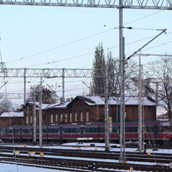
Thales stays on track in Poland by implementing ETCS on Warszawa–Łódź Line
31 Mar 2014
For an amount of roughly €100 million, a Thales-led consortium has been awarded a contract by Poland’s Rail Operator, PKP Polish Lines S.A. (PKP PLK), for the implementation of an ERTMS solution, including an ETCS Level 2 signalling system and a GSM-R communications system, on two sections of the Warszawa–Łódź Line. The two stretches, Warszawa Zachodnia-Koluszki and Koluszki- Łódź Widzew, have a combined length of roughly 125km. The contract also involves the design and operation of a local control centre, in Skierniewice.
This is the fourth contract that sees Thales implement its ETCS system in Poland. In total, Thales has respectively deployed its ETCS and its GSM-R solutions on over 700 kilometres and 500 kilometres of the Polish railway network.
The overarching purpose of this project is to assist the modernisation of the Polish railway network. The implementation of Thales’s solutions will improve safety whilst also increasing the maximum speed to 160km/h for passenger trains and 120km/h for freight trains. The line’s capacity will therefore increase and journey times will be reduced, thus making rail transport more effective; a considerable benefit for the line’s passengers, most of whom are daily commuters.
Press Release of Thales, 12 March 2014
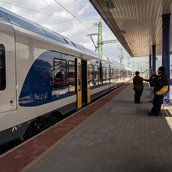
The first two new FLIRT multiple units have arrived
31 Mar 2014
Today, Ministry of National Development, MÁV-START and Stadler have presented to the public one of the two new FLIRTs at the Kápolnásnyék railway station that have arrived to Hungary recently. The first multiple unit will operate expectedly in autumn this year, following the strict technical and authority testing and licensing period. The 42 new FLIRTs that are due to arrive until autumn 2015 are going to operate on the suburban railways of Budapest. The new trains offer state-of-the-art travelling conditions, while their operation saves billions of HUF energy to the railway company on a yearly basis.
The first two vehicles of the 42 FLIRT units have arrived from Switzerland to Hungary so the domestic static and dynamic tests could start under the supervision of the National Transport Authority. MÁV-START can launch the commercial operation of the 61st and the 62nd FLIRTs after obtaining the operational permit. The blue-white-yellow-grey colored trains can firstly be used by passengers travelling on the Székesfehérvár line. The first vehicle was introduced to the public and the representatives of media on 19 March 2014 at Kápolnásnyék, exactly one year after signing the delivery contract.
Lászlóné Németh, Minister of National Development said: ’The Orbán-government made it clear in 2010 that it is committed to public transport and railway developments in accordance with the policy in the European Union and worldwide. In the last three years the developments covered 460 km lines on MÁV Zrt.’s railway system and there are expansions and developments on further 500 km currently. With the operation of the convenient multiple units, every requirement is given that more and more people choose the services of railways, in addition a well-functioning and competitive railway can be created in Hungary.’
Ilona Dávid, Chairperson and CEO of MÁV Zrt. added: ’The renovated Kápolnásnyék station and the new multiple units are excellent examples of that responsible, forward-looking way of thinking that has described the attitude towards railway in Hungary in the recent years. The supportive transport policy of the recent period has established the development of railway transport as well as the predictable and stable operation and the continual improving of standards and quality. Renewing railway system, modern ticket-sales, good parking facilities, clock-face scheduling, trains of high standard, quality service. These are what we are aiming at MÁV through the country and now we are able to provide such service on even more and more lines.’
Csaba Ungvári, CEO of MÁV-START highlighted: ’The new vehicles are going to operate on the Budapest-Székesfehérvár, Budapest-Pusztaszabolcs, Budapest-Szob, Budapest-Veresegyház- Vác, Budapest-Cegléd-Szolnok and after the finishing of electrification on the Budapest-Esztergom lines. Almost the two-third of the trains will be covered by FLIRTs in the suburbs of Budapest. This way, we can serve the quarter of the journeys which mean 34 millions of travelings by modern multiple units. The already operating FLIRTs are very popular among passengers: where these vehicles operate the number of passengers has risen by 6-12%.’
Zoltán Dunai, Country Manager of Stadler Hungary Ltd. stated: ’With the contract signed last year 112 FLIRTs are going to operate from the autumn of 2015 on the lines of Hungary. The procurement is a significant milestone not for MÁV and GYSEV but also for Stadler, because this is going to be the largest homogenous FLIRT fleet in the world. We are proud that we carry on playing an important role in the development of Hungarian railway. FLIRT multiple unit is the bestselling product of Stadler, there have been orders for producing almost 950 multiple units from 15 countries.’
Press Release of MÁV-START Zrt., 19 March 2014
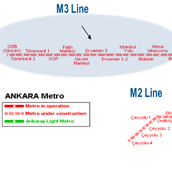
Ansaldo STS, leader of the consortium, opens line M3 of the CBTC Ankara Metro
31 Mar 2014
The opening ceremony of Ankara Metro’s M3 Line was held on 12 February 2014 in the presence of the Turkish Prime Minister (Recep Tayyip Erdogan), the Turkish President (Abdullah Gül) and the Prime Minister of Spain (Mariano Rajoy).
The 15.5 Km long line has 11 stations and is part of the first of three sets (4 lines) of the Ankara Metro CBTC project. The project also includes the renovation of the existing M1 line and of the currently operating deposit, as well as the construction of lines M2 and M4, for a total length of 55 Km and 44 stations, with 144 trains to be equipped with the CBTC system.
Line M3 is now operational in DTP mode. The completion of all CBTC features is expected by the end of 2014.
The Contract was awarded to the consortium Ansaldo STS – Alsim Alarko Sanayi Tesisleri Ve Ticaret A.S (whose Leader is Ansaldo STS), by EGO Municipality of ANKARA. It was then transferred in 2011 from EGO to AYGM (Altyapi Yatirimlari Genel Mudurlugu), a company held by the Turkish Ministry of Transportation.
During the ceremony, the Turkish Prime Minister announced that he was satisfied with the achievement of this challenging objective for the city of Ankara, thanking all the companies who took part in the construction process, including the consortium led by Ansaldo STS.
This first milestone was achieved thanks to the commitment, determination and professionalism of all those involved in the construction process and to the efficient integration of an International team. This step is of fundamental importance for Ansaldo STS, as it strengthens its competitiveness and strategic positioning on the Turkish market, because the AYGM is in charge of promoting major future mass transit tenders in Turkey.
This work shall continue as there are additional activation phases, which include the DTP opening of M2 line expected at the beginning of March 2014, the progressive CBTC updating of Lines M1, M3, M2 from the end of 2014 and the opening of the fourth CBTC M4 line in 2015.
Press Release of Ansaldo STS, 17 February 2014
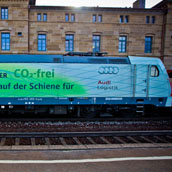
Eco Plus: DB Schenker Rail expands CO2-free products
31 Mar 2014
Since March, DB Schenker Rail has been providing CO2-free transportation of automotive components from Wuppertal to Regensburg and Landshut on behalf of the BMW Group. The automaker has now added a further route to its Eco Plus transportation services, in which the required traction current is obtained from renewable energy sources. The BMW Group already switched over its transportation services between Frankfurt and Bavaria to the eco-friendly transport system back in August 2013.
Pioneering product
Axel Marschall, the Member of the DB Schenker Rail Management Board for Sales, said, “On introducing Eco Plus, DB Schenker Rail successfully launched a pioneering product onto the market. We believe it is important to make an active contribution to environmental protection, and this innovative product does so without the need for projects to offset CO2 quantities that have already been emitted.”
Five times a week, a 500-meter long freight train carrying finished parts travels the 650 kilometers from Wuppertal to the BMW plants in Regensburg and Landshut without emitting any CO2. By changing over its services to Eco Plus instead of standard rail freight transportation, the automotive group can reduce its annual CO2 emissions by almost 2,000 metric tons.
Audited and certified
Eco Plus has been available from DB Schenker Rail on payment of a surcharge on all routes in Germany since 2010. The carbon-free transportation and procurement of energy from renewable sources in Germany have been audited and certified by the independent inspection organization TÜV SÜD. Customers such as Audi, Mondelēz International, Lanxess and Vinnolit also use this CO2-free option from DB Schenker Rail and receive an annual certificate confirming the CO2 emission savings. The first certificate for the BMW automobile group was issued on
February 13 for its Eco Plus transport services from Frankfurt to Regensburg and Landshut. More than 2,000 metric tons of CO2 are now avoided on this route each year. By adding the new route from North Rhine-Westphalia to Bavaria, the automaker can now reduce its CO2 emissions by as much as 4,000 metric tons annually.
There are plans to expand Eco Plus to cover international routes in the future. Customers can currently choose “Eco Neutral” transportation to offset CO2 emissions caused on route sections outside Germany.
Press Release of DB Schenker Rail, 3 March 2014

East Japan Railway selects Thales as provisional manufacturer for the first ever CBTC project in Japan
4 Feb 2014
Thales has been selected by the East Japan Railway Company, known as JR East, to design a CBTC system for the Joban line, in the Tokyo Metropolitan Area. JR East’s objective is to replace its current conventional automatic train control system and acquire a state-of-the- art system with an optimised life cycle cost, in order to improve transportation systems in the Tokyo Metropolitan Area. This 30 km long line runs from Ayase to Toride with 14 stations and 70 trains.
For JR East “developing railway systems free of track circuits, offering cost advantages with high reliability” is a principal aim. Since the 1980s, Thales has been a pioneer in CBTC technology, which was originally developed without the need for track circuits or secondary detection. One of the key benefits of this technology is therefore that it requires less equipment and optimises the line’s maintenance accordingly, which will meet JR East’s goal.
Thales’s CBTC system has been proven worldwide on over 55 projects to date and operates on more than 1,300 km of track in major urban centers around the world, carrying an estimated 3 billion passengers annually.
Press Release of Thales, 8 January 2014
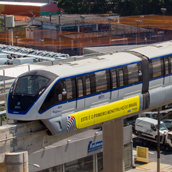
São Paulo monorail takes test run
4 Feb 2014
Testing has begun on the first of São Paulo’s new monorail vehicles. M01 made the way from its depot to Oratory station on Friday 10 on the first of a series of test runs to trial the first phase of the planned 27-kilometre automated monorail system.
Line 15 (Silver) will boast the world’s largest and highest capacity monorail in the world, moving 48,000 passengers an hour in each direction, according to the city’s municipal government. Four bi-directional trains will operate on the first 2.9-kilometre section of the line between Vila Prudente and Oratorio, which is scheduled to open in March 2014. The first two vehicles have now been delivered and are undergoing testing.
In total, 54 trains will operate on the Silver Line once the entire $6.4 billion system, spanning 18 stations across the city, opens in 2015.
Source: www.globalrailnews.com, 13 January 2014
Photo: Diogo Moreira/ Governo do Estado de São Paulo

Bombardier Wins Additional Order from San Francisco BART
4 Feb 2014
Rail technology leader Bombardier Transportation announced today that the San Francisco Bay Area Rapid Transit District (BART) confirmed an order for 365 additional rail cars for its “Fleet of the Future”. The order, valued at approximately $639 million US ($681 million CDN, 470 million euro), is part of a contract signed in June, 2012. Bombardier now has firm orders for 775 cars with a total value of approximately $1.5 billion US ($1.6 billion CDN, 1.1 billion euro).
“BART is very pleased to be partnered with Bombardier for this important project to bring a new and improved fleet to the Bay Area,” said BART General Manager Grace Crunican. “We look forward to the successful delivery of 775 innovative, reliable, safe and comfortable rail cars.”
Raymond Bachant, President, Region Americas, Bombardier Transportation, added: “This new order is indicative of BART’s satisfaction with our partnership and progress in the design of this new generation of metro cars. The cars will incorporate state-of-the-art, environmentally-friendly technologies and include input from Bay Area citizens who had the opportunity this summer to tour a mock-up of the car and learn about proposed improvements to the interior.” These improvements include a reconfigured interior layout designed to maximize seating, openness, and comfort; more priority seating for seniors and people with disabilities; wheelchair areas at the end of each car; and bicycle racks in every car. Other new features include more comfortable seats; interior and exterior digital displays showing passenger information; a better quality public address system, including automated announcements; more doors to make boarding faster and easier; energy saving lighting; and energy-efficient propulsion and regenerative braking.
Bombardier will assemble the cars at its manufacturing plant in Plattsburgh, New York. The Plattsburgh facility is Bombardier’s center for rolling stock production in the United States. In operation since 1995, it has produced more than 3,300 passenger rail cars and locomotives now in service across the United States. Ten pilot cars are scheduled to be delivered in the spring of 2015, followed by comprehensive testing of the pilot cars on the BART system. The delivery of the 765 remaining production series cars is expected to follow between early 2017 and 2021.
Bombardier is transforming how people get around every day. Worldwide, more than seven billion trips are taken on Bombardier metro cars every year in cities including Boston, New York, Montreal, Toronto and Mexico City as well as London, Paris, Berlin, Delhi and Shanghai. Bombardier’s current metro car orders in North America include 714 new cars for Chicago, 468 cars for Montreal, 420 cars for Toronto and 300 cars for New York.
Press Release of Bombardier, 7 January 2014
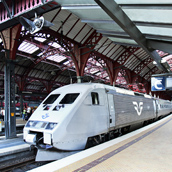
ABB wins $200 million order to equip Sweden’s next generation high-speed trains
4 Feb 2014
ABB, the leading power and automation technology group, has won an order of $200 million to supply the electrical systems for all 36 ‘SJ 2000’ next generation high- speed trains for SJ, Sweden’s state-owned rail operator.
SJ will invest a total of around $510 million in a comprehensive program for the SJ 2000 trains, for which ABB will supply and install energy efficient technology. ABB will book its order in the first quarter of 2014 in the Discrete Automation and Motion divsion. ABB will supply the entire power conversion and control systems on the SJ 2000 trains, delivering modern technology for the coming decade. The trains, which were launched in the late 1980s, will also be newly equipped with a fresh-looking interior design.
The first retrofitted train will be delivered in 2015. After successful testing and evaluation, the remainder of the trains will be built incrementally through 2019. Disassembly and assembly will be done in Sweden together with a local partner. “The equipment of high-speed trains is a growing market for ABB’s rail business for which we are very well positioned, building on our company’s combined power and automation solutions,” said Ulrich Spiesshofer, CEO of ABB. “With a comprehensive portfolio of traction solutions, power electronic packages and project management expertise globally and in Sweden, we are a reliable partner for world-class train operators including SJ here in Sweden.”
The SJ 2000′s upgraded electrical systems will ensure more reliable power supply while reducing energy consumption in a significant way. Punctuality, reliability and higher comfort are key factors to further improve customer satisfaction. ”The need and demand for environmentally friendly and comfortable travel will keep increasing. Passenger train journeys went up by 59 percent from 1997 to 2010. All signs point to a further strong increase, not least in terms of business travel as companies live up to their sustainability commitments”, said Crister Fritzson, CEO of SJ. “This initiative will enable SJ to offer the most comfortable train journeys on the main inter-city lines in Sweden for a long time ahead.”
ABB’s scope of supply includes traction converters, traction transformers, battery chargers, train control systems and infotainment equipment. This project follows ABB’s successful refurbishment of high-speed InterCityExpress (ICE 1) trains operated by Deutsche Bahn, Germany’s national rail operator. The SJ 2000 train carriages were built by one of ABB’s predecessor firms, ASEA, in the late 1980s. The train is one of the world’s best in its class in terms of comfort, space and service. It is the only train in Sweden with specially designed basket tilting that keeps passengers comfortable while traveling at high speed along many curved sections of the Swedish rail network.
ABB has a long history of providing innovative and energy-efficient technologies to the rail sector, manufacturing and servicing all components and sub-systems used in urban, intercity and high-speed networks, both for rail infrastructure and for rolling stock. With a vast global installed base, ABB also provides life cycle service support, including maintenance and retrofits.
Press Release of ABB, 16 January 2014
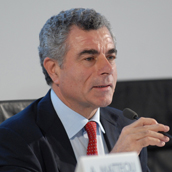
Mauro Moretti elected Chairman of UIC Europe
4 Feb 2014
Mauro Moretti, CEO of Gruppo Ferrovie dello Stato Italiane, has been unanimously elected in Paris as European Chairman of the Union Internationale des Chemins de Fer (UIC).
In his speech, accepting this important international post, Moretti underlined the need to have a competitive railway system for the sustainable and responsible development of transport. This mission will be pursued if the railway knows how to invest in technological innovation and push for the greater standardisation and interoperability of national networks.
Moretti focused in particular on Shift to Rail, the 2014-2020 programme of research to which the European Union will allocate more than €1 billion. FS Italiane, a member of the steering committee for the initiative, will be taking part directly, whereas UIC Europe will be representing all the smaller undertakings.
Press Release of FS Italiane, 12 December 2013
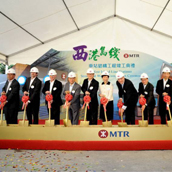
MTR West Island Line Stations Structural Works Completed New Rail Line On Track for Opening in 2014
9 Dec 2013
The MTR West Island Line (WIL) has reached another exciting milestone with the completion of major structural works at all three new train stations, namely Sai Ying Pun Station, HKU Station and Kennedy Town Station.
Guests from the local community in Western District today (31 October 2013) joined the Chief Secretary for Administration Mrs Carrie Lam Cheng Yuet-ngor, GBS, JP, Secretary for Transport and Housing Professor Anthony Cheung, GBS, JP and Chief Executive Officer of MTR Corporation Mr Jay Walder to mark the occasion which brings WIL an important step closer to its scheduled opening next year.
Officiating at the MTR WIL Stations Structural Works Completion Ceremony, Mrs Carrie Lam complimented the MTR project team and the local community on their collaborative partnership in overcoming all challenges to bring the project forward to this stage.
“A high capacity railway is the backbone of public transport systems in densely populated cities such as Hong Kong. The West Island Line will be the first to be completed among the five on-going new rail projects in Hong Kong. Although the WIL is only 3.2 km in length, it serves a very important public transport function. Upon completion next year, the WIL will connect the oldest business district in Hong Kong with our current business and financial centre. Not only will it alleviate road-based traffic in this area, it will also drive economic activities and community development in the Western District,” said Mrs Lam.
“This new community railway is rapidly taking shape before us and we are well on track for opening next year. With major civil works completed for all three new stations, the electrical, mechanical and other fitting out works are now in full swing. We are thankful for the immense support from the local community over the past four years,“ said Mr Jay Walder, Chief Executive Officer of MTR Corporation. “MTR will continue to work closely with the local community and our partners to deliver a safe, reliable and efficient new railway line to serve the 200,000 people living and working in Western District.”
Sai Ying Pun, HKU and Kennedy Town stations have a total of 15 entrances providing a convenient pedestrian network in the district via the unpaid areas of the stations. Over 90 percent of the residents in Western District will have easy access to the railway on foot. While construction of Kennedy Town Station used the cut and cover method, Sai Ying Pun Station and HKU Station were constructed as underground caverns at depths of 50 metres and 70 metres below ground respectively. HKU Station will become the biggest and deepest station cavern in the existing MTR network. Sai Ying Pun Station will display the largest artworks area on the existing network with about 800 square metres of station art.
To date the WIL project is over 80 percent complete. Apart from a passenger tunnel linking up entrances at First Street, Second Street and Ki Ling Lane in Sai Ying Pun that are undergoing ground freezing excavation works, all passenger tunnels of the WIL are complete. Installation of the power supply systems for the stations and track, and energisation of the overhead line system are scheduled for completion in the fourth quarter of this year, allowing the testing and commissioning works for the operational railway to commence.
When the West Island Line opens next year, it will connect Western District to the existing MTR network. A journey from Kennedy Town to Sheung Wan will take only 8 minutes compared to the present 15 to 25 minutes by road-based transport.
Press Release of MTR, 31 October 2013
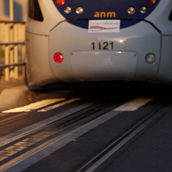
Ansaldo STS has been awarded the first tramwave® contract in China
9 Dec 2013
Ansaldo STS, a company in the Finmeccanica Group, has been chosen by CNR Equipment Engineering Co Ltd to build the first TramWave® catenary-free system in China, implementing the agreement that was signed in 2012 with CNR Dalian and with the Taiwanese company GRC. The Agreement provides for the construction of tramways with this innovative technology for the first time in the Chinese territory.
CNR Equipment Engineering Co Ltd, a company fully controlled by CNR Dalian, has therefore signed a contract, whose value is approximately 26 million Euro, for the construction of an 8.7 km double track line with Ansaldo STS’ innovative catenary- free system named TramWave®.
CNR Dalian has signed a framework agreement with the municipality of Zhuhai for the construction of a catenary-free tramway system in the city of Zhuhai. Line 1, which is the subject of this agreement, is the first phase of its implementation.
Zhuhai is a city in the southern coastal province of Guandong in the People’s Republic of China.
Ansaldo STS’ technological innovation keeps thriving and “the signing of this agreement represents a significant opportunity for Ansaldo STS in a new sector and contributes to achieving China’s goal of implementing a clean and sustainable urban transportation model. This is the starting point for developing further catenary-free systems in China and worldwide” – Sergio De Luca, the company’s CEO stated with satisfaction.
TramWave® is the innovative catenary-free electrical supply designed and patented by Ansaldo STS in order to promote urban transportation and to eliminate the visual impact of the traditional overhead catenaries.
This system provides benefits in terms of visual impact as it eliminates the unattractive overhead cables network by resorting to a ground-level traction power collection system.
Ansaldo STS has already implemented a section of more than 600 metres in a significant arterial road in the city of Naples. This allowed a system test to be carried out under particularly complex conditions, interacting with the urban context (e.g. heavy vehicles crossing). This system allowed the highest safety certification to be obtained from one of the most influential international certifying organisations.
Ansaldo STS is currently promoting the system in Italy and abroad, participating in important tenders. The widespread interest in TramWave® is proven by the extraordinarily successful outcome of the visits to the city of Naples by several European and Asian delegations.
Press Release of Ansaldo STS, 6 November 2013
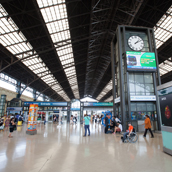
Bombardier Strengthens its Leadership in ERTMS Technology with a New Project in Chile
9 Dec 2013
Rail technology leader Bombardier Transportation will deliver its globally proven INTERFLO 250 European Rail Traffic Management System (ERTMS) Level 1 solution to improve passenger services and safety on the regional and commuter rail corridor of Rancagua. The system will be implemented on the 22 km line between Alameda station in central Santiago and the area of Nos in the city’s outskirts. The line connects further south to Rancagua (85 km) and then to Chillán (400 km). The contract is valued at approximately 15 million euro ($21 million US).
With the new system, the Chile state railway operator, Empresa de los Ferrocarriles del Estado (EFE), expects to increase annual passenger numbers from 6 million to 18 million. The system is designed to enable minimum headways of a mere four minutes and will cut travel times for commuters. It is the first ERTMS project in Chile and only the second in Latin America; Bombardier is also delivering its ERTMS technology to improve the SuperVia commuter service in Rio de Janeiro, a network with 225 km and 89 stations.
The project will include the latest generation BOMBARDIER EBI Lock 950 R4 computer-based interlocking, EBI Screen control centre and EBI Track train detection systems, onboard systems and five years of maintenance. In addition, the control centre will manage traffic over the entire Santiago-Nos-Rancagua-Chillán service.
Bombardier’s INTERFLO 250 technology enables the automatic and safe management of travelling time between trains, including automatic stops if a signal instruction or a speed limit were to be passed. This automatic train protection (ATP), when associated with the traffic management system, reduces headways and optimises speed. This results in increased line capacity with safety as a top priority.
Bombardier’s ERTMS systems are installed on over 2,300 rail vehicles and more than 21,000 km of track in 17 countries, on new systems as well as retrofits for 75 different vehicle types. Global contracts include first-in-market projects underway in Brazil and delivered in Croatia (Level 1), implementation in Algeria, Turkey (Level 1) and Poland (Level 2) and extensive framework agreements in Sweden
(Level 2). INTERFLO 450 ERTMS Level 2 systems are also operating at high speeds in China. Always innovative, Bombardier implemented the first ERTMS Regional (INTERFLO 550) solution, in Sweden.
The company’s portfolio of rail control solutions covers the whole range of BOMBARDIER CITYFLO mass transit solutions, from manual to fully automatic, as well as communications-based systems. It also provides INTERFLO mainline solutions, from conventional to ERTMS Level 3 systems. Bombardier also provides a complete palette of wayside and onboard signalling products.
Press Release of Bombardier, 28 October 2013
Photo by Almonroth
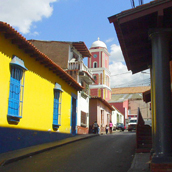
Odebrecht Inaugurates Train Line in Venezuela
9 Dec 2013
Odebrecht Infrastructure celebrated the start of operation of the Bolivarian Cable Liner in Venezuela. The construction work for the train line in the State of Miranda inaugurated its first phase in the community of Petare.
Differently than the country’s other transport systems, the project has an important differential: the trains are operated through a control room, without the need for a conductor. The inauguration ceremony was headed by Nicolás Maduro, Venezuela’s President, together with Haiman El Troudi, the country’s Minister of Ground Transport.
The first stage of the Cable Line project includes three stations – Petare II, 19 de Abril and 5 de Julio – which, after the conclusion of the Waraira Repano and 24 de Julio stations, will create a connection with Line 5 of the Caracas Subway and with the Caracas Guarenas Guatire Mass Transport System (STMCGG), both of which are currently under construction.
Each day, at seven-minute intervals, some 120,000 people will be able to ride the Bolivarian Cable Liner from the neighborhood of Petare Norte to the subway station. It currently takes inhabitants 40 minutes to complete the same route by car.
The installation of the new transport system will generate an improvement in the population’s quality of life and also bring benefits to the community located near the train line. Complementary projects are also being completed, such as the construction of a municipal market and the revitalization of public areas.
Press Release of Odebrecht, 16 October 2013

Italcertifer will certify in Australia
9 Dec 2013
Italcertifer to arrive in Australia for its most distant mission.
The safety certification on the network owned and operated by the multinational mining company Rio Tinto has been assigned to the FS Italiane Group Company.
The activities, valued at more than € 1 million, will last about two years and will cover the assessment of the Control, Command and Signaling System built by Ansaldo-STS covering approximately 1,300 km of the 1,500 km private railway network.
Italcertifer brings significant know-how and in-depth understanding of the entire railway processes, and in particular the signaling systems of Ansaldo STS, a leading Italian company in the rail sector.
The system will allow optimization of rail traffic improving the timely delivery of iron ore-loaded trains to the ports. With this innovative system that does not require a driver on board the locomotive, variability of scheduling and delivery will be minimized, contributing to the increase in export capacity from 290 millions tons per year to at least 360 million tonnes.
Rio Tinto’s rail network is used to transport iron ore to its ports of Dampier and Cape Lambert from the company’s 15 mines in the Pilbara region, located in the north west of Australia. The iron ore is mainly destined for the Chinese, Japanese and Korean markets. It is transported by freight trains, up to 236 wagons, each carrying about 25.000 tonnes, pulled by three diesel locomotives.
With this contract, Italcertifer confirms its leading role in the national and international certification sector. This follows contracts covering the Italian High Speed System and the Brenner Base Tunnel, and certification for High Speed and conventional lines in Turkey, the Mecca-Medina High Speed line in Saudi Arabia, the Shah-Habsan-Ruways line in the United Arab Emirates and many others in countries such as China, India, Sweden, Finland, Denmark, Czech Republic, Bulgaria, Poland and Greece.
Press release of Italcertifer, 4 November 2013
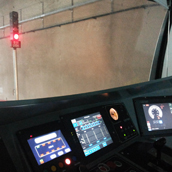
Siemens to supply signaling and control equipment for a freight line in Mozambique for the first time
9 Dec 2013
Siemens is to equip the around 900-kilometer line with signaling and control systems. The project is part of the Nacala Corridor, which extends from the coast of Mozambique across country via Malawi into the mountains of Mozambique to Moatize. Both terminal stations are in Mozambique. The railroad line will carry coal from a mine in Moatize to a loading station on the coast for shipment. The order, worth a total of around 70 million euros, was placed by joint venture Corredor Logístico Integrado de Nacala (CLN), formed by Brazilian largest mining company Vale and Mozambique’s state-run railway company Caminhos de Ferro de Moçambique. “Our solutions for the mining industry increase the safety, capacity and reliability of our customers’ coal transports and provide economic and sustainable benefits for CLN. We are proud that our technology has been so successful in Mozambique,” said Kevin Riddett, Head of the Siemens Freight and Products Business Segment. Commissioning is scheduled for 2015.
For the 912-kilometer line, Siemens will provide the Train Sentinel PTC (Positive Train Control) system, the train integrity monitoring, Westrace type solid-state interlockings, and a telecommunication system based on a microwave network and a Tetra system for track to train data transmission. The contract also includes equipping the operations control center in Nacala and maintaining and servicing of the signaling equipment for one year.
Installation of the new signaling and telecommunications equipment will enhance safety, capacity, and reliability of coal transportation. It will also enable more frequent trains. The automated system calculates the optimum speed and headway between trains based on the line data. This enables the railway operators to increase their network capacities by minimizing headway, improve the punctuality of their trains, and ensure energy-efficient operation.
Siemens Low and Medium Voltage Division is to supply and install the power distribution solutions for the new deepwater port in Nacala-a-Velha, Mozambique. The medium and low-voltage switchgear, including motor control centers, will be installed by Siemens in prefabricated electrical equipment houses, which will be delivered to Africa as turnkey units. The order value is in the middle double-digit million euro range.
Press Release of Siemens, 5 November 2013
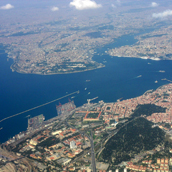
Istanbul’s Bosphorus rail link finally opens
9 Dec 2013
TURKEY celebrated the completion of the rail connection between the European and Asian sides of Istanbul on October 29, with the inauguration of the Lira 9.2bn ($US 4.6bn) Marmaray link beneath the Bosphorus.
The opening ceremony, which was held to coincide with the 90th anniversary of the founding of the Turkish Republic, was attended by Turkish President Mr Abdullah Gül and Prime Minister Mr Recep Tayyip Erdogan, Japanese Prime Minister Mr Shinzo Abe, Romanian Prime Minister Mr Victor Ponta, and Somali President Hasan Sheikh Mahmud.
The 13.3km tunnel between Üsküdar on the Asian side and Sirkeci on the European side includes a 1.4km section of immersed tube tunnel constructed at depths of up to 60m below sea level, making it the deepest tunnel of its type in the world.
Shuttle services will initially operate between Kazilicesme and Üsküdar until the rest of the project is completed. The line will ultimately run for 76.3km from Halkali in the west to Gebze in the east, reducing the journey time from 1h 45min (by train and ferry) to 1h 4min. The Marmaray line is expected to carry 1.5 million passengers per day by 2015.
The new railway is one of the first in the world to combine ERTMS and CBTC. On the surface, train detection is by jointless track circuits, and the two commuter tracks are fitted with both CBTC and ERTMS, while the third track will only have ERTMS. The tunnel will have both types of train control but train detection will be by axle counters. Fall-back lineside signalling will be installed throughout the Marmaray line.
Hyundai-Rotem is delivering a fleet of 34 10-car and 20 five-car emus for the line under a €580m contract signed in November 2008. Some of these trains are being assembled in Turkey by Eurotem a joint venture of Hyundai-Rotem and Turkish partner Tüvasaş.
The link was first proposed as long ago as 1860 by the Ottoman sultan Abdoul Medjid, but it was not until 2004 that the project was approved by Erdogan, then mayor of Istanbul.
Source: www.railjournal.com, 29 October 2013
Photo by Ail Subway
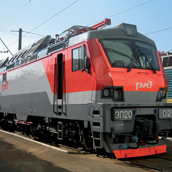
Russian Power Package to Receive Voith Gear Units
9 Dec 2013
Russian Railways (RZD), currently Russia’s largest rail operator, is invest- ing heavily in the modernization of its fleet. Series EP20, a six-axle electric locomotive, has been built in Russia since 2011. Voith is now delivering 804 gear units for 134 locomotives of this type.
The EP20 is one of the most powerful mainline locomotives in Europe. The locomotive has three bogies with two driven axles each. The maximum output of the loco is 7.2 MW, which corresponds to the power of about
100 cars. A major criterion for the Russian manufacturer Transmashhol- ding was that the transmission would be able to cope with the high axle loads of 22.5 tons as well as the extreme weather conditions.
Temperatures of minus 50 to plus 55 degrees centigrade make heavy de- mands on the drive units of the locomotive. The newly developed SEH-525 gear unit from Voith, a fully suspended single stage helical gear unit with a hollow output shaft, is the ideal solution for these conditions. From 2014 Voith will be delivering twelve gear units to Russia every month.
Russian Railways will put a total of 200 new EP20 locomotives into ser- vice. The first ones are already in operation on the route between Moscow and St. Petersburg with maximum speeds of up to 200 km/h. Visitors to the 2014 Olympic Winter Games will also benefit from this modern rail power package when they are on their way to Sotschi.
Press Release of Voith, 5 November 2013

Cubic and Southern Railway Team Up to Provide ITSO on Southern and Transport for London Network
9 Dec 2013
Cubic Transportation Systems and Southern Railway have joined forces to upgrade the ITSO smart ticket acceptance capabilities at 90 stations on the Southern Railway network outside London. This work is in conjunction with Transport for London’s (TfL) ITSO on Prestige project which has recently upgraded the smart card ticket acceptance at four National Rail stations within the London fares zone area to allow customers to use ITSO-based tickets as well as Oyster cards.
ITSO on Prestige is a Department for Transport (DfT) funded project to enable the TfL transport infrastructure around London to accept ITSO cards on its Oyster rail, Underground, bus and tram network. The requirements of this project have been refined over the last two years by a cross-industry group including the Association of Train Operating Companies and attended by major railway operators including Southern, ITSO, TfL and Cubic.
With London Victoria, London Bridge, Clapham Junction and East Croydon rail stations now capable of accepting ITSO smart card tickets, season ticket holders south of Gatwick will be able to complete their journeys using ‘the key’ – Southern’s branded ITSO smart card. As well as using season tickets in early 2014, Southern plans to launch Travelcards along with single and return tickets across its network. Passengers who buy their tickets online can collect them from the gate as they start their journey at stations south of Gatwick instead of having to queue to buy them from a ticket office.
To complement the ITSO deployment, Cubic has also implemented new gate lines at Gatwick Airport and Brighton, the biggest stations served by Southern outside of London. The next stage of the project will see Cubic deploy the technology to provide ITSO capability on the remaining Oyster overground gate estate, with the final stage enabling London Underground and buses to accept ITSO cards in early 2014.
To enable passengers to use ITSO smart cards across the Southern network, Cubic has installed its latest design of ITSO validators. Passengers can now ”touch in” with ITSO cards at the majority of Southern stations and ”touch out” at Southern’s London termini, or vice versa.
“This project is the UK rail industry’s leading deployment of ITSO on a commercial basis. All parties involved have discovered and resolved many issues during the process and have worked positively and collaboratively to deliver a great outcome. This approach, based on teamwork, sets the standard for the way to design, implement, test and deploy ITSO rail schemes,” explains Steve Chilver, operations director for Cubic Transportation Systems. “Because Cubic provides the ticketing system for TfL, we were in a unique position with Go-Ahead to create an additional test suite on site at Cubic’s UK headquarters to ensure seamless integration with the London smartcard network.”
Cubic project manager, Glen Fry, explains: “By having the TfL and Go-Ahead facilities located on one site, we were able to quickly and easily run end-to-end journey tests across the two estates, for example, from Brighton to Victoria. The frequent presence of Go-Ahead engineers on site also allowed us to work together on integrated testing with other suppliers’ equipment within the test suite and to build up valuable knowledge within both teams for the pilot and launch.”
Riz Wahid, head of retail development for Southern, said “We are very proud of what we have delivered for our customers. Working with Cubic we have been able to provide a robust system that allows us to provide the best technical solution to support our retail strategy. Working with Cubic and having their resources and experience on this project has been a key contributor to our successful delivery of the key across our network”.
Dave Lynch, IT and procurement director for Go-Ahead Group Plc, said, “Today is the end of a complex technical project made possible by our suppliers and partners TfL and DfT. It is at the same time the start of real innovation in ticketing for our customers in the UK rail industry. Future phases will deliver on the DfT’s door-to-door strategy providing truly multi-modal journey integration with TfL’s Tube and bus services on a single smart card. Cubic has proved again with this project that they are second to none in their delivery of complex IT projects delivering real passenger benefits.”
Press Release of Cubic Transportation Systems, 6 November 2013
Photo by: Mark Quinn
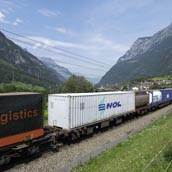
Harsco awarded $100+ million railway track maintenance
9 Dec 2013
Diversified global industrial company Harsco Corporation announced today a major railway track and infrastructure maintenance equipment award from SBB, the federal railway system of Switzerland.
The contract comprises an initial order worth over $100 million through 2016, together with provisions for future options. Harsco Rail will supply SBB with a combination of specialty vehicles and Utility Track Vehicles (UTVs), a highly versatile rail-based maintenance configuration equipped with cranes, generators and/or work platforms that is widely used by railways throughout the world. Delivery of the first vehicle is scheduled for 2015.
The units will be deployed on the Gotthard and Ceneri Base Tunnels. Both tunnels are integral parts of the Swiss AlpTransit project, a major undertaking to increase transport capacity across the Alps, while at the same time reducing the environmental damage associated with highway truck transport. The new technology Harsco Rail is developing for SBB will further support emissions reduction by utilizing an advanced, dual-mode traction system which, in turn, reduces diesel fuel consumption.
“This contract is a major strategic win that goes beyond simply the dollar size of the order,” said Harsco President and CEO Patrick Decker. “Not only does it energize the growth of our European Rail business model and support our future objectives, it speaks also to our capacity for technical innovation and responsiveness to stringent customer specifications.”
The SBB award considerably broadens the business landscape for Harsco Rail, introducing the first products the division will design and manufacture in Europe. Harsco Rail will purchase forty percent of the content for the UTVs from Swiss suppliers, and also will utilize components from other proven European railway suppliers.
“The SBB contract marks a new chapter in Harsco Rail’s history,” said Harsco Rail President Scott Jacoby. “Our European team is building technical and local sourcing relationships that add another dimension to our capabilities, particularly in such an influential equipment market as Europe. We’re excited to see our Harsco UTVs leading a new generation of railway maintenance vehicle technology.”
Press Release of Harsco, 31 October 2013
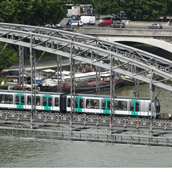
MF01 metro inaugurated on Line 9 of the Paris transport network
9 Dec 2013
The MF01 metro train1 built by a consortium consisting of Alstom Transport, Bombardier Transport and Areva TA was inaugurated today on Line 9 of the Paris metro. With a special livery defined by regional transport authority STIF and Paris public transport operator RATP, the first MF01 trainset was unveiled at Porte de Saint-Cloud station in the presence of STIF Chairman Jean-Paul Huchon, RATP CEO Pierre Mongin and Managing Director of Alstom Transport France Jérôme Wallut.
The inauguration represents a milestone in the contract signed between RATP and the consortium whereby a third option for 66 MF01 units was taken up in 2011, with Alstom taking charge of project management, component supply and assembly of the railcars. A total of 161 metro trains were ordered under the contract signed with RATP in 2001.
Particular emphasis has been placed on the interior comfort of the new metro cars. MF01 is fully accessible and has wide corridors and gangways for more fluid movement and reduced changeover times in stations. The large windows and bright interior colour scheme create a light and spacious feel. Noise levels and vibration inside the car have been reduced through the use of ONIX traction equipment for improved acoustic comfort.
Respect for the environment is also an essential feature of Alstom rolling stock design. The MF01 consumes 30% less energy than a conventional metro train through improved efficiency of the power train and a high-performance energy-recovery electric braking system.
Alstom’s expertise in metro design, whether it is steel-wheeled (MF01) or tyre-mounted technology (MP05 ), is confirmed by the excellent track record of reliability of its trains in service on the Ile-de-France network. Nearly a hundred MF01 metro cars have been running on Line 2 since 2007 and on Line 5 since 2011 at levels of reliability compliant with the safety requirements specified by the operator. The MP05 class, which will be celebrating two years of operation on Line 1 in November, also boasts an excellent track record in commercial service, with a level of reliability well above contractual requirements. These results demonstrate the high level of quality of Alstom metro trains, which are designed to offer the best operational performance for the benefit of operators and passengers.
Five Alstom sites are involved in the project: Ornans for the motors, Sesto (Italy) and Tarbes for the traction/braking systems, Villeurbanne for the on-board computer and passenger information systems, and Valenciennes for interior layout, equipment integration, assembly and testing.
Press Release of Alstom, 21 October 2013

WEGH Group confirms its presence in Argentina with a new plant for PREAR
7 Oct 2013
WEGH Group Long-Line technology is once again leader in Latin America.
PREAR Pretenseados Argentinos s.a., one of the main contractors in Argentina, part of CARTELLONE Group, chose to trust WEGH Group experience and competence in the realization of plants for the production of PRC railway sleepers.
In Buenos Aires, last 19th of July, Pablo Mazzucchelli, General Director of PREAR and WEGH Group Area Manager, Gianpaolo Beghi signed a contract for the supply of a Long-Line plant with one production line that will build over 130.000 railway sleeper per year, destined to the Buenos Aires-Mar del Plata and Buenos Aires-Rosario railway routes.
The contract was signed in the presence of Graciela Priori, Administrative Responsible of PREAR, and Carlos Salvatore, Responsible of the San Pedro plant, where the new plant will be placed side by side to the already existing precast lines.
Press Release of WEGH Group, 1 August 2013
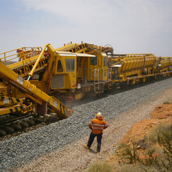
John Holland awarded $257 million sub-contract at Roy Hill
7 Oct 2013
John Holland has been chosen to construct nearly 350km of heavy haulage railway track for the Roy Hill Iron Ore Project in Western Australia.
The Roy Hill Iron Ore Project includes a new mine at the Roy Hill deposit north of Newman, a mine process plant, a heavy haul railway system and new port facilities at Port Hedland.
The $257m rail construction, track works and infrastructure sub-contract awarded to John Holland by Samsung C&T will traverse through remote terrain from the Roy Hill mine site to Port Hedland.
Leighton Holdings Chief Executive Officer, Hamish Tyrwhitt, said the contract award evidences the diversity of the Leighton Group, combining our skills in managing operations in remote locations and in the provision of infrastructure and rail operations.
“We are proud to be involved in such a major undertaking for Western Australia. Roy Hill is a critical project for the state, and a strong indication that the nation is moving to close its infrastructure deficit and improve productivity,” he said.
John Holland Group Managing Director, Glenn Palin, said that by winning this project against national and international competition, John Holland had once again demonstrated its key strength in rail.
“John Holland has been a market leader in rail construction in Australia for over 30 years, with approximately $3b of rail-related projects in hand,” he said.
The two year, construct only project, is planned to commence on site in October 2013. At the peak of site works the project workforce is expected to reach 270 people.
John Holland’s contract involves track works to the main line, marshalling yard, mine loading loop, port loading loop, wayside loops and spurs and construction yard. The contract also involves construction of a logistics yard and ballast yards.
Press Release of John Holland, 13 September 2013
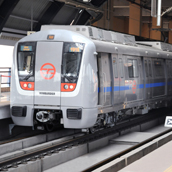
Bombardier Wins Major New Order from Delhi Metro Rail Corporation
7 Oct 2013
Rail technology leader Bombardier Transportation has won a major new order from Delhi Metro Rail Corporation (DMRC) to provide the first driverless unattended mass transit solution in India. The globally-proven CITYFLO 650 communications-based train control (CBTC) solution will be delivered to the Line 7, the latest part of Delhi’s metro expansion plan which will greatly enhance transportation options in this mega city. The contract is valued at approximately 3.9 billion INR ($62 million US, 47 million euro).
Bombardier’s project scope covers the design, manufacture, supply, installation, testing and commissioning of the advanced, moving block, radio-based system for the 58.4km line. This includes, both unattended and automatic train operating (UTO and ATO) modes. Commissioning is planned in two phases: the 54.4km line from Mukundpur to Maujpur to in 2015 and a further 4km line from Maujpur to Shiv Vihar in 2017. Reflecting the quality of its technology and the strength of the partnership, Bombardier is now DMRC’s largest contractor for signalling and train control solutions. Bombardier’s semi- automatic train operation (STO) technology, the CITYFLO 350 solution, has been operating on Lines 5 and 6 since 2010 and is currently being delivered for the extensions to both lines.
Peter Cedervall, President, Rail Control Solutions, Bombardier Transportation, said: “This is another important new contract with our valued customer Delhi Metro, supporting their expansion of the network. Following our successful partnership on the upgrades of Lines 5 and 6, we are very much looking forward to working together to introduce our latest and most advanced mass transit technology to the city, and continue our long term partnership to improve the transportation options in the city.”
CITYFLO 650 is a highly-proven, automatic train control solution designed for high-capacity metros and monorails. A moving block CBTC system, with modern radio-based area networks communicating between the control centre and the train, this advanced solution delivers improved safety, capacity and reliability as well as shorter headways between trains and reduced maintenance costs.
Around the globe CITYFLO 650 is in operation on 17 new and upgraded lines, from Shenzhen in China to Madrid in Spain and San Francisco in the US. The latest applications are being delivered to London Underground in the UK for the major four-line Sub Surface Railway signalling upgrade as well as to the new Klang Valley Mass Rapid Transit system in Malaysia, the São Paolo Metro in Brazil and other projects in Germany and Saudi Arabia.
Bombardier’s Rail Control Solutions portfolio covers the whole range of CITYFLO mass transit solutions, from manual to fully automatic systems as well as communication-based systems. It also provides BOMBARDIER INTERFLO mainline solutions, from conventional systems to European Rail Traffic Management System (ERTMS) Level 2 systems. Bombardier solutions encompass a complete palette of wayside and onboard products.
Press Release of Bombardier, 12 September 2013

GERMAN infrastructure manager DB Networks has launched a project which aims to determine the optimal rail profile for minimising noise from rail traffic in built-up areas.
7 Oct 2013
Over the next few years, rails of varying profiles will be tested on a 2.5km stretch of the Dresden – Elsterwerda line, with the evaluation focussing on long-term performance and the impact on maintenance.
DB Networks says the profiles at this location are not currently being used anywhere else on the German mainline network. It expects to complete the installation phase by the end of November.
The project is being funded by the German federal government through its rail noise abatement programme.
DB Networks has committed to reducing train noise by 50% between 2000 and 2020, which it says can only be achieved through a combination of modifications to vehicles and track.
Source: International Railway Journal, 13 September 2013
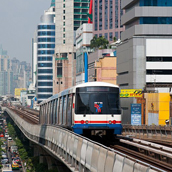
Alstom to carry out Bangkok’s Green Line Extension
7 Oct 2013
Alstom has been awarded by Ch. Karnchang Public Company Limited, one of Thailand’s leading general contractors and basic infrastructure designer, a contract worth €14 million to extend Mass Rapid Transit Authority of Thailand’s (MRTA) existing Green Line. Alstom will participate in the works to design and build the trackwork and the third rail power collector from Bearing to Samutpakran Station as well as the 48 acre depot that will house 40×3 car trains intended to circulate on the extended line.
The extension will add nine stations from Bearing to Samutpakran at a total length of 12.6km and aims to carry up to 57,000 passengers per day. The project is set to begin construction at the end of 2014 and completed in 2017.
This project is part of Thailand’s program to improve its public transport infrastructure and better address the growing traffic congestion issues. With more than 3 million cars and nearly 3 million motorcycles in Bangkok, the Thai government has decided to invest Bt2.2trillion (€52.7 billion) in infrastructure development programmes which results in 55 projects of which 31 (representing 64% of the budget) will be dedicated to Rail transport. The extension of the green line is part of the program led by the Thai government.
The Green Line, better known as the Sukhumvit Line, currently extends from Mo Chit, located close to the popular Chatuchak Weekend Market to Bearing in the Bang Na District. The extended line will enable more residents of the city of Bankgok to opt for a safer, cleaner mode of transport.
Dominique Pouliquen, Senior Vice President of Alstom Transport Asia Pacific declares “We are excited to take a key role in the development of Thailand’s transport infrastructure. The confidence shown in Alstom, backed by what we have delivered for the blue line, is a true testament to our technology and expertise and further consolidates our position as the leading metro system provider in Asia.”
Press Release of Alstom, 2 September 2013

UK trains could benefit from high-speed satellite broadband service
7 Oct 2013
Ofcom is exploring the possibility of allowing a new high-speed satellite-based broadband system onboard trains, planes and ships in the UK.
The regulator has launched a consultation into the use of Earth Stations on Mobile Platforms (ESOMP) over the current slower FSS networks.
Technological advances mean it is now possible to fix an antenna to a fast moving vehicle, such as a train, that is accurate enough to track a satellite.
In the consultation document, Ofcom said: “When the ESOMP is combined with on-board access technology, it will allow consumers who are travelling to have broadband connectivity over wide territories where other technology is not available.”
Ofcom is planning to release another statement about the proposals in December and, depending on the response, could authorise ESOMPs as early as the start of 2014.
Source: www.globalrailnews.com, 21 August 2013
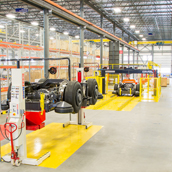
Alstom starts building bogies for Montreal’s new metro cars
24 Jul 2013
Alstom today inaugurated its new 55,000-square-foot bogie manufacturing plant located in the cutting-edge industrial complex in Sorel-Tracy, Quebec. Built to serve Alstom’s needs in the context of a $1.2 billion CA ($864 million €) contract between the Bombardier-Alstom consortium and the Société de transport de Montréal (STM) to supply the STM with 468 new metro cars, the plant will assemble more than 900 bogies.
The bogie, which has been designed to meet the STM’s requirements, is a unit that supports the metro car and includes the drive, braking and suspension mechanisms that ensure passengers’ comfort and safety. Alstom anticipates that the first bogie manufactured in Sorel-Tracy will be completed in the fall of 2013.
“This transfer once again demonstrates Alstom Transport’s ability to localize manufacturing operations to be closer to its customers and users,” said Guillaume Mehlman, president of Alstom Transport in North America. “Beyond this first contract with the STM, the Alstom plant in Sorel-Tracy, with its state-of-the-art equipment, will be able to meet the most complex needs of North American public transit corporations,” he added.
“By locating the manufacturing and assembly operations for the bogies in Quebec, Alstom is proud to contribute to the STM’s requirement for 60% Canadian content,” said Claude Lambert, vice-president and general manager of Alstom in Sorel-Tracy.
The transfer of technology is part of Alstom’s strategy to address local market needs. Therefore, the transfer of technology and expertise for bogies and shock absorbers from the Alstom centre of excellence, Le Creusot, in France, to Sorel-Tracy plant, will enable Alstom to better address the North American market. The motors that will be integrated into the bogies of Montreal’s metro cars will come from the Alstom manufacturing centre in Hornell, in New York State. The bogies assembled in Sorel-Tracy will then be shipped to the Bombardier plant in La Pocatière, where the cars will be mounted on them.
In addition to the bogies, Alstom, through its various sites including the one in Montreal, will be supplying traction, train control, communications and passenger information, and video-surveillance systems for the new metro cars. Over the eight-year span of the contract, more than 300 Alstom employees in Quebec will take part in designing, manufacturing and commissioning the new cars, which will be delivered to the STM.
Montreal’s metro comprises four lines with a total of 71 km of track and 68 stations. Each metro car travels about 78 million kilometres per year.
Press Release of Alstom Transport, 5 July 2013
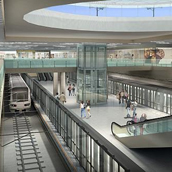
Hitachi Received an Order for Electrical and Mechanical Equipment on “Urban Railway Line 1″ in Ho Chi Minh City, Vietnam
24 Jul 2013
Hitachi, Ltd. today announced that it entered into an order contract with Management Authority for Urban Railways of the People’s Committee of Ho Chi Minh City for the construction of Vietnam’s first urban railway in Ho Chi Minh City (between Ben Thanh – Suoi Tien “Line 1″). The contract carries a total value of approximately 37 billion yen.
In Vietnam, the rapid increase in traffic volumes resulting from economic growth has become a serious issue, and public transportation is expected to contribute to resolving traffic congestion and protecting the environment. Under this circumstance, the Vietnamese government has made plans for the construction of several urban railways in Ho Chi Minh City. This project represents the first phase of these plans.
Line 1 is a new urban railway scheduled to begin operations in early 2018. Plans call for the construction of a railway track with a total length of 19.7 km (including both underground and elevated tracks) connecting the center of Ho Chi Minh City with North-East gateway of the city, where there are bus terminals towards northern provinces. Hitachi is to deliver subsystems including 17 train sets (total: 51 cars), signaling system, telecommunication system including wireless train radio system, and power supply system, as well as platform screen doors, automatic fare collection system, and depot facilities. Hitachi is also scheduled to undertake five years maintenance work after the start of commercial operations, of which details is to be stipulated in the separate agreement at later stage.
This project represents Vietnam’s first full-scale urban railway project, and Japan International Cooperation Agency (JICA) has pledged to provide Special Terms for Economic Partnership (STEP) ODA.
Hitachi will continue activities aimed at expanding business opportunities for the many urban railways currently being planned in Ho Chi Minh City and Hanoi, Vietnam. Hitachi will also accelerate the global rollout of its rail business, in an effort to further expand sales activities for urban railway projects in Vietnam and other countries in Southeast Asia.
Press Release of Hitachi, 11 June 2013
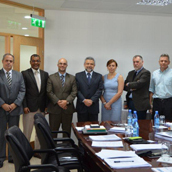
WEGH Group signs a contract for the supply of sleepers for Nacala Corridor
24 Jul 2013
On May 31st, Alessandra Belloni, CEO, and Giovanni Cozzi, Area manager of WEGH Group signed a contract for the supply of 1.200.000 concrete sleepers for the rehabilitation and construction of the Nacala Corridor railway line, in Mozambique.
In order to achieve a better rooting in the Country, WEGH Group will found a corporation under Mozambican legislation, making the most of its know-how both in the realization of track systems plants and in the production of railway sleepers.
WEGH Group will supply concrete sleepers produced in its production plant based in Namialo, along the railway line. The Long-Line plant is similar to the one already supplied to Mota-Engil Engenharia e Contruçao S.A. for the construction of the line section that moves through Malawi.
Nacala Corridor will push the economic development of Mozambique and create new jobs.
Press Release of WEGH Group, 24 June 2013
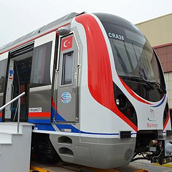
Marmaray test operation to start next month
24 Jul 2013
TURKISH State Railways (TCDD) has confirmed that test operation will begin on August 2 on the Marmaray link between the Asian and European sides of Istanbul.
The 13.3km tunnel under the Bosphorous is due to open on October 29, the 90th anniversary of the founding of the Turkish Republic, and services will initially operate between Kazilicesme, Yenikapi and Sirkeci on the European side and Üsküdar on the Asian side until the rest of the project is completed. The line will ultimately run for 76.3km railway from Halkali in the west to Gebze in the east.
Construction began in August 2004 and Lira 5.2bn ($US 2.7bn) has been invested in the project so far. The total cost of construction is expected to be Lira 9.2bn.
The new railway is one of the first in the world to combine ERTMS and CBTC. On the surface, train detection will be by jointless track circuits, and the two commuter tracks will be fitted with both CBTC and ERTMS, while the third track will only have ERTMS. The tunnel will have both types of train control but train detection will be by axle counters. Fall-back lineside signalling will be installed throughout the Marmaray line.
The fleet of 54 Hyundai-Rotem commuter emus will be equipped exclusively with CBTC and drivers will refer only to their cab displays. Initially, only maintenance vehicles will be fitted with ETCS, but as TCDD’s high-speed fleet is already equipped with ETCS they will be able to use this on the Marmaray line.
Source: www.railjournal.com, 8 July 2013
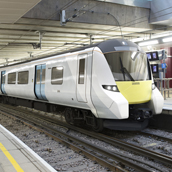
Thameslink contract signed: Siemens to deliver trains worth circa 1.8 billion euros
24 Jul 2013
Siemens has secured an order for the supply of 1,140 new commuter rail carriages in Great Britain for a total of around 1.6 billion pounds (approximately 1.8 billion euros). In addition, Siemens will be responsible for the long-term maintenance of the fleet and overseeing construction of two new train maintenance depots. This is the largest order that Siemens has ever won in Great Britain and one of the biggest orders for Siemens’ global rolling stock business. Siemens partnered with Cross London trains (XLT) for this important contract. XLT is a consortium comprising Siemens Project Ventures GmbH, Innisfree Limited and 3i Infrastructure plc and will be responsible for financing the deal.
“This order is an impressive reminder of our leading position in the British rail market, where we enjoy an excellent reputation. Our commuter trains are seen as the most reliable in the country. Annually, more than 350 trains travel over 80 million kilometers in Great Britain,” says Jochen Eickholt, CEO of Siemens Rail Systems.
The Thameslink north-south commuter route runs through London, connecting Bedford, located to the north east of the capital, with Brighton, on the south coast. Introducing a high capacity, high frequency service of longer trains, extended platforms and new stations, the project is regarded as one of the largest rail infrastructure projects in the UK. Siemens was named preferred bidder in June 2011.
For the Thameslink project Siemens invested almost 50 million euros in the development of a new train platform. The new Desiro City for suburban, regional and main-line transport reduces overall energy consumption and track wear by up to 50% compared to predecessor models. Thanks to an improved interior layout, the new generation of trains also offers greater comfort and increased flexibility. The number of seats and the distances between them can also be varied according to passenger demand or the area of deployment, providing additional standing room or space for bicycles and wheelchairs where needed. The trains will be manufactured at the Siemens factory in Krefeld, Germany, and the first trains will enter service in 2016.
Backed by years of experience gained from the delivery of around 1,500 cars of its service-proven Desiro platform for Great Britain, Siemens developed the Desiro City – a new platform designed specifically for the British market. These trains are up to 25 percent lighter than the existing Desiro UK fleet, thanks mainly to car bodies of lightweight aluminum construction and to bogies that are approximately one-third lighter in weight. It has a recycling quota of about 95 percent. The Desiro City is based on the Single Car Concept, which integrates the entire traction equipment into one motor car. All of these motor cars are identically equipped and can be used both as end cars and as intermediate cars. This ensures a high degree of flexibility when it comes to adjusting the train configuration to cope with expected passenger volumes.
The Desiro City Thameslink can be coupled to form 8 and 12-car trains and operated in dual mode (750 V DC or 25 kV AC). They are built for a top speed of 160 km/h or around 100 mph. Siemens on-board units (OBU) that meet the requirements for the European Train Control System (ETCS) Level 2 safeguard the communication between the trains and trackside equipment. A heating, ventilation and air-conditioning (HVAC) system equipped with CO2 sensors automatically controls the flow of fresh air according to the number of passengers in each car.
Siemens will also oversee the maintenance of the fleet and build two new rolling stock depots in Three Bridges and Hornsey. Siemens is the market leader for service and maintenance in the UK, ensuring that over 350 trains enter passenger service each day. Including this latest contract, Siemens has now supplied close to 3,000 rail vehicles to Great Britain.
Press Release of Siemens, 27 June 2013
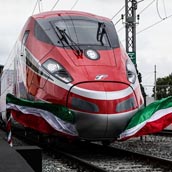
Bombardier Unveils Newest Very High Speed Train in Italy
24 Jul 2013
Rail technology leader Bombardier Transportation today hosted the world premiere of the Frecciarossa 1000 very high speed train at its Vado Ligure site in Italy. Built by Bombardier Transportation and its consortium partner AnsaldoBreda of Italy, the Frecciarossa 1000 is the newest member of the BOMBARDIER ZEFIRO family of high-speed trains and is known as the V300ZEFIRO model. This first train unit will now begin homologation test runs on the rail line between Genoa and Savona, which is also connected to the Bombardier Vado Ligure site. Regular passenger service is expected for early 2015.
Following the presentation ceremony attended by over 250 guests from Italy and other countries, the first group of passengers including Mauro Moretti, Managing Director, Trenitalia, Claudio Burlando, President of the Liguria Region, Lutz Bertling, President and Chief Operating Officer, Bombardier Transportation and Aldo Cingolani, CEO, Bertone Design, boarded the new train. Lutz Bertling was joined by Bombardier employees, Luigi Corradi, General Site Manager, Vado Ligure, Italy and Anders Lindberg, President, Rolling Stock Europe and Asia, Bombardier Transportation.
The V300ZEFIRO is the fastest train in Europe and is capable of reaching commercial speeds of up to 360 km/h. During test runs the train will reach speeds in excess of 400 km/h. Its advanced high acceleration enables the train to deliver excellent travel times, even on winding routes. It is fully interoperable and will provide cross-border services, taking passengers to other European countries without the need to change trains. It could also be adapted for use on networks in many other countries.
The train is an eight-car Electrical Multiple Unit (EMU) that can run in single operation and multiple operation of two units. It will have a total capacity of 485 across four classes, two additional tip-up seats for passengers with reduced mobility and a bistro.
Lutz Bertling, emphasised Bombardier’s commitment to the high speed rail market. He said, “We are delighted to be here today to unveil this stunning new train, which is a game changer in the industry. I am confident the Frecciarossa 1000 will become a world reference in very high speed travelling. It is a train that opens a window to a future in which high speed is not just about travelling faster but cost effectively, more comfortably safely and without frontiers. Finally, it is one of the most environmentally friendly transportation solutions.”
Press Release of Bombardier, 3 July 2013
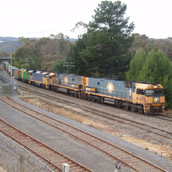
Balfour Beatty wins contracts for rail works in Australia
24 May 2013
Balfour Beatty is awarded a major contract in Melbourne, Australia as part of the NetworX Alliance team by Victoria’s Road Authority (VicRoads). The Alliance includes international infrastructure group Balfour Beatty through its Rail division and Professional Services division, Parsons Brinckerhoff.
The £76.5 million (A$116 million) contract will remove a pivotal rail/road level crossing in Melbourne, and aligns with Balfour Beatty’s strategy to develop in growth geographies and market sectors of which Australia and rail are both key elements.
Balfour Beatty Chief Executive, Andrew McNaughton, welcomed the news; “This is an excellent demonstration of the infrastructure expertise Balfour Beatty as a whole can bring to a complex project, utilising skills gathered from across our global business.”
Guy Templeton, Country Manager for Australia, commented; “This is the first Australian contract secured under the new country model structure and highlights the effective combination of the design skills of Parsons Brinckerhoff working together with project delivery expertise of our global rail business. We look forward to developing this strategy further within the Australian and New Zealand markets.”
The project to remove the level crossing will involve lowering the existing rail line beneath the road, which will reduce congestion, improve safety and cut journey times. A new station with transport interchange and associated precinct areas will be constructed as part of the project.
NetworX is an alliance consisting of Balfour Beatty Rail, Parsons Brinckerhoff, McConnell Dowell and Beca. The team will work alongside VicRoads, Public Transport Victoria (PTV) and Metro Trains Melbourne (MTM) to design and build the project.
Work is due to start in May 2013 and will be completed by the end of 2014.
Balfour Betty Press Release, 16 May 2013

Bombardier Technology Will Boost Transport Capacity in New Delhi
24 May 2013
The BOMBARDIER CITYFLO 350 mass transit solution will be delivered on the upcoming extensions to Delhi Metro’s Lines 5 and 6. The increased reach will further improve passenger transportation in one of the world’s busiest cities. Rail Technology leader Bombardier Transportation has won a new order from Delhi Metro Rail Corporation (DMRC) to deliver the CITYFLO 350 mass transit solution for the upcoming extensions to Delhi Metro’s Line 5 and Line 6. The extensions are part of Phase III of Delhi’s metro expansion plan, which is changing the face of public transportation in India’s capital. Increasing the reach of the two lines which are already operating with the Bombardier automatic train protection (ATP) technology, the new sections will further improve passenger transportation options in this important city. The contract is valued at approximately 2.5 billion INR (35 million euro, $47 million US). The extensions will add almost 35 km of double track and 23 stations to the existing 39 km in operation and are due to be completed in 2016. Bombardier’s project scope includes the design, manufacture and commissioning of the integrated train control and signalling system, including control centres, trackside and onboard equipment. The new sections will extend Line 6 from Central Secretariat to Kashmere Gate in the north and from Badarpur to YMCA Chowk in the south, and Line 5 from Mundka to City Park. Bombardier’s CITYFLO 350 technology has been operating on the two lines since operations started in 2010. “Bombardier has a strong industrial presence in India, which is central to our company’s growth strategy,” said Peter Cedervall, President Rail Control Solutions, Bombardier Transportation. “Our rail control technology is playing a vital role in the development of Delhi’s metro network, increasing capacity, safety and cost-effectiveness for the operator and enhancing transportation options for passengers. This new contract reflects Bombardier’s strong relationship with DMRC and our successful implementation. With our global expertise and local presence, we deliver proven vehicle and rail systems that solve capacity challenges in India and worldwide.”
CITYFLO 350 is a system with onboard automatic train protection (ATP) and automatic train operation (ATO), with both ATP information and ATO status displayed in the driver’s cab. The track to train communication is achieved via audio frequency track circuits and the system is designed primarily for metro applications where only limited action is required from the train driver. CITYFLO 350 systems are already in operation around the world including in Korea, Peru, Romania, Spain and Turkey.
Bombardier’s Rail Control Solutions portfolio covers the whole range of CITYFLO mass transit solutions, from manual to fully automatic systems as well as communication-based systems. It also provides BOMBARDIER INTERFLO main line solutions, from conventional systems to European Rail Traffic Management System (ERTMS) level 2 systems. Bombardier solutions encompass a complete palette of wayside and onboard products.
Press release of Bombardier, 17 April 2013

First High Speed Line in Morocco: Ansaldo STS (Finmeccanica group) and Cofely Ineo (GDF SUEZ group) selected for the signalling of the Tangiers-Kenitra line
24 May 2013
The contract has been signed in presence of His Majesty King Mohammed VI and Mr François Hollande, President of France.The Office National des Chemins de Fer (ONCF) has awarded to the consortium consisting of Ansaldo STS France and Cofely Ineo, the design and supply of the railway signalling, telecommunications and control traffic center of the future 183 km High Speed Line connecting the cities of Tangiers and Kenitra (along Atlantic coast). The total amount of the contract is Euro 120 Million.
Within the frame of the contract, Ansaldo STS, the leader of the consortium and reference company for the railway signalling and automations, based on its excellence in the French High Speed domain, will cover all of the phases of the signalling implementation from design to integration and commissioning.
Ansaldo STS will provide the telecommunication equipment, next generation interlocking, track circuits, ERTMS Level 1 & 21 based automatic train control and automatic train protection, as well as the control traffic centre located in Rabat. These technologies have either already been deployed or are currently under deployment in France.
Cofely Ineo, the major integrator of railway signalling solutions, will deploy the wayside equipment and will provide the power supply and the relating cable networks. Its engineering office will provide all of the execution plans required for the installation of complex and critical systems.
The complete system will allow safe and reliable commercial operations on the new line, up to 320 km/h.
With particular attentiveness to the social and economical development of Morocco, both Cofely Ineo and Ansaldo STS, within their respective domains, will strive to establish local partnership in order to organize and manage the transfer of knowledge to support the development of the skills and professionalism within the high speed rail sector.
Press release of Ansaldo Breda, 4 April 2013
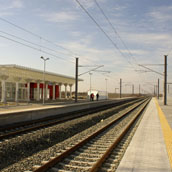
Bulgaria opens rebuilt rail link with Turkey
24 May 2013
Bulgaria’s interim prime minister Mr Marin Raykov and transport minister Mr Kristiyan Krastev today inaugurated the country’s reconstructed rail link with Turkey, travelling over the 16.9km line from Svilengrad to the border near the village of Kapitan Andreevo. The electrified single-track line is designed for 160km/h operation and includes a new 433m-long bridge across the Maritsa River (pictured) at Svilengrad. The line was designed and built by Czech contractor OHL ZS under a Lev 70m ($US 47m) contract signed with National Railway Infrastructure Company (NRIC) in May 2009, while a consortium of Alcatel-Lucent and Thales was responsible for signalling and telecommunications. The line is electrified at 25kV ac 50Hz and is equipped with ETCS Level 1.
The railway is the first Bulgarian project to be completed under the European Union’s Operational Programme on Transport 2007-13, which contributed Lev 46.6m in cohesion funding towards the Lev 85.8m project. The remainder of the project was financed by the Bulgarian government through NRIC.
The opening of the line marks the completion of the third phase of the upgrading and electrification of the 154km Plovdiv – Dimitrovgrad – Kapikule (Turkish border) route, which forms part of European Corridor 10 Branch C (Niš – Sofia – Plovdiv – Edirne – Istanbul). The fourth and final phase covers the 67.2km section between Dimitrovgrad and Svilengrad.
On the Turkish side of the border, the line between Kapikule and Istanbul is expected to close this summer for reconstruction, and freight operators are currently looking at options for alternative terminals.
Source: www.railjournal.com, 9 May 2013

Alstom to supply ground-breaking energy recovery system for London Underground
24 May 2013
Alstom was awarded a contract by UK Power Networks Services to supply its innovative Harmonic and Energy Saving Optimiser (HESOP) energy recovery system for the Victoria Line of the London Underground. The contract, worth about €1 million, is for a trial of inverting substation technology that will run until 2014 at the Cloudesley Road substation. This will help make the Underground more energy efficient and will also help control tunnel temperatures.
The HESOP system works by converting and transferring any unused power, generated by the trains during braking, to accelerating trains elsewhere on the line or to the grid. The HESOP control system is highly intelligent and ensures that the energy is recovered via the most efficient route that the infrastructure will permit. It enables the recovery of more than 99% of the traction energy generated during braking, thereby reducing CO2 emissions through reduced energy consumption.
By using HESOP, the Tube could also become cooler because London Underground’s tunnels are very small, meaning most heat transfer from the braking resistors stays in the tunnel walls and surroundings rather than being moved out of them by convection.
London Underground already makes good use of regenerative braking but, by adding HESOP to the power supply arrangements, the residual energy that is currently wasted in braking resistors can be made use of – this will help prevent tunnel temperatures rising.
Terence Watson, Managing Director of Transport for Alstom in the UK & Ireland, said: “This is fantastic news for us, for London Underground, for commuters and for the environment. We bring London Underground our innovative technology to the UK, with the introduction of HESOP. This is just the latest sign that we at Alstom are determined to become active across rail infrastructure in the UK – through our various partnerships we’re already active in signalling and electrification, and we recently won the contract to fit out Crossrail’s tunnels.”
Press release of Alstom, 2 May 2013
Photo: Victoria Line southbound platform, Victoria LU station, by Chris McKenna (Thryduulf)
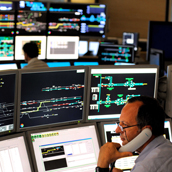
Alstom technologies for the new command and control systems at the Bologna Hub
24 May 2013
Alstom and RFI (Italian Rail Network) recently presented the technological interventions developed for the Bologna hub (the most important hub of the Italian network) to the international press. The first, in chronological order, active since 2009, is the ACC (computer based interlocking) system at Bologna Central Station, which makes it possible to control rail traffic amounting to approximately 1200 trains a day (passengers and freight) in total safety. Bologna Central hub is the first example in Europe of integrated railway operation management, covering all the various aspects from the circulation of trains, to passenger information, right up to the infrastructure. Alstom has used its own system, the Smartlock 300Z, the biggest signalling system the French company has ever built.
The second intervention concerns the design, construction, installation and maintenance of the signalling system made for the Bologna through line (a 16-km rail link between the Milan – Bologna high-speed line and the Bologna – Florence high-speed line) which uses a multi-station computer based interlocking system for high-speed lines and Level 2 ERTMS for controlling train traffic. This system also manages the interconnections with the conventional lines running to Padua and Venice. The solution adopted by Alstom is based on the Atlas 200 platform. The third intervention concerns the design and implementation of the SCC-M (Multi-station Circulation Command and Control System) for the Bologna hub, which makes it possible to manage the Bologna by-pass lines and the main lines running from Bologna to Verona, Rimini, Milan, Padua, Prato and Pistoia in total safety from the Central Control Office. The operator has at his disposal a brand new type of interface which in real time, even in the event of disruptions to rail traffic, provides all the necessary data for immediate intervention. The SIL4 certified system is developed on the ICONIS RW Centralized Traffic Control and Smartlock 300 interlocking platforms. All three systems are housed in a single control room in the new and ultra-modern building next door to Bologna Central Station which also accommodates the rail traffic control room for the Bologna – Milan and the Bologna – Florence high-speed lines.
Franco Tanel
(Photo courtesy of Alstom transport)
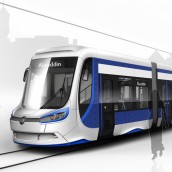
Škoda Transportation won a 104,7 million euro tender in Turkey
29 Mar 2013
Škoda Transportation won his first direct contract for supply of sixty 100% low-floor trams for the Turkish city of Konya. Pilsner rolling stock manufacturer offered better overall terms than other five companies: in particular Bombardier, Pesa, CAF, Astra Arad and CNR Tangshan Railway. The total contract value exceeds 104,7 million euro.
“We are happy that our products are successful on foreign markets. Škoda trams succeeded in Miskolc, Hungary; metro in St. Petersburg, Russia; double-deck EMU in Ukraine and locomotives are now running in the Slovak Republic,” says CEO of Škoda Transportation Josef Bernard.
Škoda Transportation’s offer in Turkey is based on new five-section vehicle which is also being supplied to Miskolc, Hungary. The Konya vehicles will be 100% low-floor, bidirectional and totally compatible with the up to date European standards. Škoda’s offer was the overall winner, including technical solutions, price and delivery schedule.
„Škoda’s win in this very competitive environment is another great step in confirming our strategy to expand internationally. We are very pleased for this win in Turkey, as Turkey is a dynamic and fast-growing market, with major investments in urban transportation, in many other big cities such as Bursa, Gaziantep, Izmir or Adana. Turkey is also a gateway to other Middle East countries,“ said Zal Shahbaz, senior Vice President for sales at Škoda Transportation.
Over million residents of Konya can now look forward to delivery of brand new trams, which will include Konya’s design colors and full air-conditioning for passengers’ & driver’s comfort. The seventh most populous city in Turkey lies in central Anatolia and once was the capital of vast empire of Seljuk Sultans of Anatolya which covered whole Anatolia, Armenia, Crimea and some parts of the Middle East. Nowadays Konya has a rapidly growing economy and plays an important role in Turkish economy. The city is known for the famous Mevlana museum and also for Whirling Dervishes and their dancing shows.
There is currently one 21 kilometers long line in Konya but there are plans for extension of the tram network. Municipality has now twenty older vehicles bought in early nineties from Cologne.
Škoda Transportation group is familiar with Turkish railway market. Škoda Electric supplies complete electric drives and wheel sets for eighty new locomotives. The contract is worth 80 million euro. In 2008 Škoda Electric also delivered electrical equipment for light rail vehicles for the Istanbul transport company.
Source: www.railwaygazette.com, 4 March 2013
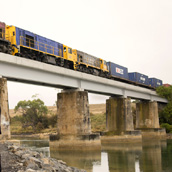
Rail renewal on track
29 Mar 2013
The revitalisation of Tasmania’s Rail Network continues to advance with the opening of the first of four major North West Rail Bridges to be officially opened today by the Premier of Tasmania, the Hon. Lara Giddings, MP and the Federal Member for Braddon, the Hon. Sid Sidebottom, MP.
The newly refurbished Don River Rail Bridge forms part of the Western Line, a strategic part of the State’s Rail Network connecting the Port of Burnie with the South Line and the Bell Bay Line. Built in 1886, the Don River Rail Bridge has been subject to the deteriorating effects of a windy, saline environment and an historically poor maintenance regime. Urgent repairs and upgrade works were required to ensure the safety, integrity and long-term future operation of this critical rail link.
Tasmanian Contracting Company VEC Civil Engineering Pty Ltd carried out the rehabilitation project over a four day rail closure period, commencing on 26 December, 2012.
TasRail Chief Executive Officer Damien White said the successful completion of the $3 million upgrade was noteworthy for a range of reasons including innovative engineering and work practices and the co-operation of customers, local government and the community.
“In just 84 hours, VEC’s construction crews completed some 103 individual tasks over seven continuous shifts”, Mr White said. “Works included the removal of the original wrought iron girders of riveted construction and timber ballasted deck; installation of new steel girders and concrete deck panels on the existing mass concrete piers and abutments”.
Mr White revealed that planning to support the works was months in the making and required contingencies to cover risk factors such as weather delays; prevention of worker fatigue and ensuring community safety related to recreational activities in and around the river.
The upgrade of the four North West Rail Bridges is a $24 million project funded by the Australian Government’s Nation Building Program. New rail bridges being built on the Leven and Forth Rivers are progressing to schedule. The recently completed new Blythe River Rail Bridge is fully operational. VEC Civil Engineering Pty Ltd successfully tendered for all four contracts.
Press release by Tasrail, 27 February 2013
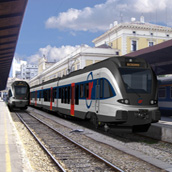
Stadler flirting in Serbia
29 Mar 2013
Serbian Railways (ŽS) has ordered 21 electric FLIRTs (Fast Light Innovative Regional Train) from Stadler Rail for commuter rail services in the Belgrade region. The contract worth around EUR 100 million was signed today in Belgrade. The order is being financed by the European Bank for Reconstruction and Development (EBRD) in London. The vehicles will be delivered in two-week intervals between autumn 2014 and late summer 2015. The trains are very environmentally friendly due to their low energy consumption.
Today, at the headquarters of ŽS in Belgrade, Dragoljub Simonović, Executive Director of ŽS, and Peter Jenelten, Executive Vice President Marketing & Sales at Stadler Rail, signed the contract for the procurement of the 21 new trains. The trains ordered are latest-generation fourcarriage FLIRTs. Based on the FLIRT, which has sold over 800 units over the last 10 years, Stadler has developed the next generation, FLIRT3. This latest range of trains is made up of various modular sub-ranges. Peter Jenelten is very pleased about the order: “We are proud that we were able to win this EBRD-financed invitation to tender. The new FLIRT trains will allow ŽS to set new standards in regional transport. And it is our first FLIRT order in South-Eastern Europe.”
Comfortable and environmentally friendly. The trains have an electric drive for a voltage of 25 kV, 50 Hz. The maximum speed of the modern trains is 160 km/h, and they can be used for three-way traction. The carriage areas can all be accessed without steps and have 234 seats, including 14 tip-up seats and 12 seats in 1st class. The FLIRTs incorporate spacious multifunctional compartments in the entrance area for wheelchairs, prams and bicycles, a wheelchair-accessible toilet and air-conditioning. Emergency intercoms allow passengers to contact the driver. The trains will initially have an Indusi train control system, with a subsequent upgrade to the European ETCS 2 standard included at the planning stage. The vehicles are made of lightweight aluminium and are therefore low in weight. This means they can accelerate faster, thus significantly reducing energy consumption and operating costs in comparison to conventional vehicles.
Each of the four bodies has one passenger door per side to meet the requirements of Serbian Railways. This highlights one of the real strengths of the FLIRT3 concept: the number of doors and various other features can be adapted variably to meet the customer’s requirements. The first units will be delivered in autumn 2014. Ten weeks after the delivery of the first vehicle, the remaining 20 trains will be delivered in two-week intervals. Thus, the last vehicle will arrive in late summer 2015.
Press release by Stadler, 4 March 2013
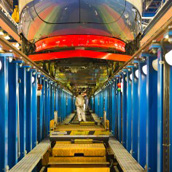
Knorr-Bremse and Federal Cargo Company FGK create new joint venture in Russia
29 Mar 2013
Federal Cargo Company FGK, a subsidiary of Russian Railways RZD, and Knorr-Bremse have established a joint venture in Russia by the name of Knorr-Bremse 1520. The new joint venture company is to manufacture rail vehicle brake technology products for use in Russia and other CIS states. The agreement between Knorr-Bremse and FGK was signed at a ceremony on the premises of the Russian company in Moscow. The name of the new company, Knorr-Bremse 1520, is derived from the Russian track gauge of 1520 millimeters. The joint venture is based in the city of Tver, roughly 170 kilometers north of Moscow. Knorr-Bremse 1520 began operations with the signing of the agreement, with manufacturing activities initially taking place at the existing Knorr-Bremse plant in Voronezh. Construction work on a new factory in Tver with almost 16,000 square meters of production space has already begun. In 2014 the joint venture will transfer its entire production operations to Tver, creating some 400 jobs at the new plant. The total investment in state-of-the-art production equipment runs to approximately EUR 26 million. Knorr-Bremse already commands an extensive product portfolio specifically geared to the needs of the CIS market and which from now on will increasingly be manufactured locally. In addition, the existing portfolio will be extended in the medium term to include further products that are also adapted to local requirements and will be manufactured in Tver. One new core product of the joint venture company will be control valves for the CIS market, destined for use in the various rail vehicles operating in the cargo sector. Another focus will be on the production of disc brakes and oil-free compressors. In the course of extensive development projects, Knorr-Bremse has designed and built these products to operate at temperatures as low as minus 60°C in line with the respective product applications and regional requirements.
“For Knorr-Bremse, this new joint venture offers numerous opportunities to win a more extensive share of the railway market in the CIS states,” says Dr. Dieter Wilhelm, Executive Board Member of Knorr-Bremse AG responsible for rail vehicle systems. “In the medium to long term there will be many new-building and modernization projects in this market. And operators are increasingly focusing on vehicle life cycle costs and component reliability as rail vehicle speeds rise.”
Speaking at the signing ceremony, Vitalij Evdokimenko, General Director of OAO FGK emphasized that “The joint venture will be the only company in the country to manufacture state-of-the-art braking systems for passenger coaches and cargo wagons, as well as for the latest generation of Russian multiple units. This is an important step in the context of Strategy 2030 that aims to modernize the railway industry in Russia.”
As a result of its long years of experience in the Russian and CIS markets, Knorr-Bremse can draw upon a deep pool of experience and expertise that the company will be able to translate into customer benefits in the course of future projects. Back in the 1960s the former main Knorr-Bremse plant in East Berlin supplied brake equipment for Soviet passenger coaches. Today, equipment from Knorr-Bremse can be found in service in Russian mainline passenger coaches, locomotives and multiple units. Russian high-speed trains, such as the Siemens Sapsan and the Alstom Allegro, are also equipped with reliable Knorr-Bremse braking and on-board systems. In addition, the almost nine million people who use the Moscow Metro each day all rely on proven technology from Knorr-Bremse. By establishing this joint venture, the Munich-based braking systems specialist is further strengthening its market position.
Press release Knorr-Bremse, 12 February 2013
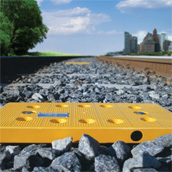
Bombardier Wins Further Order for ERTMS Technology in Poland
29 Mar 2013
Ongoing commercial installation of BOMBARDIER INTERFLO 450 European Rail Traffic Management System (ERTMS) Level 2 in Poland will boost pan-European transport.
Rail technology leader Bombardier Transportation will deliver its globally proven INTERFLO 450 ERTMS Level 2 solution for the Legnica-Wroclaw-Opole section of Poland’s E30 line. The contract is part of the modernisation programme of the pan-European transport corridors which will ensure interoperability on railway lines in Poland. Bombardier’s third ERTMS Level 2 project in Poland, the new contract is valued at approximately 35 million PLN (8 million euro, $11 million US).
The project, to be delivered in 26 months, will connect to the Legnica-Wegliniec-Bielawa Dolna section of the E30 line where Bombardier is already delivering the pilot implementation of ERTMS Level 2 in Poland. Bombardier ERTMS technology is also being implemented for commercial operation on the Warsaw-Gdynia section of the E65 line.
Maciej Dutkiewicz, spokesperson for the Investment Implementation Centre of PKP Polskie Linie Kolejowe S.A., said: “The signing of the contract for the installation of this ERTMS system on the Legnica-WrocÅ‚aw-Opole route is an important step towards building a high-tech railway network of European standard in Poland.”
Peter Cedervall, President Rail Control Solutions, Bombardier Transportation, added: “This latest contract reflects the strength of our globally-proven ERTMS solution and our project delivery experience in Poland. Through the growing number of contracts, our innovative technology will offer faster and more efficient interconnected mobility through Poland and across Europe.”
Bombardier is a leader in the development of ERTMS/ETCS technology, with solutions operating or being delivered on more than 2,500 vehicles and 15,000 km of track in 16 countries. The
INTERFLO 450 Level 2 solution has been running on the highest speed lines in China since 2009. It has permission for commercial operation on the Amsterdam-Utrecht line in the Netherlands, one of the busiest mainlines in Europe, and was inaugurated on Sweden’s first high speed ERTMS Level 2 line, the Botnia line, in 2010.
Bombardier ERTMS technology is also installed in Croatia, Korea, Switzerland, Spain and Taiwan and first-in-market projects are being delivered in Algeria and Poland, in addition to extensive framework agreements in Sweden and Norway. Bombardier is also at the heart of innovation, having delivered the world’s first ERTMS Regional system, its INTERFLO 550 solution, on the Västerdal Line in Sweden.
The future success of urban centres rests on re-defining the way people move within and between these expanding social and economic hubs. Bombardier’s portfolio of rail control solutions reduces the constraints of current networks. It covers the whole range of BOMBARDIER CITYFLO mass transit solutions, from manual to fully automatic, as well as communications-based systems. It also provides INTERFLO mainline solutions, from conventional to ERTMS Level 2 systems a complete palette of wayside and onboard signalling products.
Bombardier Transportation (ZWUS) Polska Sp. z o.o. is a wholly-owned Bombardier company based in Katowice, Poland. With almost 90 years of experience in providing the latest signalling technology to the Polish rail network, the IRIS certified BT ZWUS has a unique understanding of the market.
Its500 employees design and manufacture a full range of rail control signalling equipment for mainline, mass transit and industrial applications that have been delivered in Poland and worldwide.
Press release by Bombardier, 15 February 15 2013
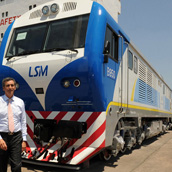
First CSR cars arrive in Buenos Aires
29 Mar 2013
An initial batch of 41 coaches built by CSR of China for the San Martín commuter route was unloaded in Buenos Aires on February 28. The shipment also included a further two CSR Qishuyan diesel locomotives for the San Martín route.
Minister of the Interior & Transport Florencio Randazzo said that deliveries of the 160 coaches and 24 locomotives that CSR is supplying would be completed within ‘90 or 120 days’. The new San Martín fleet represented a US$133m investment by the federal government, he said, of which 15% had been paid in advance. The balance was to be provided over a 10-year term at an interest rate of 7⋅5%, including a two-year grace period.
Randazzo added that the 25 nine-car EMUs that CSR Sifang is building for the Sarmiento route and the 30 six-car EMUs for the Mitre network were expected to arrive within 13 months. ‘We are going to replace all the old trainsets and double capacity’, he said. In the meantime, deployment of the new high-platform San Martín cars on Mitre route was under consideration to replace the ‘worn out’ Mitre fleet.
The federal government has also acquired passenger rolling stock for the medium-distance routes from Buenos Aires to Rosario and Mar del Plata. ‘We are now tendering the track renewal works’, said Randazzo.
Source: www.railwaygazette.com, 06 March 2013

Invensys Rail awarded GNGE Signalling Contract by Network Rail
29 Mar 2013
Invensys Rail has been awarded a £57.8 million signalling contract by Network Rail for the Great Northern Great Eastern (GNGE) upgrade project.
The 16 month programme, which is an integral part of the East Coast Main Line Capacity Relief Project, will see a significant upgrade to the existing line between Doncaster and Peterborough that will be used as the primary day time route for freight traffic.
The scope of Invensys Rail’s contract includes all elements of design, testing, installation and commissioning for the re-signalling of 86 miles of track, including 45 level crossings, the demolition and removal of 24 signal boxes (including Level Crossing Gateboxes) and the replacement of seven interlockings.
The first of five major phase commissionings is scheduled to take place in August 2013, with the final commissioning planned for March 2014.
Press release by Invensys Rail, 22 January 2013

Alstom to provide 34 light rail vehicles and maintenance services for Ottawa
29 Mar 2013
Alstom finalised a contract to provide 34 light rail vehicles and 30 years of maintenance services to the Rideau Transit Group (RTG) consortium(1) that was selected to design, build, finance, and maintain the first line of the Ottawa Light Rapid Transit (OLRT) system worth over €1.5 billion (2.1 billion Canadian dollars). Alstom’s portion of the contract is worth approximately €400 million.
The new Citadis Spirit that Alstom is launching in the North American market will have many features that accommodate Ottawa’s particular needs. Designed in a high capacity version, it will be able to operate in extreme winter conditions. It will also benefit from a top speed of 100 km/hour (65 mph), reducing travel time between suburban areas and the City Center. As all Alstom trams, it will have a full low-floor accessibility and onboard bicycle storage. Alstom will build the vehicles in America and assemble them in Ottawa.
Ottawa will rely on its state-of-the-art 12.5 kilometre Light Rapid Transit system which will provide service to the downtown area via 13 stations and a 2.5 kilometre tunnel. Construction of the project will start in the next few months and the system is expected to enter full service in spring of 2018.
“This project marks the successful entry of Alstom into the North American Light Rail Vehicle market. Alstom will bring its experience as the market leader in tramways. The Alstom Citadis Spirit light rail vehicle is very flexible and can be adapted to the needs of other cities across North America.” said Guillaume Mehlman, Alstom Transport North American President.
Alstom has produced 1,600 Citadis tramways for 40 cities all around the world. They transported 4.8 billion travellers (2 million per day) and ran over 400 million kilometres. Alstom’s Citadis-Dualis tram-train – with a configuration similar to that of Ottawa – has been operating for nearly two years in the Nantes suburbs and more recently in the city of Lyon at a speed of up to 100 km/h. In addition, the company has proven experience developing public private partnerships that enable local communities to finance such projects in a fiscally efficient and competitive manner.
Taken together, these proven capabilities—combined with the company’s extensive manufacturing and service footprint in North America—put Alstom in an ideal position to deliver efficient, modern and proven solutions to communities pursuing light rail transit projects.
1 – Led by ACS Infrastructure Canada Inc., and includes SNC-Lavalin, ACS, Ellisdon and other companies with transit and construction experience in Canada and across the world.
Press release of Alstom, 13 February 2013
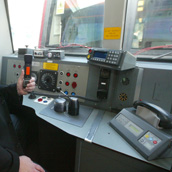
Siemens to equip Danish rail fleet with digital radio technology
29 Mar 2013
Siemens has been commissioned by Danish railway infrastructure operator Banedanmark to equip 840 rail vehicles with GSM-R (Global System for Mobile Communication Railways) technology. “The digital mobile radio system GSM-R has established itself as the international standard for on-board communication and is one of the key components of the Danish railway network’s cross-border traffic to Germany and Sweden,” said Juergen Brandes, CEO of the Siemens Rail Automation Business Unit. The vehicles will be duly equipped by the beginning of 2015. The order volume is worth around 20 million euros.
The GSM-R solution from Siemens enables the continuous transmission of movement authorities between control centers and trains on the rail network. Equipping trains with the international mobile radio standard GSM-R is one of the prerequisites for enabling railway personnel to communicate across national borders. The operation of analog, national systems will be phased out. The contract also includes training of the customer’s personnel in the use of the new technology. The components will be manufactured at the Siemens factory in Poole in the UK. The modernization of rolling stock with GSM-R radio devices is part of a Danish government program to renew the nation’s entire railway signaling infrastructure by 2020, with the aim of increasing the capacity and reliability of overall railway operations. This is the largest and most comprehensive modernization project of its kind ever to be undertaken in Europe, for which a total of 3.2 billion euros has been made available.
Banedanmark previously commissioned Siemens in 2011 to equip the 170-kilometer-long, dual-track S-train line network in Copenhagen with an automatic train control system. The network uses Semi-Automated Train Operation (STO), which allows trains to run independently in fixed line sections at dynamicallyoptimized intervals, i.e. according to the moving block system. Large parts of the network are operated automatically and without lineside signals, but still call for driver involvement. This has made it possible to reduce train headways from 120 seconds to 90 seconds within the inner-city area.
Press release by Siemens, 24 January 2013
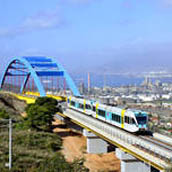
Neo Ikonio freight line inaugurated
29 Mar 2013
A 17 km freight line connecting the Neo Ikonio container port near Piraeus with Thriasio on the Athens – Kiato route was inaugurated on February 28.
The project was announced in 2000 but subsequently delayed by two years due to financial problems. The total cost was €156⋅6m, split equally between national sources and EU cohesion funding. Aktor was responsible for the civil works, J&P Avax for railway systems and Alstom Transport for signalling.
The alignment is designed for 90 km/h operation, is fully fenced and has no level crossings. There are 10 bridges with total length of 1 400 m, seven tunnels totalling 7 000 m and two cut-and-cover sections totalling 800 m.
Hewlett-Packard has reached an agreement with port operator COSCO and national passenger and freight operator Trainose under which 16 000 to 20 000 containers a year could be moved through the port to destinations in central and eastern Europe. There will be an initial two trains a week to the Czech Republic, and the government expects similar agreements to be reached with other major companies. The government is hoping to sell 100% of Trainose to the private sector in June.
Source: www.railway gazette.com, 06 March 2013
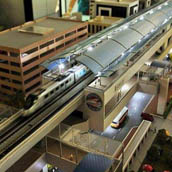
Mott MacDonald to design Hyderabad metro stations in India
29 Mar 2013
UK-based engineering firm Mott MacDonald has won a contract from Larsen and Toubro (L&T) to design six stations for the Hyderabad Metro Rail project in the Indian state of Andhra Pradesh.
The Rs164bn ($3bn) three-line metro rail network will cover a distance of 71.16km and serve 66 stations.
The deal will see Mott MacDonald offer architectural, structural and public health design services for three interchange stations located in the city at Ameerpet, Parade Grounds and the Mahatma Gandhi Bus Station, and design three more stations at Panjagutta, Hi-Tech City and Jubilee Hills Checkpost.
Mott MacDonald said that it will use building information modelling (BIM) to provide better solutions, faster project delivery, improved sustainability and performance.
Mott MacDonald project director Karthikeyan Ramalingam spoke of the company’s involvement in metro projects that are being implemented in seven Indian cities.
“Mass Rapid Transit System has become a key area for infrastructure development in the major cities of India,” Ramalingam said.
“Our appointment builds upon our existing work for Larsen and Toubro as detailed design consultants on the Chennai Metro Rail project,” Ramalingam added.
Construction work for the entire network is expected to be completed in phases from late 2014 to 2017; the finalised metro is expected to carry about 1.5 million passengers a day.
The first section of the fully automatic rail network is expected to open by late 2014 or early 2015 and will be capable of carrying 60,000 passengers per hour at peak times.
Thales India secured a Rs7.4bn ($136m) contract from L&T in December 2012 to provide signalling and communications systems for the metro.
Thales is responsible for installing communications-based train control and integrated communications and supervision systems on the three lines of the Hyderabad metro.
In September 2012, South Korea’s Hyundai Rotem won an Rs18bn ($324m) to deliver 57 three-car trainsets for the metro project, and French firm Keolis secured a contract in May 2012 to operate and maintain the new metro system for eight years.
Source: www.railway-technology.com, 20 February 2013
Image: Mott MacDonald will provide architectural, structural and public health design services for Hyderabad metro’s six stations. Photo: courtesy of Keolis.
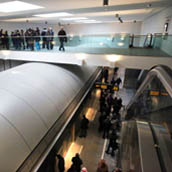
Brescia inaugurates new metro system with driverless technology by Ansaldo STS
29 Mar 2013
Safe, reliable, beautiful, and completely driverless. Brescia’s new metro system, which will be inaugurated by the mayor and the town council on 2 March 2013, is the brainchild of a large Italian partnership between Ansaldo STS (prime contractor) and AnsaldoBreda, two Finmeccanica companies, and Astaldi. The group has produced a technological gem inspired by the driverless underground system of Copenhagen, Denmark, which has been operational since 2002 with much success and passenger satisfaction.
Con 17 stazioni, di cui 8 in galleria, 5 in trincea, 2 a raso e 2 in viadotto sopraelevato, la metropolitana di Brescia rappresenta un prestigioso “biglietto da visita” della città, che potrà godere di un moderno sistema di trasporto, particolarmente curato anche nell’estetica: accoglienti, confortevoli, accessibili e sicure anche per i non deambulanti ed i non vedenti, le stazioni hanno dimensioni ridotte, percorsi interni brevi e diretti, illuminazione diffusa, moderni sistemi di comunicazione, informazione e telesorveglianza; quelle in galleria presentano una “continuità spaziale” dalla superficie esterna, ricca di lucernari, fino al piano di banchina, grazie all’eliminazione del tradizionale mezzanino. L’apporto di luce naturale proveniente dall’esterno, dà al passeggero in attesa la possibilità di percepire cielo e spazi aperti esterni rafforzando la percezione di sicurezza.
With 17 stations, of which eight are in deep tunnels, five in subsurface tunnels, two at ground level, and two in elevated viaducts, Brescia’s metro represents a prestigious calling card for the city, which will be able to benefit from a modern transport system, where even aesthetic details were carefully considered. The stations are cosy, comfortable, accessible and safe for all passengers, including wheelchair users and the visually impaired; moreover, they are small, with short and direct internal passageways; well lit, and equipped with modern communication, information and video surveillance systems. Deep-tunnel stations will have “spatial continuity” with the outside, with plenty of skylights up to the platform, thanks to the removal of the traditional mezzanine. The flow of natural light from the outside allows waiting passengers to see the sky and open space, thus reinforcing their perception of safety.
The first operational stretch of line, between the terminus stations of Prealpino and S.Eufemia Buffalora, is 13.7 km. Of these, 6 km. is in a deep tunnel excavated with a tunnel boring machine in the central part of the line, 4.7 km. in subsurface tunnels, 1.3km. at ground level and 1.7 km. in elevated viaducts. The line, which runs from the North, underpasses via Triumplina, then turns near the stadium toward Ospedali Civili; it then goes through the historical centre, where there is an interchange station with the railway network, and continues to Brescia 2, turning into via Lamarmora. It then passes through Poliambulanza, and crosses the areas of San Polo and Sanpolino until it reaches the depot.
Driverless systems are operated through a central system, the control room, which makes it possible to monitor train operations throughout the day, providing passengers with continuous assistance.
There are many benefits compared with more conventional metro systems: vehicles and infrastructure are smaller, with the resulting reduction in investment; reduced staff costs thanks to automation (no drivers or station staff); a more frequent service and much greater rescheduling flexibility; cumulative delays during the day are automatically made up for; the frequency of trains is scheduled on the basis of traffic requirements, with an increase during rush hours and a reduction when there are fewer passengers; and extremely high safety levels due to the elimination of human error.
Press release of Ansaldo STS, 2 March 2013
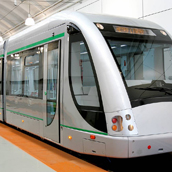
Two new contract awards to CAF in Brazil for the Belo Horizonte and Porto Alegre cities
22 Jan 2013
The FROTA BH consortium headed by CAF, has been the awarded with a contract to supply 10 trains, 4-car each, to CBTU (Companhia Brasileira de Trens Urbanos) for the Brazilian city Belo Horizonte, capital of the Minas Gerais state.
These are state-of-the-art EMUs that will run on 1600 mm track gauge with 3000 V power supply, for the Superintendency of Urban Trains of the city. The vehicle is bidirectional with a capacity of 1300 passengers, and provides easy access for Persons with Reduced Mobility and is able to run at service speeds of 90 km/h.
The Belo Horizonte city has a population of 2.3 million inhabitants and is one of the 12 host cities designated for the FIFA World Cup 2014, as well as a sub-host city for the Summer Olympic Games 2016.
In addition, CAF will also supply all the bogies of the 15 new trains, 4-cars each which are part of the procurement contract undertaken by the City of Porto Alegre, Capital of the Rio Grande do Sul state for TRENSURB (Empresa de Trens Urbanos de Porto Alegre).
The aggregate of both contracts amounts to a turnover in excess of €80 million for CAF. Both projects will be implemented at CAF’s plant in Brazil, in the Sao Paulo state, which has become one of the most modern railway stock plans in Latin-America.
With these two new contracts, CAF consolidates its leadership in this market and the expansion of the CAF Group into the various Brazilian states where the company has currently contracts for Sao Paulo, Recife and Cuiabá.
Press release of CAF, 19 November 2012

Ansaldo Honolulu JV signs contract for City of Honolulu’s driverless metro
22 Jan 2013
Consortium comprising Finmeccanica companies Ansaldo STS and AnsaldoBreda has signed a contract worth a total USD 1,334 million for Hawaii’s new metro line.
Ansaldo Honolulu Joint Venture, a consortium comprising Finmeccanica companies Ansaldo STS (STS.MI) and AnsaldoBreda, has signed a contract with HART (Honolulu Authority for Rapid Transportation) to supply the technology and vehicles for the new driverless metro line for the City of Honolulu (State of Hawaii).
The contract, worth a total of USD 1,334 million (net of Hawaiian GET tax), is for the design, construction, operation and maintenance of the new line for the city of Honolulu, which will be around 32 kilometres long and have 21 stations; Ansaldo STS’ share of the deal comes to USD 1,136 million and that of AnsaldoBreda to USD 198 million.
The design and construction work is scheduled to take eight years, with the first stretch of track being operated and maintained from 2015 onwards and the whole line from 2019 to 2029.
This is the tenth project for Ansaldo STS’ Transportation Solutions Unit based on the modern metro system with driverless trains and unmanned stations that operates in four Italian cities and six elsewhere in the world.
“Ansaldo STS is proud to have signed this important contract, whose value is the highest in our history. Our company has a proven tradition of delivering highly successful state-of-the-art rail systems around the world and we are fully ready to immediately get to work to honour our commitment” – Sergio De Luca, CEO of Ansaldo STS, stated.
Press Release of Ansaldo Honolulu, 29 november 2012. Image from Honolulu Rail transit Archive
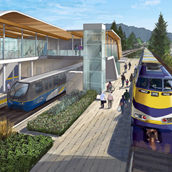
Bombardier to supply SkyTrain cars for Evergreen Line in Canada
22 Jan 2013
Bombardier Transportation has won a C$90.7m ($91.2m) contract from the Government of British Columbia (BC) in Canada and TransLink to deliver 28 SkyTrain cars for the new Evergreen Line and the existing Expo and Millennium lines.
The new SkyTrain cars will be operated by Vancouver’s transport authority TransLink on the Evergreen Line following its completion in 2016.
Canada-based SNC-Lavalin (SNC) won a C$1.4bn ($1.43bn) contract from the BC Government in October 2012 to design and build theEvergreen Line Rapid Transit project.
SNC-Lavalin is leading a team of companies for the project, including Graham Building Services, International Bridge Technologies, Jacobs Associates Canada, Rizzani de Eccher, S.E.L.I. Canada, SNC-Lavalin Constructors (Pacific), SNC-Lavalin Constructors (Western) and MMM Group.
The BC Government is providing C$583m ($594m) for the project, while the Canadian Government is contributing C$417m ($425m) and Translink C$400m ($408m).
The Evergreen Line project, which will be integrated into Vancouver’s SkyTrain system, will link the cities of Burnaby, Port Moody and Coquitlam with an 11km light rapid transit line.
The project will also include a two-kilometer bored tunnel, seven stations, power substations and parking facilities, train operating systems, vehicle storage and a light maintenance facility.
The new line will also provide a direct link to the Millennium Line, with connections to the Expo and Canada lines, West Coast Express and regional bus systems.
The new SkyTrain cars will be operated by Vancouver’s transport authority TransLink on the Evergreen Line following its completion in 2016.
Source: www.railway-technology.com, 5 December 2012. Image: Bombardier’s SkyTrain cars will be run by TransLink on the Evergreen Line that will connect the cities of Burnaby, Port Moody and Coquitlam.
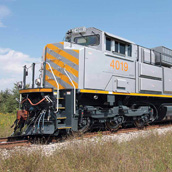
Etihad Rail’s First Batch of Rail Wagons Arrive at Mina Zayed
22 Jan 2013
A milestone in the development of Stage One of infrastructure project vital to the UAE Etihad Rail – the developer and operator of the UAE’s national railway network –announced today that the first shipment of wagons, to be used in Stage One of the rail project linking Shah and Habshan to Ruwais in the Western Region, arrived earlier this week at Abu Dhabi’s historic port, Mina Zayed, aboard the King Spirit. Senior delegates from Etihad Rail were on hand to receive and inspect the wagons upon arrival.
Commenting on the arrival of the King Spirit, H.E. Dr. Nasser Saif Al-Mansoori, CEO of Etihad Rail said, “the timely arrival of the wagons is yet another indicator of the rapid progress being made on this strategic national project. Construction activity for the first stage of the rail project, which is being developed in partnership with Abu Dhabi National Oil Company (ADNOC), is far along and we are on track to see the first trains run from Habshan to Ruwais within a year using these wagons. Etihad Rail’s wagons were carefully manufactured and designed based on several studies and integrated research efforts conducted in collaboration with Etihad Rail’s different suppliers, leading us to adopt some of the most advanced rail technologies available in the world. The rail project will change the face of transportation in the UAE, playing a significant role in building a sustainable economy by promoting growth in various business sectors, providing jobs for the local workforce, and contributing to environmental preservation, since one fully loaded train produces 70-80% less CO2 emissions than that of the trucks required to transport the same tonnage.”
Etihad Rail contracted China South Locomotive & Rolling Stock Corporation Limited (CSR) last year to supply 240 covered wagons for the transport of granulated sulphur in the Western Region of Abu Dhabi. Etihad Rail has also contracted United States-based Electro-Motive Diesel (EMD), one of the world’s largest builders of diesel-electric locomotives, to design and manufacture seven heavy haul freight locomotives.
The wagons were designed with the highest available safety standards to accommodate the core purpose of Stage One, the transport of granulated sulphur. For example, the wagons’ top-hatch covers for loading maintain the purity of the sulphur at 99.9%. Furthermore, train transport allows for a capacity of up to 22,000 tonnes of sulphur per day. It would take 360 trucks to transport the equivalent tonnage.
Mina Zayed, developed by Abu Dhabi Ports Company (ADPC) and managed and operated by Abu Dhabi Terminals (ADT), has already received other equipment necessary for the construction of Stage One, including one locomotive (to switch the wagons), and will continue to act as Etihad Rail’s gateway to vital suppliers from around the globe. Locomotives to be used in Stage One will be arriving in the UAE in Q1 of 2013.
Commenting on the arrival of the wagons, Martijn Van de Linde, CEO of Abu Dhabi Terminals, said, “Though the management and operation of Mina Zayed, Mussafah Port, Freeport and the recently inaugurated Khalifa Port, the region’s first semi-automatic port, ADT is playing a key role in supporting the development of Abu Dhabi’s strategic national infrastructure. ADT’s work to ensure that wagons and other equipment vital to the development of the Etihad Rail network, that arrive from around the world, are efficiently sent to where they are needed is a testimony to ADT’s commitment to working closely with other key organizations and entities sharing similar objectives related to contributing to Abu Dhabi’s Economic Vision 2030.
The recently inaugurated Khalifa Port, constructed by ADPC, will be linked to Etihad Rail’s network during Stage Two of Etihad Rail’s construction process. Linking Abu Dhabi’s ports with the Etihad Rail network will create a multi-modal transportation system that will contribute to Abu Dhabi Economic Vision 2030.
Tony Douglas, CEO, ADPC commented: “We congratulate Etihad Rail on the delivery of its wagons at Mina Zayed. We’re looking forward in particular to the company running its freight service to Khalifa Port from 2016. This will boost the port’s transport services and is a vital milestone for the megaproject Khalifa Port and Kizad”.
Construction on the 264 km route for Stage One of Etihad Rail, which links Shah and Habshan to Ruwais, is well under way. The tendering process is already in progress for Stage Two, which will connect the railway to Mussafah Port, to the UAE’s Khalifa Port and Jebel Ali Port and further to the Saudi and Omani borders, spanning 628 km.
Stage Three, at 279 km, will connect the rest of the Northern Emirates and will inaugurate Etihad Rail’s passenger service. Upon completion, the Etihad Rail network – which will cater to both freight and passengers – will extend approximately 1,200 km across the Emirates. It will connect urban and remote communities, facilitate trade, open up communication channels and foster economic development. The network will also form a vital part of the GCC Railway Network – linking the UAE to Saudi Arabia via Ghweifat in the west and Oman via Al Ain in the east.
Press release of Etihad Rail, 26 December 2012
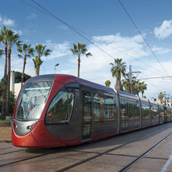
Inauguration of Casablanca’s first tram line in Morocco
22 Jan 2013
On 12 December, 2012, His Majesty the King of Morocco, Mohammed VI, inaugurated the Casablanca tramway. Attending the event were the Moroccan and French Prime Ministers, Abdelilah Benkirane and Jean-Marc Ayrault, Wali of the Casablanca Region, Mohamed Bousaid, Mayor of Casablanca, Mohamed Sajid as well as Casa Transports Managing Director, Youssef Draiss, RATP Chairman, Pierre Mongin, and Alstom Chairman and CEO, Patrick Kron.
In 2009, Casa Transports – a public company in charge of Casablanca’s public transport – awarded a contract to Alstom for the supply of 74 Citadis trams. In 2010, Casa Transports awarded Alstom two additional contracts for the installation of the line’s rail signalling and power supply systems.
This 31-km line, the longest line ever to be built in one project, links Casablanca’s East and South-West districts via the city centre, and calls at 48 stations. The Citadis trams are 65 metre-long double units and can accommodate up to 606 passengers. They will carry up to 250,000 passengers daily. With its 12 side doors and its full low-floor concept, the Casablanca Citadis will provide easy access for everyone and make for a smooth flow of passengers. The design of Citadis was customised in order to achieve perfect integration into Casablanca’s architecture. Its modern exterior appearance features a harmonious, rounded shape end-to-end. Its metallic orange colour provides a contrast to the city’s brightness. The interior features Moroccan style motifs and colours. The air-conditioning, large tinted bay windows, wide aisles and information displays in French and Arabic were designed to provide optimal travel conditions.
Service will be provided from 5:30 a.m. to 11:30 p.m. at intervals of 4 minutes 45 seconds during peak hours and 8 minutes 30 seconds during off-peak hours. The planned transit time for the line running from Ennassim to Facultés is 63 minutes 30 seconds, and 69 minutes from Ennassim to Hay Hassani. Once technical adjustments are completed, traffic signals ensured and full compliance of the tram platform guaranteed, the average speed will reach 18.8 km per hour with a 75% priority rate at intersections.
The signalling system supplied and installed by Alstom ensures safety at line intersections. It also manages road crossings and gives the tramway priority, for a higher speed and greater safety.
Casa Tram, a group headed by RATP Dev in partnership with the Moroccan Deposit and Management Fund (Caisse de Dépôt et de Gestion) and the holding company, Transinvest, is responsible for operating and maintaining the line for a period of five years. Casa Tram outsourced the contract to Alstom in July 2012 for maintenance of the fleet and infrastructure.
Forty or so Alstom employees will carry out preventive and corrective maintenance operations on the trams on a day-to-day basis, as well as performing their interior and exterior cleaning at a brand new 13,800-m² facility located in Casablanca.
RATP Dev has drawn up the timetable and operating procedures, regulations and maintenance policy. It has carried out all the technical operating tests and managed the installation of fixed equipment, energy supply equipment, signalling systems and rolling stock.
Traffic management will be provided by the Central Command Post (PCC) located in Sidi Moumen at the eastern end of the line. This seven-hectare operations and maintenance centre is one of the largest in the world.
Casablanca’s Citadis tramways were manufactured and assembled in France at the Reichshoffen plant. Other facilities involved in the project were La Rochelle (engineering), Le Creusot (bogies), Ornans (motors), Villeurbanne (onboard electronics) and Tarbes (traction system).
To date, 1,600 Citadis tramways have been ordered by 40 cities worldwide. In all, Citadis has run over 400 million kilometres and carried about 4.8 billion travellers (2 million per day).
Press Release of Alstom, 12 december 2012
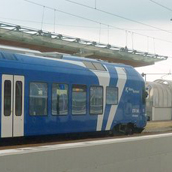
First FLIRT trains for Estonia officially presented by Elektriraudtee and Stadler
22 Jan 2013
Estonian passenger transport operator Elektriraudtee AS and Swiss rolling stock manufacturer Stadler Bussnang AG celebrated the official roll-in of the first electric and diesel FLIRT trains to Estonia today. The roll in ceremony took place in the depot of the railway company in Tallinn, where Mr. Juhan Parts, Minister of Economic Affairs and Communications, Ms. Kaida Kauler, Chairman of Elektriraudtee, and Mr. Peter Jenelten, Executive Vice President of Stadler Rail Group presented the first vehicles to the public. The delivery of the trains is part of the tender that Elektriraudtee closed successfully in 2010, within the frames of which Stadler will hand over 18 electric and 20 diesel multiple units to Elektriraudtee until the summer of 2014.
“This two trains are the first ones of our park, which would allow Elektriraudtee to make travelling by train a backbone of the Estonian public transportation system,” Chairman of Elektriraudtee Kaida Kauler said.
“It is a very unique opportunity for a railway producer to take part in the renewal of the whole train fleet of a railway operator. We are very proud to be part of it, and we very happily present today the first trains to the public. The FLIRT is Stadler’s bestseller train, which due to this contract will be available now in diesel type too”, added Peter Jelenten, Executive Vice President of Stadler Rail Group.
Elektriraudtee issued the public procurement back in 2009 separately for the purchase of 18 electric (EMU) and 20 diesel (DMU) multiple units. The procurement ended successfully with the victory of Stadler, the contracts were signed in August 2010. The value of the contract for the purchase of electric trains is around EUR 80 m, out of which 85% is financed from the cohesion fund of the European Union. The purchase of diesel units trains is valued at EUR 96 m, and is financed by a capital lease. According to the terms of the agreement, the Swiss producer will have to hand over the first train for operations by June 2013, by which time the train will also have to receive the homologation that is required to enter commercial service. In order to obtain this, the trains are to be tested by the Estonian Technical Surveillance Authority, in cooperation with Elektriraudtee and Stadler.
Elektriraudtee plans to launch regular service with passengers on 28 June 2013, right after the final homologation of the vehicles. The last EMU is expected to be handed over by January, while the last DMU by June 2014. Diesel passenger service operations will be launched on the 1st of January 2014.
Elektriraudtee ordered altogether 12 three-car and 6 four-car EMUs, as well as 6 two-car, 8 three-car and 6 four-car DMUs from Stadler. The broad gauge (1520 mm) trains have been designed and manufactured to easily endure the harsh weather conditions typical in Estonia, which expertise Stadler gained through its earlier deliveries to Finland and Norway.
Due to the lightweight aluminium structure and the modern energy saving system, the new trains will also mean a great cost-saving for the operator Elektriraudtee. The vehicles will be able to transform the accumulated energy deriving from braking, and recuperate it back to the electricity network through the overhead cables. The electric trains will have a top speed of 160 km/h, coupled with an accelerating ability of 1.2 m/s2, which is a remarkable value in this train segment. The diesel trains will also have outstanding accelerating abilities with a top speed of 160 km/h as well. The high top speed and the admirable accelerating make the drivers capable to catch up even significant leeways between two stops.
The driver’s cabin received an ergonomic and modern design, which significantly improves the current working conditions of the drivers, and thanks to modern control system, the safe control of the trains is possible with a staff of only one person. The passengers will also observe a great improvement in comfort, as all trains will be equipped with a state-of-the art information system, air-condition, free wireless internet, power plugs for the charging of notebooks or cell phones, video surveillance and multipurpose areas appropriate for the transport of wheelchairs, baby trolleys or bicycles. Free and fast passenger flow will be secured by the wide doors available on each side.
Press Release of Stadler, 13 december 2012.
Image courtesy of Luca Fascia “(C) riproduzione vietata/all rights reserved”
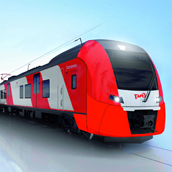
Siemens signs agreements with Russian partners on various infrastructure projects
22 Jan 2013
During the 14th round of the Russian-German intergovernmental consultations in the presence of Mr. Vladimir Putin, President of Russia, and Ms. Angela Merkel, Chancellor of the Federal Republic of Germany, Siemens signed a number of agreements with Russian partners. “Russia is a very important market for Siemens. With a comprehensive portfolio of innovative and ecofriendly technologies, we’re a reliable partner for the modernization of the country’s infrastructure,” said Peter Löscher, President and CEO of Siemens AG.
Russian Railways, the Sinara Group and Siemens agreed to increase the production volumes of new-generation electric locomotives manufactured by LLC Ural Locomotives, a joint venture of Sinara and Siemens. Based on its positive experience of operating the new generation electric locomotives ‘Granit 2ES10’, Russian Railways expressed its intention of buying 675 two-section cargo electric locomotives in the period from 2016 to 2020.
Siemens also signed a cooperation agreement with the Federal Grid Company (JSC FGC UES) for the joint development of modern facilities for mass producing high-voltage equipment. The partners agreed on the basic cooperation principles for the long-term delivery of 110 kV and 220 kV power transformer equipment. The parties also documented the intention to reserve production capacities of Siemens Transformers LLC for the requirements of JSC FGC UES in the volume of 3000 MVA for 2013 and 5000 MVA per year for the period 2014-2017.
Furthermore, Siemens has signed a memorandum with the mechanical engineering company Uralvagonzavod that establishes a framework for cooperation during the implementation of the product lifecycle concept at Uralvagonzavod. The parties will pursue a joint program involving the modernization of production and implementation of new software solutions by Siemens for product lifecycle management (PLM). In the area of business process modernization, the memorandum stipulates implementation of an integrated package of Siemens products with technical and information support provided by Siemens which will enable the end-to-end manageability of Uralvagonzavod’s product development processes.
Press Release of Siemens, 16 November 2012
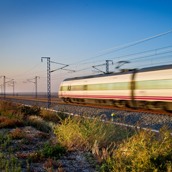
Ansaldo STS awarded EUR 82 million contract to implement High Speed/High Capacity Treviglio – Brescia railway line
22 Jan 2013
Ansaldo STS (STS.MI), a Finmeccanica Company, in quality of consortium partner of Consorzio Saturno, has received by the Italian Railway Network (RFI) the assignment to carry out part of the technological works on the High-Speed / High-Capacity railway line under construction, between the stations of Treviglio and Brescia.
The total amount of the works entrusted to Ansaldo STS equals EUR 82 million, on a total of EUR 176 million for the Consorzio.
Among the works entrusted to the Consorzio, Ansaldo STS has the duty of designing, building, installing and putting into service the signalling (level 2 ERTMS/ETCS and Multi-station) and automation installations (High-Speed SCC) on a 57-km-long railway line.
Furthermore, Ansaldo STS is directly responsible for designing, building, installing and putting into service the electrical substations, parallel positions and some data management installations for the electrical traction and for air-conditioning. Finally, they’ll take care of the air-conditioning, ventilation and heating installations for the new technological buildings.
After recently winning the tender for the Brescia Central station’s computer-based interlocking system (ACC), Ansaldo STS will carry out, through this contract, all the main works entrusted by the Italian Railway Network in the area of the railway reorganisation on the Turin-Padua main transversal railway line, which is part of the D interoperable corridor, defined as a priority by the European Community.
Press Release of Ansaldo STS, 2 January 2013
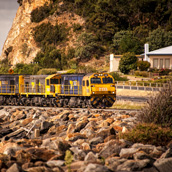
New era for rail a step closer
29 Nov 2012
A safer, modern and more efficient freight rail service moved closer to fruition today, with TasRail entering into a new contract for the supply and delivery of a new wagon fleet.
TasRail Chief Executive, Damien White revealed that the contract with CNR Australia Pty Ltd, provides for the supply and delivery of 36 new ore wagons, 17 new coal wagons, 18 new cement wagons and 120 new intermodal wagons (for containerised freight). Chinese-owned CNR- Australia Pty Ltd is a well established supplier of wagons to the Australian Rail Industry. It was awarded the contract following an exhaustive tender process that began six months ago. While the actual value of the contract value remains a matter of commercial-inconfidence, Mr. White revealed that it was substantially less than $20 million. The first of the new wagons are expected to arrive from mid 2013. “This is a great outcome for TasRail’s customers and further evidence of the resurgence of freight rail in Tasmania”, Mr White said. “With the first of our 17 new locomotives expected to start arriving late next year, combined with the significant and steady improvement in the safety and reliability of operations, TasRail can now start to shift its primary focus away from the Rail Recovery phase to pursue its strategy to grow the business”.
“More freight on rail means less trucks on Tasmanian roads and less greenhouse gas emissions”, he said. Although delighted that TasRail has been able to achieve the replacement of its current life expired wagon fleet within its budget, Mr White said the Company is disappointed that it had not been possible to achieve a competitive, local supply option. “Early in the procurement process and prior to the Tender being issued in April this year, TasRail worked with the Department of Economic Development and the Industry Capability Network, to ensure that potentially interested local suppliers were well briefed”, Mr. White said. “TasRail worked to ensure that local companies had maximum opportunity to prepare a tender submission, and this early engagement included TasRail hosting site visits to its operations, one-on-one briefings and inspections of the current wagon fleet”. Mr. White confirmed that two Tasmanian Companies had initially submitted wagon tender submissions, with one being shortlisted. However, that offering had proven to be more expensive across all four wagon types. “As much as possible, TasRail endeavors to utilize local resources, but balanced against its obligation to prudently invest the finite capital funds available to it for the replacement of Above Rail assets”, he said. “The reality is that TasRail has been given a once-in-a-generation opportunity to replace its aged rollingstock fleet. Accepting the higher priced proposal would have compromised the Company’s ability to purchase the required number of wagons to meet customer needs”, Mr. White said. TasRail inherited a fleet of 378 wagons when it was established in December 2009. The 40 year old fleet is of seven different classes and three different capacities. Its life expired condition and limited interoperability creates customer service issues, increased track wear and increasingly higher maintenance costs. TasRail is confident that the new wagon fleet will be substantially more efficient, resulting in improved operating performance, increased capacity, service reliability and quality. “With a new locomotive and wagon fleet, and a vastly improved track condition, TasRail will be well placed to provide Tasmanian business and industry a vibrant, customer-responsive and sustainable freight transport alternative”, Mr. White said.
Press release of Tasrail, 24 October 2012
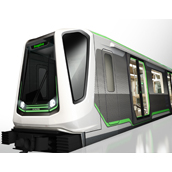
Siemens wins major order in Kuala Lumpur for driverless metro trains and depots
29 Nov 2012
Siemens is supplying the Malaysian capital Kuala Lumpur with 58 driverless metro trains. The customer Mass Rapid Transit Corporation Sdn Bhd (MRT Corp) has also ordered the complete equipment for two new depots. The total value of the consortium agreement is some 450 million euros, with Siemens accounting for some 260 million euros. “We have been able to win through in the extremely tough Asian market with our new Metro Inspiro. This is clear evidence of the competitiveness of Siemens in the urban transportation business,” commented Jochen Eickholt, CEO of the Siemens Rail Systems Division.
The Inspiro trains from Siemens are to be deployed on Kuala Lumpur’s new line which will connect the suburbs of Sungai Buloh in the north west and Kajang in the south east with Kuala Lumpur (SBK Line) from December 2016. The SBK Line is the first part of a comprehensive infrastructure plan to reduce the traffic congestion and environmental pollution in the Kuala Lumpur metropolitan area. MRT Corp is a private corporation fully owned by the Minister of Finance Inc, and will act as owner and developer of the metrosytems. More than 100 kilometers of new metro tracks are scheduled by 2020, linking the center of this megacity with its outlying districts. Construction of this 51 kilometer stretch of the SBK Line with its 31 stations is the first and largest part of this development scheme. The alignment of two other lines are currently being studied by Malaysian authorities, but is widely expected to be announced by the middle of 2013. The Kuala Lumpur conurbation is one of the rapidly growing metropolises in Asia that are affected by the enormous density of individual motorized transport and the consequent environmental impact. This state mass transit project, currently the largest in Southeast Asia, is intended not only to give another boost to the Malaysian capital but also to increase the attractiveness of the metropolitan region.
“The vehicles for Kuala Lumpur are based on the new Inspiro metro platform, for which we have already received a significant order from Warsaw. We want to produce a total of 58 four-car trains, designed for fully driverless operation, in conjunction with a local partner company in Malaysia,” explained Sandra Gott-Karlbauer, CEO of Urban Transport at Siemens. The engineering and major components, such as the drive system and bogies, are being supplied from Germany and Austria.
Press release of Siemens, 17 October 2012
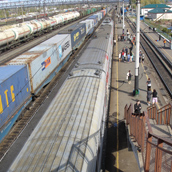
First container train dispatched from China to Europe
29 Nov 2012
Russian Railways Logistics (RZDL), together with YuXinOu (Chongqing) Logistics, has dispatched its first container train from China to Europe using the CIM/SMGS Common Consignment Note.
The train left Chongqing in China for Poland and Germany carrying 42 forty-foot containers for customers including Acer, ASUS and others.
Kazakhstan’s Kaztransservice and Belarus-based firm Belintertrans have coordinated with RZDL in the forwarding project.
Russian Railways Logistics CEO Pavel Sokolov said that the introduction of CIM/SMGS Common Consignment Note is a result of work that has taken two years.
“Shippers save transit time due to container demurrage decrease at the border stations,” Sokolov said.
The CIM/SMGS Common Consignment Note reduces extra costs on freight forwarding to shippers, who are usually charged for re-issuing the CIM consignment note in place of the SMGS note for each shipment at border stations.
According to RZDL, the common consignment note is a customs document provided in paper and electronic form based on the EU requirement concerning the previous authorization.
RZDL is also working to accelerate traffic through the breaks of gauge at Dostyk Station in Kazakhstan and Malaszewicze in Poland.
The development of the Chongqing – Duisburg corridor will help speed-up the process by two days and further expand the potential client base along the route.
RZDL owns a 16.3% stake in the joint venture Chongqing Logistics, which was founded by the Transport Holding Chongqing (CQCT), China Railway International Multimodal Transport (CRIMT), JSC Russian Railways Logistics, Schenker China and JSC Kaztransservice.
Source: www.railway-technology.com, 6 November 2012
Photo: Agryz town, Republic of Tatarstan, Russia. Train station. Main view at the area and trains. By: Александр Корчик
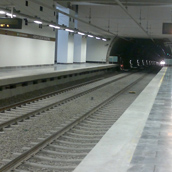
Mexico City’s Gold metro line opens
29 Nov 2012
President Felipe Calderón attended the opening of Mexico City metro Line 12, the Gold Line, on October 30, saying it ‘rivals the best in the world’. Travel is free until November 4.
Line 12 runs for 25 km from Mixcoac on Line 7 to Tláhuac in the southeast, an area of the city not previously served by the metro. There are 20 stations including interchanges with lines 2, 3 and 8.
Total cost of the project was 24·5bn pesos. The federal government provided 7·5bn pesos, alongside 5·7bn in local contributions.
Civil works were undertaken by ICA and Carso, with construction launched in September 2008. The line was originally to run entirely underground, but this was later modified. The western section runs through a 7·7 km tunnel bored using a 10·2 m diameter Robbins earth pressure balance TBM, while the eastern section is elevated.
Alstom was turnkey contractor for 1·5 kV DC overhead electrification, signalling and control systems, including Urbalis CBTC providing ATO.
CAF supplied 30 seven-car Type FE-10 steel-wheel trainsets under a contract awarded in December 2009.
The end-to-end journey time is 45 min, compared with up to 2 h by road. The Gold Line is expected to lead to a reduction in car and bus traffic, cutting CO2 emissions by 21 700 tonnes/year and helping improve air quality in Mexico City. Grütter Consulting assisted the city with an application for clean development registration for project, enabling credits to be sold to other countries seeking to meet their emissions reduction targets.
Source: www.railwaygazette.com, 31 October 2012
Photo: Interior de la estación Hospital 20 de Noviembre, Línea 12 del Metro de la Ciudad de México, andén dirección Tláhuac. By Oscar Gabriel Campos Villalobos
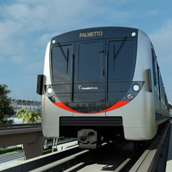
AnsaldoBreda wins Miami Metrorail train contract
29 Nov 2012
Miami-Dade County Commissioners gave Miami-Dade Transit the formal go-ahead on November 8 to award AnsaldoBreda a $300m contract to supply a fleet of metro cars to replace the current Budd stock on the Metrorail network.
The air-conditioned coaches are to have ‘an elegant exterior and interior design’, with bicycle racks, wi-fi, LED lighting, CCTV, and digital information and advertising displays.
Six prototype cars are scheduled to be delivered in 2015, with 130 series cars following over two years. Components are to be produced at AnsaldoBreda’s Italian facilities, with assembly to be undertaken at a new plant which the company is to build in Miami-Dade county. The contact includes the provision of spare parts, staff training and a simulator.
The order is being funded using $313·8m from transit system sales surtax revenue bonds. AnsaldoBreda’s bid came in almost $5m less than the nearest competitor.
‘This further success for AnsaldoBreda shows how our worldwide re-positioning program is achieving the expected results’, said AnsaldoBreda CEO Maurizio Manfellotto. ‘We are increasingly able to offer innovative products both in terms of technology and quality, maintaining a high level of competitiveness. On this occasion we have taken the lead over our French and Spanish qualified competitors in the US market where we have been present for many years.’
Source: www.railwaygazette.com, 9 November 2012
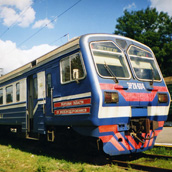
RZD to spend $US 2.7bn on new locomotives in 2013
29 Nov 2012
RUSSIAN Railways (RZD) will step up its fleet modernisation programme next year by spending a record Roubles 85bn ($US 2.7bn) on new locomotives, transport minister Mr Maksim Sokolov confirmed on November 8.
Sokolov told a cabinet meeting that RZD will acquire 770 locomotives, which is the “the most Russia can produce in a single year.”
According to the Moscow Times, industry and trade minister Mr Denis Manturov said that most of the locomotives will be supplied by Transmashholding, which is 25 per cent-owned by Alstom.
RZD aims to achieve a 15% improvement in locomotive productivity by 2015 and has ordered around 400 new locomotives this year as part of a drive to reduce the average age of the fleet. More than 70% of RZD’s electric locomotives, and more than 80% of its diesels, are considered life-expired.
The Russian government’s Rail Transport Development Strategy calls for an investment of €27.5bn in new locomotives between 2010 and 2030.
Source: www.railjournal.com, 9 November 2013
Photo: Electric multiple train unit ER2K-604 of Russian railways, by Volkov Vitaly
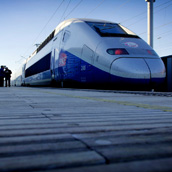
Alstom secures Turkish high-speed train maintenance contract
29 Nov 2012
Alstom has signed a contract worth around €22.3 million with Turkish State Railways (TCDD) to provide 2-year maintenance services on 12 high speed trains. In commercial operation since 2009, the trains operate between Ankara and Eskisehir (245 km), as well as between Ankara and Konya (310 km). The high speed trains are expected to cover 10 million kilometers in the two years of the contract. The maintenance will be carried out at TCDD’s maintenance depot in Ankara.
The contract scope includes preventative and corrective maintenance, daily visits as well as daily interior and exterior cleaning. It also includes heavier maintenance tasks, as well as repairs of potential damages during operation. By awarding the maintenance contract to Alstom, TCDD will be benefiting from more than 20 years of experience that Alstom has in high speed train maintenance, and more than 30 years of experience in design and manufacturing.
“Many projects have been executed with TCDD since Alstom came to Turkey around 60 years ago. Yet this contract is unique as this is the first one for high speed trains maintenance. We are pleased to bring TCDD our long and international experience in this field. We are grateful of our client’s renewed confidence and will work diligently to meet its expectations” declared Arda Inanc, Managing Director of Alstom Transport Turkey.
Alstom has been committed to the development of Turkey’s railway infrastructure for more than 60 years providing rolling stock, infrastructure, information systems, services and turnkey solutions.
Press Release of Alstom, 6 november 2012
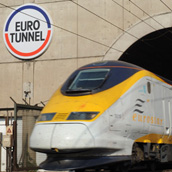
Eurotunnel celebrates 300 million passengers through the Channel Tunnel
29 Nov 2012
Today, Thursday 18 October 2012, Eurotunnel celebrates the arrival of the 300 millionth person to travel through the Channel Tunnel since the start of commercial services in June 1994, the equivalent to almost five times the population of the United Kingdom.
This considerable number includes passengers travelling by car and coach on board Le Shuttle, truck drivers and their companions travelling on the Freight Shuttles and also passengers travelling between London and Brussels or Paris via Eurostar. Since opening, 57% of these 300 million travelers have been customers of Eurotunnel’s
Shuttle Services, which link Folkestone, in Kent, to Coquelles, in the Pas-de-Calais, via the Channel Tunnel in just 35 minutes.
On average, since opening in 1994, almost 50,000 people travel through the Channel Tunnel, in complete safety, every day.
Jacques Gounon, Chairman and Chief Executive Officer of Groupe Eurotunnel SA, stated:
“The Channel Tunnel is a vital link between Great Britain and the continent which has revolutionized transport behavior. This unique piece of infrastructure has created a market which could not have existed if it had not been built and has, as a result, made a significant contribution to economic development”.
Press release of Eurotunnel Group, 18 October 2012

FS Italiane: Italferr and the new high-speed railway station in Casablanca
28 Nov 2012
The “Casa Voyageur”, the new high-speed railway station in Casablanca will carry the signature of Italferr (Gruppo FS). In this way Italferr is set to strengthen its presence in North Africa, where Gruppo Ferrovie dello Stato Italiane (Italian State Railways Group) has already been operating for a number of years, in Egypt and in Algeria, providing numerous technical assistance services.
Italferr, the engineering company belonging to Gruppo FS, will be assisted in its work to design the new station by Favero & Milan Ingegneria S.p.A., the architect Yassir Khalil and the ABDR Architetti Associati practice (winners of the project to design the new high-speed Tiburtina station in Rome). The project was presented in Rabat a month ago to the Jury chaired by Mohammed Rabie Khlie, Managing Director of the ONCF Railways (Office National des Chemins de Fer) and by Benjelloun Azerlarab, President of the Ordre National des Architectes du Maroc (Moroccan National Order of Architects).
Numerous big names in international engineering and architecture took part in the design competition launched by ONCF. From the French AREP practice (designers of the new high-speed station of Torino Porta Susa not to mention many other high-speed stations in France), to the German group GMP (designers of the new stadia built in Ukraine for the Euro2012 football championship) and the British company Chapman Taylor (designers of the London St. Pancras station and the new airport in Dubai).
“Casa Voyageur” will serve approximately 22 million passengers a year (compared to the current figure of 4.5 m) and will offer numerous commercial facilities thanks to the future multiservice pole. Suspended 19 metres above the track, it will have a covered surface area of 14,000 m² joined to the current building dating back to the colonial period. Linked to the centre of the city by the new urban tram service, the new station will represent an important opportunity for urban requalification by joining together two districts of the city which at present are divided by the railway line.
The new high-speed station in Casablanca will be part of the project to build the new Casablanca – Rabat – Kenitra – Tangier high-speed line. An infrastructure which is being financed mainly by the French government, with some funds coming from the Arabian peninsula, and which the King of Morocco, Mohammed VI is keen to see realized. It represents an important step forward in the overall project to modernize the country which is already underway with the construction of the Port of Tangier and aims to support plans to build a tunnel under the Strait of Gibraltar. With the Casablanca, Rabat, Kenitra and Tangier line, the European network of high-speed lines will have a southern branch which will extend as far as Casablanca, the first high-speed station on the African continent and a doorway onto a metropolis of over 4 million inhabitants.
Italferr is also strengthening its orders portfolio in the Balkans. Italferr sealed a contract in Albania for the feasibility study of the multimodal station in Tirana. Italferr received this new commission from the Albanian capital’s Municipal Council, with the financial support of the European Bank for Reconstruction and Development.
The contract was signed in Tirana by the Managing Director of Italferr, Renato Casale (representing the group formed by Italferr and the local practices CMS Adonnino Ascoli & Cavasola Scamoni and A&B Business Consulting) and the Mayor of Tirana, Lulzim Basha. With the award of this important commission, Italferr is strengthening its orders portfolio in the western Balkans where it is already working on various projects realized on behalf of the EU, the EBRD and the EIB and where new calls for tenders involving railway engineering works are expected in the coming months.
Press Release by FS Italiane, 12 October 2012
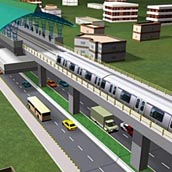
Hyundai Rotem to supply 57 trains for Hyderabad Metro Rail project
28 Sep 2012
Larsen & Toubro Metro Rail (Hyderabad) has awarded an Rs18bn ($324m) contract to South Korea-based Hyundai Rotem to supply 57 three-car trainsets for the Hyderabad Metro Rail project in India.
Hyundai Rotem secured the contract over the other three companies shortlisted by L&T, including Canada’s Bombardier, Spain’s CAF and China’s CSR.
Under the contract, the trains are expected to be delivered nine months before the 72km, three-line project’s first section opens, which is scheduled for between late 2014 and early 2015.
Construction work for the entire network is set to be completed in phases from late 2014 to 2017, with the finished network set to carry around 1.5 million passengers a day.
Upon completion, the three-line network will be served by Hyundai Rotem’s rolling stock, covering a distance of 71km and serving 66 stations.
The metro will be fully automatic and operated through a communications-based train controls system.
In May 2012, France-based Keolis won a contract from L&T Metro Rail to operate and maintain the Hyderabad project for eight years.
The contract included three years of consultancy and pre-operation, as well as an option to extend it for a further three years.
During the construction phase, Keolis will advise and assist L&T in building and reviewing the system’s design for efficient operation.
Source www.railway-technology.com , 14 September 2012
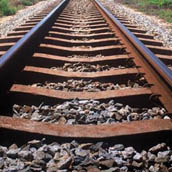
CSR Zhuzhou wins South African locomotive order
28 Sep 2012
CSR Zhuzhou Electric Locomotive has won a 2⋅54bn yuan contract to supply dual-voltage electric freight locomotives to Transnet from late 2013, beating eight other domestic and international bidders.
The four-axle 3⋅1 MW general freight locomotives will have a top speed of 100 km/h, equipped to work under 3 kV DC and 25 kV 50 Hz electrification.
CSR Zhuzhou said the deal announced on September 11 is its first contract to supply electric locomotives to Africa, and one of the largest locomotive export orders to be won by a Chinese firm. The company sees Africa as an important market, especially South Africa where more than 55% of Transnet’s 2 100 electric locomotives are over 35 years old.
The Transnet contract includes local production requirements, with the first locomotives to have 60% South African content. CSR Zhuzhou has invested in the development of 1 067 mm gauge bogies and dual-voltage technology, and sees South Africa as a possible base for supplying customers across southern Africa. It is also seeking to enter the electric multiple-unit market.
Source: www.railwaygazette.com, 12 September 2012

Ansaldo STS awarded new EUR 65 million contract in Australia
28 Sep 2012
Ansaldo STS to deliver signalling, communications and train control systems for critical heavy haul rail duplication project in the Pilbara
Ansaldo STS (STS.MI), a Finmeccanica Company, through its subsidiary Ansaldo STS Australia, has been awarded a new EUR 65.1 million (A$ 80.2 million) contract to deliver the signalling, communications and transmission systems for Rio Tinto’s critical heavy haul Rail Capacity Enhancement Project 353 (RCE353) for its Pilbara operations.
When completed the railway duplication, extending from Emu siding to the port at Cape Lambert, will contribute to Rio Tinto’s objective of achieving an overall system capacity of 353 million tonnes of iron ore per annum in 2015.
The contract award is the latest in a series of Rio Tinto heavy haul rail projects awarded to Ansaldo STS Australia under the Rio Tinto – Ansaldo STS Framework Agreement (RAFA) established in November 2010.
Ansaldo STS Australia has been designing and delivering signalling and communications solutions for heavy haul mining railways for more than 15 years. The company employs 700 people across Australia and has offices in Brisbane, Newcastle, Sydney, Perth and Karratha.
Press Release of Ansaldo STS, 10 September 2012
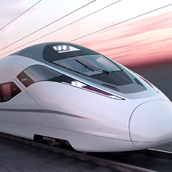
Bombardier Sifang signs variation contract for high speed trains in China
28 Sep 2012
Rail technology leader Bombardier Transportation announced today that its Chinese joint venture, Bombardier Sifang (Qingdao) Transportation Ltd., has been awarded a variation order by the Chinese Ministry of Railways (MOR).
After reviewing its operational strategy, the MOR decided to vary its original order of 80 very high speed trains from 2009 to include 70 eight-car BOMBARDIER ZEFIRO 380 trains, 46 ZEFIRO 250 stainless steel trains and 60 ZEFIRO 250NG trains. This variation provides MOR with increased flexibility in delivering its passenger services. The original contract value from 2009 remains unchanged.
The 70 ZEFIRO 380 trains are Bombardier’s most technologically advanced rail vehicles built to date. Designed to operate at speeds of up to 380 km/h, the trains incorporate industry-leading technical solutions in aerodynamics, propulsion and bogies. The new BOMBARDIER FLEXX Speed bogie has been developed especially for this VHS application. The trains are powered by the highly energy efficient BOMBARDIER MITRAC propulsion and control system and incorporate energy-saving BOMBARDIER ECO4 technologies that deliver the lowest energy consumption per seat of any VHS train in the world today.
The proven ZEFIRO 250 train is already operating in various parts of China. An existing fleet of 115 trains, 1,200 cars in total is currently in service.
The ZEFIRO 250NG is a newly developed product designed to meet the future demands of the Chinese rail market. An evolution of the ZEFIRO 250 train, it features numerous technological advances to ensure Bombardier’s competitiveness in this rapidly expanding market. These include a new aluminium carbody to reduce weight and ensure passenger comfort at high speeds as well as an enhanced propulsion system to guarantee performance and reliability. With optimized aerodynamics and energy efficient operation the ZEFIRO 250NG follows the same approach as the faster version ZEFIRO 380.
Anders Lindberg, President Mainline and Metros, Bombardier Transportation said: “This variation order supports the global strategic shift towards rail as the backbone of national transportation infrastructure. Our ZEFIRO family of high speed trains plays a crucial role in China’s development of a fully interconnected transport system that eases congestion and boosts the economy.”
Jianwei Zhang, President of Bombardier China, added: “China has a clear vision of the role the world’s largest high speed rail network will play in supporting sustainable transportation for the 21st century. The country is selecting the most advanced technologies to build a network that offers not only high speed but also unprecedented operating efficiency, reliability and capacity.”
Source www.europeanrailwayreview.com, 5 September 2012 and photographs from Bombardier archive
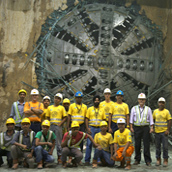
ALPINE completes first Singapore Downtown Line subway tunnel
28 Sep 2012
The Austrian ALPINE Construction Company completed the first of six subway tunnels for the Downtown Line in the center of Singapore, a city with a population of five million. ALPINE’s tunnel drill recently achieved a performance of 93 meters per week drilling a tube with a diameter of 6.6 meters through the underground between the “Tan Kah Dee” and “Sixth Avenue” stations, a considerable speed considering the difficult soil conditions. ALPINE is using employees from 17 nations and five tunnel drills simultaneously to complete the 400-million-euro contract awarded by the Singapore Land Authority.
ALPINE has been active in Singapore for nine years. Between 2003 and 2010 the first major projects for the Land Transport Authority were completed, providing 12 kilometers of subway tunnel and four subway stations (Serangoon, Holland Village, Buona Vista, Kent Ridge) for the Metro Circle Line.
The Austrian ALPINE Construction Company is a member of the FCC Group and has built roads, motorways, power plants, stadiums, railways and subways, bridges, residential, commercial and industrial buildings around the world. Together with its subsidiary, ALPINE-ENERGIE, it promotes the construction and development of sustainable, alternative energies and energy networks. The revenue from construction services was over 3.6 billion euros in 2011. The FCC Group with its head office in Madrid operates in the public services, environmental services, infrastructure and renewable energies sector on an international scale. FCC has over 90,000 employees in more than 50 countries, generating sales of approx. 12 billion euros last year.
Press Release by Alpine, 10 September 2012
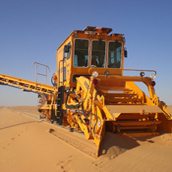
Track maintenance in the desert
28 Sep 2012
Plasser & Theurer has announced orders to supply a range of track maintenance and sand removal machines to Saudi Railway Co, Saudi Railways Organisation and two contractors.
North-South Railway developer SRA has bought four SRM 500 sand removal machines, three 08-16 SH levelling, lifting, lining and tamping machines, two DGS 90 N dynamic track stabilisers and three PBR 500 ballast regulating machines. The 08-16 SH, DGS 90 N and PBR 500 machines are to be deployed as a mechanised maintenance train, co-ordinating operation to maximise efficiency.
SRO has ordered two cyclic-action two-sleeper Duomatic 08-32 SH split-head tampers, as well as eight OBW 10 Sprinter track motor vehicles. These are suitable for transporting staff and materials, with a loading platform and crane.
SRO is buying two SRM 500 sand removal machines in co-operation with contractor Al-Mobty Co, which has also ordered a cyclic-action two-sleeper Unimat 08-32 4S tamper for tracks and turnouts that will enter service in 2013.
Meanwhile, contractor Saudi Archirodon has ordered an EM 120 track recording car equipped for corrugation measuring.
Source: www.railwaygazette.com, 31 August 2012
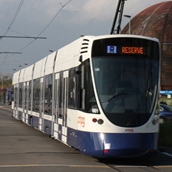
Supercap tram successfully in service
28 Sep 2012
The first supercap tram from Stadler Rail has been successfully in service for the Geneva transport company TPG since early July. The supercap energy-saving system allows braking energy to be stored during normal operation and reused when the vehicle starts to move in order to conserve energy. The energy stored in the supercaps allows the vehicle to travel at least 400 metres without mains power in an emergency situation. If driven economically, the distance can even be increased to over a kilometre.
The first few of a total of 32 Tango trams have been in regular service for Geneva-based TPG since December 2011. Of the 32 vehicles ordered, one was equipped as a prototype with the supercap energy-saving system. This system stores braking energy in condensers fitted to the roof of the vehicle. During regular service, this is fed back into the system when the vehicles start to move, i.e. when most energy is needed.
1,500 metres without power
In an emergency, the vehicle can even travel without mains power, for example, if there is a power failure or a fault with the contact wire or pantograph. During the first tests on 6 July, a vehicle covered a distance of 1,500 metres on a TPG depot circuit without mains power. This required economical driving, i.e. slow acceleration and low speed. Since then, the vehicle has been in service on the Geneva tram network and has performed excellently.
The supercap units on the TPG vehicle weigh about a tonne and can store energy equivalent to the entire kinetic energy of the empty vehicle at 55 km/h. The benefit of the supercaps over batteries is that they can absorb and release the temporarily very high levels of current produced during braking.
Retrofit option across whole series
The supercap prototype is being extensively tested by TPG and Stadler in conjunction with ABB, the manufacturer of the traction converters, on the TPG network, and its energy consumption is compared to that of the other Tangos, which also absorb braking energy and feed it back into the contact wires. If the tests prove positive, the remaining 31 series vehicles could be fitted with supercap modules relatively easily.
Press Release of Stadler Rail, 3 august 2012
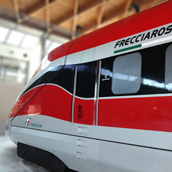
Frecciarossa 1000: the most spectacular train in the world
28 Sep 2012
Totally avant-garde technological solutions and record performance, a top design speed of 400 km/h, interoperability across the entire European high-speed rail network together with innovative design, comfort, quality and safety.
These are the plus points which make the Frecciarossa 1000 the most spectacular train in the world and the high-speed train of the 21st Century.
Frecciarossa 1000, the technological jewel destined to revolutionize the world of high-speed rail both on a national and European scale, is the fruit of the combined effort of the designers at AnsaldoBreda and Bombardier who, following the technical specifications provided by their client, Trenitalia (Gruppo FS Italiane – Italian State Railways), have enhanced the essence of Made in Italy, creating a train of unrivalled beauty and unparalleled performance.
Frecciarossa 1000 will be a bidirectional train incorporating a driver’s cabin at each end. It will incorporate multi-voltage traction so that it can operate using the different types of electrical power supplies found across the European network. It will be a fixed composition train, with engines and distributed power for improved adherence even in adverse weather conditions. It is designed to reach a record top speed of 400 km/h, with a starting acceleration of 0.7 m/s².
The distinguishing line of the nose will become associated with the unmistakable identity and personality of the Frecciarossa 1000, while at the same time meeting different requisites in terms of aerodynamics as well as safety and comfort for train drivers.
A diagnostics system will make it possible to monitor the operating status of all the on-board systems and each individual engine axle, providing continuous information for the staff on board the train, maintenance technicians and the rail operations control rooms, ensuring better management of any possible operating faults depending on the real conditions and performance of the train sets.
The aerodynamic design and the avant-garde solutions for energy savings, as well as guaranteeing unparalleled operational efficiency also ensure that the Frecciarossa 1000 will be in a position to boast more than one world record: in fact it is set to become the fastest ever mass-produced train in Europe as well as the quietest, with the least vibrations and lowest environmental impact in the world.
The reduction of aerodynamic resistance (the result of simulations and studies carried out in wind tunnels) limits energy consumption and noise levels; the use of light alloys to build the train cars and furnishings not only offers an excellent weight/power ration but also ensures that materials used to build the trains can be recycled at the end of their service life with minimum impact on the environment.
Frecciarossa 1000 will be the first European high-speed train offering the advantage of total interoperability.
Thanks to the innovative and highly sophisticated technical features it will be a multi-voltage train in compliance with the European Technical Specifications for Interoperability (TSI) and in fact, it will know no boundaries as it travels across the entire European High-Speed network (France, Germany, Spain, Austria, Switzerland, Holland and Belgium), overcoming limits of an infrastructural nature, in particular the differences in electrical power supplies and signaling systems. For this purpose, the driver’s cabin and the electronic island on the Frecciarossa 1000 have been designed and developed along modular lines which will allow for communication between the different technological systems installed in the various countries, above all making it possible to switch quickly and effectively from one technological set-up to another.
The signaling equipment on board the train will integrate the national management systems with systems unified at a European level, thus guaranteeing maximum operating safety alongside complete interoperability. In fact, the project takes into consideration the different “country software packages”, defining the modules which are common to all (Monitor Diagnostics, commands relative to train operation, ERTMS and Automatic Train Protection (ATP) Italy) and the elements which are specific to individual countries (such as national ATP and train schedule modules) installed on the train in easy to remove units on the driver’s control desk or in the special cabinets in the electronic island.
Not just speed, but also comfort, quality and safety. The bogies on the Frecciarossa 1000 are fitted with active suspension which, thanks to on-board compensation of high-speed centrifugal acceleration, offer maximum comfort to passengers. Tried and tested by means of mathematical models and simulations on test benches, it promises to be the most comfortable ride on these next generation high-speed train sets. All innovative solutions which provide system benefits not only for passengers but also for the service operator and manager of the infrastructure.
The design of the interiors has been studied to bring together elegance, comfort and functionality. Frecciarossa 1000 will allow passengers to choose from 4 different levels of service – Executive, Business, Premium and Standard – as well as offering a Meetings Room in Executive and “tête-à-tête areas” in Business and Premium class. It will also boast soundproofing, LED lighting, air-conditioning, refreshment services, easy access for persons with reduced mobility, on-board monitors and power sockets for PCs.
All designed with avant-garde solutions to offer an unparalleled level of comfort. In terms of spaciousness, aisle width, number of doors (for boarding/leaving the train) and ergonomics of the seating, they will be the best trains on the market. Executive class will offer the absolute maximum in terms of quality and comfort with 12 individual, reclining swivel armchairs allowing the user to choose the most comfortable position depending on the direction of travel or to create a lounge-type environment. For those on the other hand who wish to put peace and quiet at the top of their list of priorities, Business class has a designated Quiet Area for passengers.
In terms of Wi-Fi connectivity, the Frecciarossa 1000 will be fitted with the most modern and up-to-date IT systems with new web and multimedia technologies which can be enjoyed in real time anywhere along the route.
Press Release by FS Ferrovie Italiane, 19 August 2012
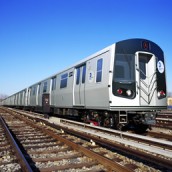
Bombardier to Supply 300 New Subway Cars for New York City Transit
10 Jul 2012
Bombardier continues its long lasting relationship with NYCT.
Bombardier Transportation announced today that it has signed a contract for 300 subway cars with the Metropolitan Transportation Authority (MTA) to be delivered to New York City Transit (NYCT). The order is valued at approximately $599 million US ($623 million CDN, 482 million euro). The MTA Board of Directors approved the award of a contract to Bombardier on March 28, 2012.
The new cars (known as the R179 series) will be built at Bombardier’s fully-integrated manufacturing plant in Plattsburgh, New York. The Plattsburgh facility is located in New York State’s North Country region and is Bombardier’s Centre of Excellence for rolling stock production in the United States. In operation since 1995, it has produced more than 3,000 passenger rail cars and locomotives now in service across the United States.
The R179 cars will incorporate state-of-the-art technology from Bombardier. The cars will be powered by highly reliable BOMBARDIER MITRAC propulsion equipment with new, energy-efficient inverters. The cars’ onboard systems will be integrated by Bombardier’s industry-leading MITRAC train control and management system with internet protocol technology. The propulsion and control equipment will be supplied by Bombardier’s Propulsion and Controls business unit in Pittsburgh, Pennsylvania.
Delivery of 10 pilot cars is scheduled to take place in the third quarter of 2014, followed by delivery of the remaining production series cars between mid-2015 and early 2017.
Raymond Bachant, President, Bombardier Transportation North America, said: “Bombardier’s partnership with NYCT began in 1982 with an order for 825 subway cars. Since then, we have delivered close to 1,900 vehicles to our valued customer. We are proud that NYCT has shown its confidence in our products and technologies once again, and we look forward to providing high quality, reliable, safe rail cars for the millions of people who ride New York’s subway system every day.”
Bombardier has redefined the future of mass transit travel. Around the world, more than seven billion people use Bombardier subway cars every year, from Boston, New York, Montreal, Toronto and Mexico City to London, Paris, Berlin, Delhi and Shanghai. Bombardier’s current North American orders include 706 new subway cars for Chicago, 468 cars for Montreal, and 420 cars for Toronto.
NYCT – one of six operating agencies that make up the Metropolitan Transportation Authority of New York – is the largest public transportation agency in North America and one of the largest in the world. The subway has a daily ridership of more than five million people, and an annual ridership close to 1.6 billion people. Its fleet of 6,380 subway cars travels almost 345 million miles a year along 660 miles of track, 24 hours a day, seven days a week.
Press Release of Bombardier, 4 June 2012
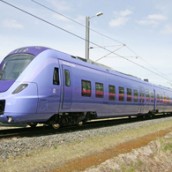
Alstom will supply 46 additional Coradia Nordic regional trains to the Swedish operator Storstockholms Lokaltrafik
10 Jul 2012
Alstom Transport has received an order from the Swedish Public Transport Authority AB Storstockholms Lokaltrafik (SL) for 46 new Coradia Nordic regional trains. This order worth €440 million is part of a frame agreement signed in 2002 between Alstom and SL. It brings the total number of Coradia Nordic trains ordered by SL to 129.
This order will allow SL to replace a part of its aging fleet and extend its network. Alstom will start to deliver the 46 trains to serve the lines of the greater Stockholm area in 2016.
“This new order from SL is a strong sign of trust and confidence in Alstom Transport’s know-how and solutions to secure a sustainable public transport service for the city of Stockholm,” said Henrik Anderberg, Managing Director of Alstom Transport in Sweden.
“We are convinced that the arrival of new and modern train sets in the commuter train network of the greater Stockholm area will contribute to increase our competitiveness and provide a higher level of customer satisfaction”, commented Anders Lindström Vice President of SL.
Coradia Nordic is an EMU-type (Electric Multiple Unit), six-car, regional train that can run at a speed of 160 km per hour. The train designed for SL will be equipped with the latest ERTMS1 signaling technology and meet all the latest interoperability requirements. Its distributed power optimizes the braking and acceleration of each carriage reducing energy use. With an approximately 95% rate of recyclability, the train is environmentally friendly. Built to stand up to rigorous winter conditions, operating at -35% C, Alstom Coradia Nordic regional train is particularly well-suited to Scandinavian climates.
Coradia Nordic regional train is designed to meet all passengers’ requirements in respect of comfort, access and mobility. Its lower floors and absence of steps facilitate access to passengers, especially those with reduced mobility. With roof-mounted traction equipment, the train offers larger space for comfortable seating.
Coradia Nordic regional trains for SL will be manufactured in Alstom’s centre of excellence for regional trains in Salzgitter in Germany. Since 2002, Alstom has sold 239 Coradia Nordic regional trains in Sweden.
1 – ERTMS: European Rail Traffic Management System is a system for the management and control of the rail traffic on the lines of Trans-European Networks
Press Release by Alstom, 15 June 2012
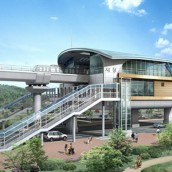
South Korea to open driverless Uijeongbu LRT line in July
10 Jul 2012
Uijeongbu Light Rail Transit (LRT) will open its driverless line to the public in Uijeongbu city north of Seoul, South Korea, on 1 July.
Once the 11.1km line becomes operational, it will be served by 15 stations that took five years to build and cost KRW547bn ($475m).
Out of the total cost, KRW297.4bn ($258.4m) came from the South Korean consortium led by GS Engineering & Construction, while the remaining KRW249.6bn ($216.9m) was received from taxes.
According to the South Korea’s National Assembly Research Service (NARS) the rubber-wheeled LRT system will cost Uijeongbu city’s taxpayers KRW10bn ($8.6m) a year over the next ten years.
Uijeongbu LRT vice president Lee Myung-se told AFP: “Unlike other LRTs, there will be enough demand as it passes through the most populated areas and carries commuters fast to a station where they can transfer to the main subway line linked to Seoul.”
In November 2006, Siemens Transportation Systems (TS) won a €140m contract from Uijeongbu LRT to install a fully automatic Val metro system in Uijeongbu, South Korea.
Source www.railway-technology.com, 21 June 2012
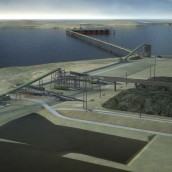
Abigroup secures Wiggins Island Rail Project Balloon
10 Jul 2012
Abigroup has been awarded a $76 million contract from QR National to undertake the civil works for a 13km balloon rail loop for the new Wiggins Island Coal Export Terminal at the Port of Gladstone in Queensland.
The Wiggins Island Balloon Loop (Segment 1) project involves carrying out the earthworks and drainage for the rail balloon loop and includes two million m3 of fill, a creek diversion and environmental management. Abigroup already has a major presence on Wiggins Island being currently involved in a joint venture to build part of the Wiggins Island Coal Export Terminal.
Abigroup’s Queensland General Manager Mick O’Dwyer said, “This major new project for QR National builds on the increasing amount of resources based infrastructure work we are carrying out in the Gladstone area.
“We are already currently building part of the Wiggins Island Coal Export Terminal and recently we constructed 8kms of seawall bunds as part of the Port of Gladstone Western Basin expansion.”
Work is due to start shortly on the new rail balloon loop project which will form a key part of a new coal export supply chain for existing and future Queensland coal producers in the Surat and Bowen basins.
Press Release of Abigroup, 22 June 2012
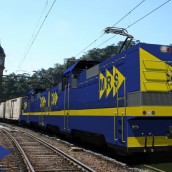
World record locomotive for Brazil
10 Jul 2012
Stadler Rail and the Brazilian company MRS Logística celebrate the unveiling of by far the largest and most powerful rack-and-pinion locomotive ever built. MRS ordered seven of these locomotives with a total value of around CHF 60 million (including reserve materials) from Stadler for the freight line from São Paulo to the Port of Santos. The first two vehicles will be transported to Brazil via Basel and Antwerp over the next few weeks. With this order, Stadler Rail has been able to demonstrate its innovative power and its leading global position in the construction of rack-and-pinion rail vehicles.
The seven powerful rack-and-pinion freight locomotives are needed by the large Brazilian cargo company MRS Logística S.A. primarily for heavy iron ore trains. The freight line from Sao Paulo to the Port of Santos is a 1,600-millimetre broad-gauge track with an approximately 10-kilometre long ramp, which is fitted with the Abt rack system. With a power of 5,000 kW, 760 kN tractive force at starting and a length of almost 19 metres per locomotive, these are the largest and most powerful rack-and-pinion locomotives ever built. Two of these locomotives in double traction will have a towing capacity of maximum 850 tonnes on the 104‰ ramps, making them 50% more powerful than those currently in use.
Peter Spuhler, owner and CEO of Stadler Rail Group, is delighted with the successful construction of these unique locomotives: “We are proud to have built the world’s most powerful rack-and-pinion locomotive. Thanks to our experienced engineering team, we are in a position to offer every customer tailor-made solutions.”
The four-axle locomotives have two bogies, which in turn each have two pinion transmission systems engaging with the triple-lamella Abt rack. Support is provided by two separate adhesion transmission systems, which contribute about 25% of the traction as the train goes uphill. The regenerative ability of modern traction equipment also enables massive energy savings to be made on the 3 kV DC line.
Press Release of Stadler, 6 June 2012
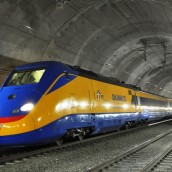
Dia.man.te, the new diagnostic train operating for Rete Ferroviaria Italiana
10 Jul 2012
Dia.Man.Te (an acronym for Diagnostica e Manutenzione Tecnologica – Technological Diagnostics and Maintenance) is the new diagnostic train operating for Rete Ferroviaria Italiana (Gruppo FS – Italian Rail Network), specifically designed to work on high-speed lines.
The latest model in a long line diagnostic trains, the Dia.Man.Te. is the first rolling stock in the world capable of measuring the state of rail infrastructure while travelling at 300 km/h.
Moment by moment the diagnostic train checks 200 parameters relative to:
superstructure (track and ballast),
power supply (overhead line),
signalling (ERTMS – European Railway Traffic Management System),
telecommunications (GSM-R radio system).
The diagnostic systems installed on board the Dia.Man.Te. are the result of made-in-Italy innovation. The concept and operational design are all the work of RFI (Rete Ferroviaria Italiana).
THE FLEET OF DIAGNOSTIC TRAINS
Archimede, in service since 2003, is an extraordinary and innovative concentrated package of technology capable of continuously measuring 119 different parameters which, when integrated with one another, make it possible to check the state of the railway infrastructure in real time.
The diagnostic train for track measurement, the Galileo, has been in service since 1997, using ultrasound and digital video-inspection technology to check the state of the rails.
Talete, on the other hand is dedicated to inspecting track geometry, accelerations and wear of the rails. It measures all the alignment and rail level values using laser optical triangulation and gyroscopes.
Caronte is the motor train unit dedicated to diagnostic operations on lines equipped with SCMT (Sistema Controllo Marcia Treni—Train Running Control System) and SSC (Sistema Supporto Condotta—Driver Support System). Furthermore it is the first rolling stock in the world which certifies signalling in accordance with European standards.
Euclide brings together all the characteristics of the three trains described above, using optical laser technology. In particular it is used to measure the undulatory wear of the rails.
Aldebaran on the other hand is specifically designed for mobile diagnostics of the electrical systems. This is a special carriage which was the first ever to use laser technology for measuring all the parameters for overhead lines and the interaction between the pantograph and the power cables.
Fifteen traction units fitted with special equipment for detecting track geometry and a series of portable trolleys used to check the geometric parameters of switches complete the fleet.
Press Release by FS Ferrovie Italiane, 9 June 2012
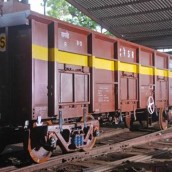
Besco secures order for 250 rail wagons from Indian Railways
10 Jul 2012
Indian railway equipment manufacturer Besco has won an order from Indian Railways (IR) for the supply of 250 G105-standard high-capacity wagons.
In addition, Besco’s foundry division, which produces freight car bogies and couplers, has opened a new wagon manufacturing facility at its 14-acre factory in Baruipur, West Bengal, India. About INR1.2bn ($21.6m) has already been invested in the facility, which will have an annual production capacity of 3,000 wagons.
The company said that the new plant features a robotic welding facility for wagon sub-assemblies and automatic paint booths to offer higher quality and improved productivity.
Besco is also planning to invest an additional INR2bn ($36m) in its new Baruipur plant to increase wagon production to around 5,000 units by 2015. Besco director Siddharth Tantia told Telegraph India that there is a demand for an estimated 30,000 wagons per year and, with the dedicated freight corridor coming up, a tremendous growth opportunity is expected.
“Baruipur was the first unit to follow the G105 standard of wagon manufacturing prescribed by the Research Design and Standards Organisation of the railway ministry,” Tantia said. Besco currently exports almost 15% of its railway equipment production to Brazil and China.
“We are exploring new opportunities in Russia for exporting freight car bogies and couplers,” Tantia added.
Source www.railway-technology.com, 11 June 2012